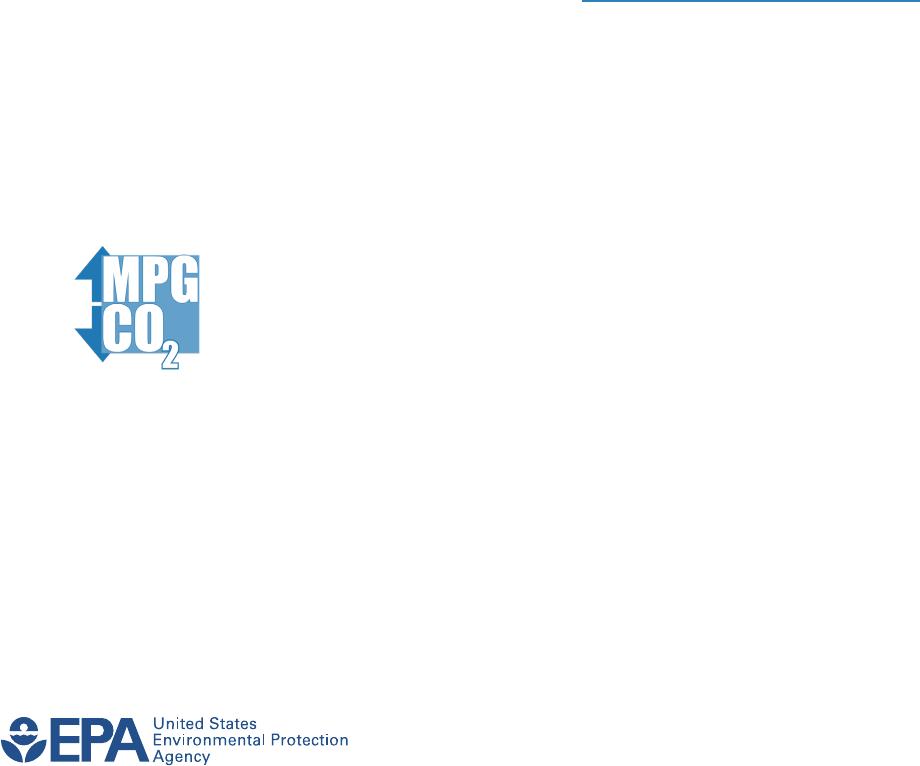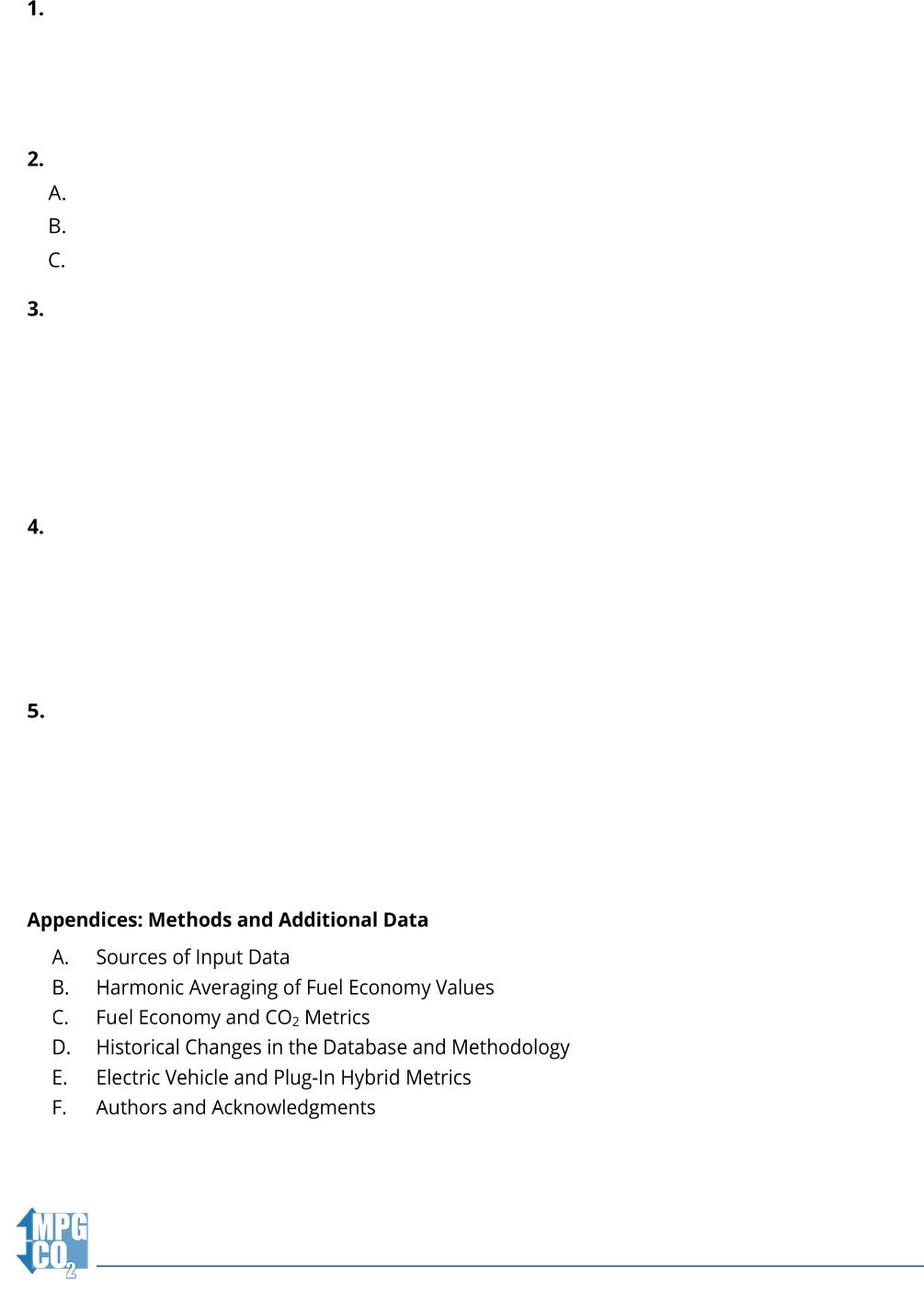The2022EPAAutomotiveTrendsReportGreenhouseGasEmissions,FuelEconomy,andTechnologysince1975EA~~ftUnitedStatesEnvironmentalProtection,,.,AgencyEPA-420-R-22-029December2022ThistechnicalreportdoesnotnecessarilyrepresentfinalEPAdecisions,positions,orvalidationofcompliancedatareportedtoEPAbymanufacturers.Itisintendedtopresenttechnicalanalysisofissuesusingdatathatarecurrentlyavailableandthatmaybesubjecttochange.Historicdatahavebeenadjusted,whenappropriate,toreflecttheresultofcomplianceinvestigationsbyEPAoranyothercorrectionsnecessarytomaintaindataintegrity.Thepurposeofthereleaseofsuchreportsistofacilitatetheexchangeoftechnicalinformationandtoinformthepublicoftechnicaldevelopments.Thiseditionofthereportsupersedesallpreviousversions.•-------TableofContents1.Introduction..................................................................................................................................1A.What’sNewThisYear............................................................................................................................1B.ManufacturersinthisReport...............................................................................................................2C.FuelEconomyandCO2MetricsinthisReport...................................................................................32.FleetwideTrendsOverview.........................................................................................................5A.OverallFuelEconomyandCO2Trends...............................................................................................5B.ProductionTrends.................................................................................................................................8C.ManufacturerFuelEconomyandCO2Emissions..............................................................................93.VehicleAttributes.......................................................................................................................14A.VehicleClassandType........................................................................................................................14B.VehicleWeight......................................................................................................................................20C.VehiclePower.......................................................................................................................................24D.VehicleFootprint..................................................................................................................................29E.VehicleTypeandAttributeTradeoffs................................................................................................324.VehicleTechnology.....................................................................................................................39A.TechnologyOverview..........................................................................................................................39B.VehiclePropulsion...............................................................................................................................42C.VehicleDrivetrain.................................................................................................................................64D.TechnologyAdoption..........................................................................................................................695.ManufacturerGHGCompliance................................................................................................78A.Footprint-BasedCO2Standards.........................................................................................................80B.ModelYearPerformance....................................................................................................................83C.GHGProgramCreditsandDeficits.................................................................................................109D.EndofYearGHGProgramCreditBalances...................................................................................119Appendices:MethodsandAdditionalDataA.SourcesofInputDataB.HarmonicAveragingofFuelEconomyValuesC.FuelEconomyandCO2MetricsD.HistoricalChangesintheDatabaseandMethodologyE.ElectricVehicleandPlug-InHybridMetricsF.AuthorsandAcknowledgments-------iListofFiguresFigure2.1.EstimatedReal-WorldFuelEconomyandCO2Emissions.........................................................5Figure2.2.TrendsinFuelEconomyandCO2EmissionsSinceModelYear1975......................................6Figure2.3.DistributionofNewVehicleCO2EmissionsbyModelYear......................................................7Figure2.4.NewVehicleProductionbyModelYear.......................................................................................9Figure2.5.ChangesinEstimatedReal-WorldFuelEconomyandCO2EmissionsbyManufacturer.....10Figure3.1.RegulatoryClassesandVehicleTypesUsedinThisReport....................................................15Figure3.2.ProductionShareandEstimatedReal-WorldFuelEconomy..................................................16Figure3.3.VehicleTypeDistributionbyManufacturerforModelYear2021..........................................17Figure3.4.Car-TruckClassificationofSUVswithInertiaWeightsof4000PoundsorLess...................18Figure3.5.AverageNewVehicleWeightbyVehicleType...........................................................................21Figure3.6.InertiaWeightClassDistributionbyModelYear......................................................................22Figure3.7.RelationshipofInertiaWeightandCO2Emissions...................................................................23Figure3.8.AverageNewVehicleHorsepowerbyVehicleType.................................................................25Figure3.9.HorsepowerDistributionbyModelYear...................................................................................26Figure3.10.RelationshipofHorsepowerandCO2Emissions....................................................................27Figure3.11.Calculated0-to-60TimebyVehicleType.................................................................................28Figure3.12.FootprintbyVehicleTypeforModelYear2008–2021...........................................................30Figure3.13.FootprintDistributionbyModelYear......................................................................................30Figure3.14.RelationshipofFootprintandCO2Emissions.........................................................................31Figure3.15.RelativeChangeinFuelEconomy,Weight,Horsepower,andFootprint.............................33Figure4.1.VehicleEnergyFlow......................................................................................................................39Figure4.2.ManufacturerUseofEmergingTechnologiesforModelYear2021......................................41Figure4.3.ProductionSharebyEngineTechnology...................................................................................43Figure4.4.GasolineEngineProductionSharebyNumberofCylinders..................................................45Figure4.5.PercentChangeforSpecificGasolineEngineMetrics.............................................................47Figure4.6.EngineMetricsforDifferentGasolineTechnologyPackages.................................................49Figure4.7.GasolineTurboEngineProductionSharebyVehicleType.....................................................51Figure4.8.GasolineTurboEngineProductionSharebyNumberofCylinders.......................................51Figure4.9.DistributionofGasolineTurboVehiclesbyDisplacementandHorsepower,ModelYear2011,2014,and2021..............................................................................................................................52Figure4.10.Non-HybridStop/StartProductionSharebyVehicleType....................................................54Figure4.11.Non-HybridStop/StartProductionSharebyNumberofCylinders.....................................54Figure4.12.GasolineHybridEngineProductionSharebyVehicleType..................................................55Figure4.13.GasolineHybridEngineProductionSharebyNumberofCylinders...................................55Figure4.14.ProductionShareofEVs,PHEVs,andFCVs.............................................................................58Figure4.15.ElectricVehicleProductionSharebyVehicleType.................................................................59Figure4.16.Plug-InHybridVehicleProductionSharebyVehicleType....................................................59Figure4.17.ChargeDepletingRangeandFuelEconomyforEVsandPHEVs..........................................60Figure4.18.DieselEngineProductionSharebyVehicleType...................................................................62-------iiFigure4.19.DieselEngineProductionSharebyNumberofCylinders.....................................................62Figure4.20.PercentChangeforSpecificDieselEngineMetrics................................................................63Figure4.21.TransmissionProductionShare................................................................................................66Figure4.22.AverageNumberofTransmissionGears................................................................................67Figure4.23.ComparisonofManualandAutomaticTransmissionReal-WorldFuelEconomyforComparableVehicles...............................................................................................................................68Figure4.24.Front-,Rear-,andFour-WheelDriveProductionShare.........................................................69Figure4.25.Industry-WideCarTechnologyPenetrationafterFirstSignificantUse...............................71Figure4.26.ManufacturerSpecificTechnologyAdoptionoverTimeforKeyTechnologies..................73Figure5.1.TheGHGComplianceProcess.....................................................................................................78Figure5.2.2012–2021ModelYearCO2FootprintTargetCurves..............................................................80Figure5.3.Changesin2-CycleTailpipeCO2EmissionsbyManufacturer................................................85Figure5.4.ModelYear2021ProductionofEVs,PHEVs,andFCVs............................................................88Figure5.5.ModelYear2021AdvancedTechnologyCreditsbyManufacturer........................................88Figure5.6.HFO-1234yfAdoptionbyManufacturer....................................................................................91Figure5.7.FleetwideA/CCreditsbyCreditType.........................................................................................93Figure5.8.TotalA/CCreditsbyManufacturerforModelYear2021........................................................93Figure5.9.Off-CycleMenuTechnologyAdoptionbyManufacturer,ModelYear2021.........................95Figure5.10.TotalOff-CycleCreditsbyManufacturerforModelYear2021.........................................104Figure5.11.PerformanceandStandardsbyManufacturer,ModelYear2021....................................110Figure5.12.EarlyCreditsbyManufacturer...............................................................................................116Figure5.13.TotalCreditsTransactions......................................................................................................119Figure5.14.ManufacturerCreditBalanceAfterModelYear2021.........................................................122Figure5.15.IndustryPerformanceandStandards,CreditGenerationandUse..................................126ListofTablesTable1.1.ModelYear2021ManufacturerDefinitions.................................................................................3Table1.2.FuelEconomyandCO2MetricsUsedinthisReport....................................................................4Table2.1.Production,EstimatedReal-WorldCO2,andFuelEconomyforModelYear1975–2022......11Table2.2.ManufacturersandVehicleswiththeHighestFuelEconomy,byYear...................................12Table2.3.ManufacturerEstimatedReal-WorldFuelEconomyandCO2EmissionsforModelYear2020–2022.................................................................................................................................................13Table3.1.VehicleAttributesbyModelYear.................................................................................................34Table3.2.EstimatedReal-WorldFuelEconomyandCO2byVehicleType...............................................35Table3.3.ModelYear2021VehicleAttributesbyManufacturer..............................................................36Table3.4.ModelYear2021EstimatedReal-WorldFuelEconomyandCO2byManufacturerandVehicleType..............................................................................................................................................37Table3.5.FootprintbyManufacturerforModelYear2020–2022(ft2).....................................................38Table4.1.ProductionSharebyPowertrain..................................................................................................74-------iiiTable4.2.ProductionSharebyEngineTechnologies.................................................................................75Table4.3.ProductionSharebyTransmissionTechnologies......................................................................76Table4.4.ProductionSharebyDriveTechnology.......................................................................................77Table5.1.ManufacturerFootprintandStandardsforModelYear2021.................................................82Table5.2.ProductionMultipliersbyModelYear.........................................................................................87Table5.3.ModelYear2021Off-CycleTechnologyCreditsfromtheMenu,byManufacturerandTechnology(g/mi)..................................................................................................................................100Table5.4.ModelYear2021Off-CycleTechnologyCreditsfromanAlternativeMethodology,byManufacturerandTechnology(g/mi).................................................................................................103Table5.5.ManufacturerPerformanceinModelYear2021,All(g/mi)...................................................106Table5.6.IndustryPerformancebyModelYear,All(g/mi).....................................................................106Table5.7.ManufacturerPerformanceinModelYear2021,Car(g/mi).................................................107Table5.8.IndustryPerformancebyModelYear,Car(g/mi)...................................................................107Table5.9.ManufacturerPerformanceinModelYear2021,Truck(g/mi).............................................108Table5.10.IndustryPerformancebyModelYear,Truck(g/mi)..............................................................108Table5.11.CreditsEarnedbyManufacturersinModelYear2021,All..................................................112Table5.12.TotalCreditsEarnedinModelYears2009–2021,All............................................................112Table5.13.CreditsEarnedbyManufacturersinModelYear2021,Car................................................113Table5.14.TotalCreditsEarnedinModelYears2009–2021,Car..........................................................113Table5.15.CreditsEarnedbyManufacturersinModelYear2021,Truck............................................114Table5.16.TotalCreditsEarnedinModelYears2009–2021,Truck......................................................114Table5.17CreditExpirationSchedule........................................................................................................117Table5.18.ExampleofaDeficitOffsetwithCreditsfromPreviousModelYears................................120Table5.19.FinalCreditBalancebyManufacturerforModelYear2021(Mg)......................................123Table5.20.DistributionofCreditsbyExpirationDate(Mg)....................................................................124-------iv1.IntroductionThisannualreportispartoftheU.S.EnvironmentalProtectionAgency’s(EPA)commitmenttoprovidethepublicwithinformationaboutnewlight-dutyvehiclegreenhousegas(GHG)emissions,fueleconomy,technologydata,andautomanufacturers'performanceinmeetingtheagency’sGHGemissionsstandards.EPAhascollecteddataoneverynewlight-dutyvehiclemodelsoldintheUnitedStatessince1975,eitherfromtestingperformedbyEPAattheNationalVehicleFuelandEmissionsLaboratoryinAnnArbor,Michigan,ordirectlyfrommanufacturersusingofficialEPAtestprocedures.Thesedataarecollectedtosupportseveralimportantnationalprograms,includingEPAcriteriapollutantandGHGstandards,theU.S.DepartmentofTransportation’sNationalHighwayTrafficSafetyAdministration(NHTSA)CorporateAverageFuelEconomy(CAFE)standards,andvehicleFuelEconomyandEnvironmentlabels.ThisexpansivedatasetallowsEPAtoprovideauniquelycomprehensiveanalysisoftheautomotiveindustrysince1975.A.What’sNewThisYearThisreportisupdatedeachyeartoreflectthemostrecentdataavailabletoEPAforallmodelyears,relevantregulatorychanges,methodologychanges,andanyotherchangesrelevanttotheautoindustry.Thesechangescanaffectmultiplemodelyears;therefore,thisversionofthereportsupersedesallpreviousreports.Significantdevelopmentsrelevantforthiseditionofthereportinclude:•InDecember2021,EPAfinalizedrevisedlight-dutyGHGstandardsformodelyears2023-2026andinMarch2022NHTSAsubsequentlypublishedrevisedfueleconomystandardsformodelyears2024-2026.InMarch2022,EPAalsorestoredCalifornia’swaivertoenforcegreenhousegasstandardsforcarsandlighttrucks.Thisreporthasbeenupdatedtoreflectthesechangeswhererelevant.•Electricvehiclescontinuetoincreasemarketshareandareexpectedtocontinuegrowinginpopularity.Thetechnology,fueleconomy,andemissionsofelectricvehiclesarefundamentallydifferentthantheirinternalcombustioncounterparts.Increasingvehicleelectrificationmayrequirerethinkingmanyofthemetricsandmethodsusedinthisreport.Whilenosignificantchangesweremadethisyear,EPAisevaluatingthebestmetricsandmethodstoexplaintheseongoingtrendsandtechnologiesforfuturereports.-------1•Thisreportshowsprojectedmodelyear2022data,muchofwhichwasprovidedtoEPAbymanufacturersincalendaryear2021.GiventheimpactsofCOVID-19andongoingworldwidesupplychainissues,andtheirassociatedimpactsontheautomobileindustry,theprojectedmodelyear2022datamaychangesignificantlybeforebeingfinalized.•EPAcontinuestoupdatedetaileddatafromthisreport,includingallyearsofthelight-dutyGHGstandards,totheEPAAutomotiveTrendswebsite.Weencouragereaderstovisithttps://www.epa.gov/automotive-trendsandexplorethedata.EPAwillcontinuetoaddcontentandtoolsonthewebtoallowtransparentaccesstopublicdata.B.ManufacturersinthisReportTheunderlyingdataforthisreportincludeeverynewlight-dutyvehicleofferedforsaleintheUnitedStates.Thesedataarepresentedbymanufacturerthroughoutthisreport,usingmodelyear2021manufacturerdefinitionsdeterminedbyEPAandNHTSAforimplementationoftheGHGemissionstandardsandCAFEprogram.Forsimplicity,figuresandtablesintheexecutivesummaryandinSections1-4showonlythetop14manufacturers,byproduction.Thesemanufacturersproducedatleast150,000vehicleseachinthe2021modelyearandaccountedformorethan98%ofallproduction.ThecompliancediscussioninSection5includesallmanufacturers,regardlessofproductionvolume.Table1.1listsallmanufacturersthatproducedvehiclesintheU.S.formodelyear2021,includingtheirassociatedmakes,andtheircategorizationforthisreport.Onlyvehiclebrandsproducedinmodelyear2021areshowninthistable;however,thisreportcontainsdataonmanyothermanufacturersandbrandsthathaveproducedvehiclesforsaleintheU.S.since1975.WhenamanufacturergroupingchangesundertheGHGandCAFEprograms,EPAappliesthenewmanufacturerdefinitionstoallpriormodelyearsfortheanalysisofestimatedreal-worldCO2emissionandfueleconomytrendsinSections1through4ofthisreport.Thismaintainsconsistentmanufacturerandmakedefinitionsovertime,whichenablesbetteridentificationoflong-termtrends.However,thecompliancedatathatarediscussedinSection5ofthisreportmaintainthepreviousmanufacturerdefinitionswherenecessarytopreservetheintegrityofcompliancedataasaccrued.-------2Table1.1.ModelYear2021ManufacturerDefinitionsManufacturerLargeMakesintheU.S.MarketBMWManufacturersBMW,Mini,RollsRoyceFordGMOtherFord,Lincoln,Roush,ShelbyHondaManufacturersBuick,Cadillac,Chevrolet,GMCHyundaiKiaAcura,HondaMazdaGenesis,HyundaiMercedesNissanKiaStellantisMazdaSubaruMaybach,MercedesTeslaInfiniti,NissanToyotaAlfaRomeo,Chrysler,Dodge,Fiat,Jeep,Maserati,RamVolkswagen(VW)SubaruJaguarLandRoverMitsubishiTeslaVolvoLexus,ToyotaKarmaAudi,Bentley,Bugatti,Lamborghini,Porsche,VolkswagenAstonMartinJaguar,LandRoverFerrariMcLarenMitsubishiLotus,Polestar,VolvoSmallVolumeManufacturersKarmaAstonMartinFerrariMcLarenC.FuelEconomyandCO2MetricsinthisReportAlldatainthisreportformodelyears1975through2021arefinalandbasedonofficialdatasubmittedtoEPAandNHTSAaspartoftheregulatoryprocess.Insomecases,thisreportwillshowdataformodelyear2022,whicharepreliminaryandbasedondataprovidedtoEPAbyautomakerspriortothemodelyear,includingprojectedproductionvolumes.AlldatainthisreportarebasedonproductionvolumesdeliveredforsaleintheU.S.bymodelyear.Themodelyearproductionvolumesmayvaryfromotherpublicizeddatabasedoncalendaryearsales.Thereportdoesnotexaminefuturemodelyears,andpastperformancedoesnotnecessarilypredictfutureindustrytrends.Thecarbondioxide(CO2)emissionsandfueleconomydatainthisreportfallintooneoftwocategoriesbasedonthepurposeofthedataandthesubsequentrequiredemissionstestprocedures.Thefirstcategoryiscompliancedata,whichismeasuredusinglaboratory-------3testsrequiredbylawforCAFEandadoptedbyEPAforGHGcompliance.CompliancedataaremeasuredusingEPAcityandhighwaytestprocedures(the“2-cycle”tests),andfleetwideaveragesarecalculatedbyweightingthecityandhighwaytestresultsby55%and45%,respectively.Theseproceduresarerequiredforcompliance;however,theynolongeraccuratelyreflectreal-worlddriving.Compliancedatamayalsoencompassoptionalperformancecreditsandadjustmentsthatmanufacturerscanusetowardsmeetingtheiremissionsstandards.Thesecondcategoryisestimatedreal-worlddata,whichismeasuredusingadditionallaboratoryteststocaptureawiderrangeofoperatingconditions(includinghotandcoldweather,higherspeeds,andfasteraccelerations)encounteredbyanaveragedriver.Thisexpandedsetoftestsisreferredtoas“5-cycle”testing.Cityandhighwayresultsareweighted43%cityand57%highway,consistentwithfleetwidedriveractivitydata.Thecityandhighwayvaluesarethesamevaluesfoundonnewvehiclefueleconomylabels,howeverthelabelcombinedvalueisweighted55%cityand45%highway.Unlikecompliancedata,themethodforcalculatingreal-worlddatahasevolvedovertime,alongwithtechnologyanddrivinghabits.Table1.2.FuelEconomyandCO2MetricsUsedinthisReportCO2andFuelEconomyPurposeCurrentCurrentTestDataCategoryCity/HighwayBasisBasisformanufacturerCompliancecompliancewithstandardsWeighting2-cycle55%/45%EstimatedReal-WorldBestestimateofreal-world43%/57%5-cycleperformanceThisreportwillshowestimatedreal-worlddataexceptforthediscussionspecifictotheGHGregulationsinSection5andExecutiveSummaryFiguresES-6throughES-8.ThecomplianceCO2datamustnotbecomparedtothereal-worldCO2datapresentedelsewhereinthisreport.AppendicesCandDpresentamoredetaileddiscussionofthefueleconomyandCO2datausedinthisreport.ThisreportdoesnotprovidedataaboutNHTSA’sCAFEprogram.FormoreinformationaboutCAFEandmanufacturercompliancewiththeCAFEfueleconomystandards,seetheCAFEPublicInformationCenter,whichcanbeaccessedathttps://one.nhtsa.gov/cafe_pic/CAFE_PIC_Home.htm.-------4FleetwideTrendsOverviewNTheautomotiveindustrycontinuestomakeprogresstowardslowertailpipeCO2emissionsandhigherfueleconomyinrecentyears.Thissectionprovidesanupdateontheestimatedreal-worldtailpipeCO2emissionsandfueleconomyfortheoverallfleet,andformanufacturersbasedonfinalmodelyear2021data.Theunique,historicaldataonwhichthisreportisbasedalsoprovideanimportantbackdropforevaluatingthemorerecentperformanceoftheindustry.Usingthatdata,thissectionwillalsoexplorebasicfleetwidetrendsintheautomotiveindustrysinceEPAbegancollectingdatainmodelyear1975.■►OverallFuelEconomyandCO2TrendsInmodelyear2021,theaverageFigure2.1.EstimatedReal-Worldestimatedreal-worldCO2emissionFuelEconomyandCO2Emissionsrateforallnewvehiclesfellby2g/mito347g/mi,thelowesteverReal-WorldCO2Emissions(g/mi)600measured.Real-worldfueleconomyremainedatarecordhigh25.4500347g/mimpg.1MY2021Sincemodelyear2004,CO2400emissionshavedecreased25%,or114g/mi,andfueleconomyhas••increased32%,or6.1mpg.Overthattime,CO2emissionshaveReal-WorldFuelEconomy(MPG)24improvedinfourteenofseventeenyears.ThetrendsinCO2emissions2025.4MPGandfueleconomysince1975areshowninFigure2.1.MY2021PreliminarydatasuggestthatCO216emissionsandfueleconomyinmodelyear2022willimprovefrom197519851995200520152025thelevelsachievedin2021.Thepreliminarymodelyear2022dataModelYear1EPAgenerallyusesunroundedvaluestocalculatevaluesinthetext,figures,andtablesinthisreport.Thisapproachresultsinthemostaccuratedatabutmayleadtosmallapparentdiscrepanciesduetorounding.5&]arebasedonproductionestimatesprovidedtoEPAbymanufacturersmonthsbeforethevehiclesgoonsale.Thedataareausefulindicator,howeverthereisalwaysuncertaintyassociatedwithsuchprojections,andwecautionthereaderagainstfocusingonlyonthesedata.ProjecteddataareshowninFigure2.1asadotbecausethevaluesarebasedonmanufacturerprojectionsratherthanfinaldata.Whilethemostrecentannualchangesoftenreceivethemostpublicattention,thegreatestvalueoftheTrendsdatabaseistodocumentlong-termtrends.ThemagnitudeofchangesinannualCO2emissionsandfueleconomytendtobesmallrelativetolonger,multi-yeartrends.Figure2.2showsfleetwideestimatedreal-worldCO2emissionsandfueleconomyformodelyears1975–2021.Overthistimeframetherehavebeenthreebasicphases:1)arapidimprovementofCO2emissionsandfueleconomybetween1975and1987,2)aperiodofslowlyincreasingCO2emissionsanddecreasingfueleconomythrough2004,and3)decreasingCO2emissionsandincreasingfueleconomythroughthecurrentmodelyear.Figure2.2.TrendsinFuelEconomyandCO2EmissionsSinceModelYear1975E1988to20042005to2021---9-+14%-25%(/)600t'C·0oo.E(/)w5000"'0"C-;:::~400...!.row0:::G'25a..~>,E0C020(.)ww'1988to2004t-12%::::,2005to2021IL+32%~"C+68%19801985-;:::15...!.row0:::19751990199520002005201020152020ModelYear-------6VehicleCO2emissionsandfueleconomyareinverselyrelatedforgasolineanddieselvehicles,butnotforelectricvehicles.Sincegasolineanddieselvehicleshavemadeupthevastmajorityofvehicleproductionsince1975,Figure2.2showsaninverted,buthighlycorrelatedrelationshipbetweenCO2emissionsandfueleconomy.Electricvehicles,whichaccountforasmallbutgrowingportionofvehicleproduction,havezerotailpipeCO2emissions,regardlessoffueleconomy(asmeasuredinmilespergallonequivalent,ormpge).Ifelectricvehiclescontinuetocapturealargermarketshare,theoverallrelationshipbetweenfueleconomyandtailpipeCO2emissionswillchange.AnotherwaytolookatCO2emissionsovertimeistoexaminehowthedistributionofnewvehicleemissionrateshavechanged.Figure2.3showsthedistributionofreal-worldtailpipeCO2emissionsforallvehiclesproducedwithineachmodelyear.HalfofthevehiclesproducedeachyearareclusteredwithinasmallbandaroundthemedianCO2emissionrate,asshowninblue.Theremainingvehiclesshowamuchwiderspread,especiallyinrecentyearsastheproductionofelectricvehicleswithzerotailpipeemissionshasincreased.ThelowestCO2-emittingvehicleshaveallbeenhybridsorelectricvehiclessincethefirsthybridwasintroducedinmodelyear2000,whilethehighestCO2-emittingvehiclesaregenerallyperformancevehiclesorlargetrucks.Figure2.3.DistributionofNewVehicleCO2EmissionsbyModelYear2WorstVehicleReal-WorldCO2(g/mi)1000Worst5%Bottom25%50050%ofVehiclesBest5%Top25%BestVehicle019751980198519901995200020052010201520202025ModelYear2Electricvehiclespriorto2011arenotincludedinthisfigureduetolimiteddata.However,thosevehicleswere-availableinsmallnumbersonly.7Itisimportanttonotethatthemethodologyusedinthisreportforcalculatingestimatedreal-worldfueleconomyandCO2emissionvalueshaschangedovertimetoreflectchangingvehicletechnologyandoperation.Forexample,theestimatedreal-worldfueleconomyfora1980svehicleissomewhathigherthanitwouldbeifthesamevehiclewerebeingproducedtoday.Thesechangesaresmallformostvehicles,butlargerforveryhighfueleconomyvehicles.SeeAppendicesCandDforadetailedexplanationoffueleconomymetricsandtheirchangesovertime.B.ProductionTrendsThisreportisbasedonthetotalnumberofvehiclesproducedbymanufacturersforsaleintheUnitedStatesbymodelyear.Modelyearisthemanufacturer’sannualproductionperiodwhichincludesJanuary1ofthesamecalendaryear.Atypicalmodelyearforavehiclebeginsinfalloftheprecedingcalendaryearandrunsuntillateinthenextcalendaryear.However,modelyearsvaryamongmanufacturersandcanoccurbetweenJanurary2oftheprecedingcalendaryearandtheendofthecalendaryear.Modelyearproductiondataisthemostdirectwaytoanalyzeemissions,fueleconomy,technology,andcompliancetrendsbecausevehicledesignswithinamodelyeardonottypicallychange.Theuseofmodelyearproductionmayleadtosomeshort-termdiscrepencieswithothersources,whichtypicallyreportcalendaryearsales;however,salesbasedonthecalendaryeargenerallyencompassmorethanonemodelyear,whichcomplicatesanyanalysis.Sincetheinceptionofthisreport,productionofvehiclesforsaleintheUnitedStateshasgrownabout0.5%yearoveryear,buttherehavebeensignificantswingsupordowninanygivenmodelyearduetotheimpactofmultiplemarketforces.Forexample,inmodelyear2009theGreatRecessionresultedinthelowestmodelyearproductionsincethestartofthisreport,at9.3millionvehicles.Productionreboundedoverthenextseveralmodelyears,reachinganall-timehighofmorethan17millionvehiclesinmodelyear2017.Modelyear2020productionfell15%fromthepreviousyear,astheCOVID-19pandemichadwide-rangingimpactsontheeconomyandvehicleproduction.Productionwasupslightlyinmodelyear2021,buttheongoingCOVID-19pandemic,aswellassupplychaindisruptionsaffectingtheavailabilityofsemiconductorsandothercomponents,continuetochallengetheindustry.Figure2.4showstheproductiontrendsbymodelyearformodelyears1975to2021.-------8Figure2.4.NewVehicleProductionbyModelYear20,000AnnualProduction(000)15,00010,0005,00019751980198519901995200020052010201520202025ModelYearC.ManufacturerFuelEconomyandCO2EmissionsAlongwiththeoverallindustry,mostmanufacturershaveimprovednewvehicleCO2emissionratesandfueleconomyinrecentyears.ManufacturertrendsoverthelastfiveyearsareshowninFigure2.5.Thisspancoverstheapproximatelengthofavehicleredesigncycle,anditislikelythatmostvehicleshaveundergonedesignchangesinthisperiod,resultinginamoreaccuratedepictionofrecentmanufacturertrendsthanfocusingonasingleyear.Changesoverthistimeperiodcanbeattributedtobothvehicledesignandchangingvehicleproductiontrends.Thechangeinproductiontrends,andtheimpactonthetrendsshowninFigure2.5arediscussedinmoredetailinthenextsection.Formodelyear2021alone,Tesla’sall-electricfleethadbyfarthelowesttailpipeCO2emissionsandhighestfueleconomyofalllargemanufacturers.TeslawasfollowedbyaclosegroupingofSubaru,Kia,Hyundai,Nissan,andHonda.StellantishadthehighestnewvehicleaverageCO2emissionsandlowestfueleconomyofthelargemanufacturersinmodelyear2021,followedbyGMandFord.Teslaalsohadthehighestoverallfueleconomy,followedbytheclosegroupofSubaru,Kia,Nissan,Hyundai,andHonda.-------9Figure2.5.ChangesinEstimatedReal-WorldFuelEconomyandCO2EmissionsbyManufacturerFuelEconomy(MPG),2016−2021CO2Emissions(g/mi),2016−2021Tesla~-------------.--------1I96.8123.9t...0..____------.-----------,.--------1Subaru6080...28.128.810012050100150Kia--28.7.309-+317Nissan26.2...27.828.6310II(338Hyundai31131828.5◄28.8309►310Honda28.2►28.5312◄315Mazda27.4II(29.6.301---►324Toyota327--.JBMW-25.0~27.133935534925.4►25.8VW24.7.J26.5334----l►352~Mercedes.•23.623.6•376376Ford22.8►22.9385◄389GM21.6◄-22.4397---►414Stellantis413►417AllManufacturers•21.321.5347I+-35924.7f-+25.420242832300350400450---------10Table2.1.Production,EstimatedReal-WorldCO2,andFuelEconomyforModelYear1975–2022ModelYearProductionReal-WorldReal-WorldModelYearProductionReal-WorldReal-World1975(000)CO2(g/mi)FE(MPG)2000(000)CO2(g/mi)FE(MPG)197613.1200119.8197710,22468114.2200216,57145019.6197812,33462515.1200315,60545319.5197914,12359015.8200416,11545719.6198014,44856215.9200515,77345419.3198113,88256019.2200615,70946119.9198211,30646620.5200715,89244720.1198310,55443621.1200815,10444220.6198442521.0200915,27643121.019859,73242621.0201013,89842422.4198610,30242421.3201139722.6198714,02041721.820129,31639422.3198814,46040722.0201311,11639923.6198915,36540521.9201412,01837724.2199014,86540721.4201513,44936824.1199115,29541521.2201615,19836924.6199214,45342021.3201715,51236024.7199312,61541820.8201816,73935924.9199412,57342720.9201916,27835725.1199512,17242620.4202017,01635324.9199613,21143620.5202116,25935625.4199714,12543420.42022(prelim)16,13934925.4199815,14543520.113,72134726.4199913,14444120.113,81033114,45844219.714,45645115,215Toexplorethisdatainmoredepth,pleaseseethereportwebsiteathttps://www.epa.gov/automotive-trends.---------11Table2.2.ManufacturersandVehicleswiththeHighestFuelEconomy,byYearManufacturerManufacturerOverallVehiclewithGasoline(Non-Hybrid)VehiclewithHighestwithLowestHighestFuelEconomy4withHighestFuelEconomyFuelEconomy3FuelEconomy(mpg)(mpg)Real-Real-ModelYearHondaFordVehicleWorldFEEngineGasolineVehicleWorldFEVWFord(mpg)Type(mpg)1975Mercedes1980HondaMercedesHondaCivic28.3GasHondaCivic28.31985HyundaiStellantisDiesel1990StellantisVWRabbit40.3Nissan21036.11995HondaFordGas2000HyundaiFordGMSprint49.6GasGMSprint49.62005MercedesGas2006HondaMercedesGMMetro53.4HybridGMMetro53.42007MazdaStellantisHybrid2008ToyotaMercedesHondaCivic47.3HybridHondaCivic47.32009HyundaiMercedesHybrid2010ToyotaStellantisHondaInsight57.4HybridGMMetro39.42011HyundaiStellantisHybrid2012HyundaiStellantisHondaInsight53.3FCVHondaCivic35.12013HyundaiStellantis2014HyundaiStellantisHondaInsight53.0EVToyotaCorolla32.32015MazdaStellantisEV2016MazdaStellantisToyotaPrius46.2EVToyotaYaris32.62017MazdaStellantisEV2018HondaStellantisToyotaPrius46.2EVSmartFortwo37.12019StellantisEV2020TeslaStellantisToyotaPrius46.2EVSmartFortwo37.12021TeslaEV2022(prelim)TeslaHondaFCX60.2EVSmartFortwo36.8TeslaEVTeslaBMWActiveE100.6EVSmartFortwo35.7EVNissan-i-MiEV109.0ToyotaiQ36.8ToyotaIQ117.0ToyotaiQ36.8BMWi3121.3MitsubishiMirage39.5BMWi3121.3MitsubishiMirage39.5BMWi3121.3Mazda237.1HyundaiIoniq132.6MitsubishiMirage41.5HyundaiIoniq132.6MitsubishiMirage41.5HyundaiIoniq132.6MitsubishiMirage41.6TeslaModel3138.6MitsubishiMirage41.6TeslaModel3139.1MitsubishiMirage41.6LucidAir131.4MitsubishiMirage40.13Manufacturersbelowthe150,000thresholdfor“large”manufacturersareexcludedinyearstheydidnotmeetthethreshold.4Vehiclesareshownbasedonestimatedreal-worldfueleconomyascalculatedforthisreport.Thesevalueswilldifferfromvaluesfoundonthefueleconomylabelsatthetimeofsale.FormoreinformationonfueleconomymetricsseeAppendixC.---------12Table2.3.ManufacturerEstimatedReal-WorldFuelEconomyandCO2EmissionsforModelYear2020–2022MY2020FinalMY2021FinalMY2022PreliminaryFEChangeCO2ChangefromReal-WorldReal-WorldReal-WorldfromReal-WorldReal-WorldReal-WorldFECO2FEMY2020FECO2MY2020CO2(g/mi)(mpg)(g/mi)(mpg)-8(mpg)(g/mi)Manufacturer25.534725.8(mpg)(g/mi)-125.7341BMW23.038622.92823.0382Ford23.038621.60.3339622.2400GM29.130528.5-228.3315Honda28.431228.5-0.1385-1029.1302Hyundai27.732028.7628.7305Kia27.931927.4-1.5414-326.5335Mazda23.437923.6-724.6359Mercedes27.931728.6-0.6312-128.0316Nissan21.341821.3-321.6410Stellantis28.531228.80.1310028.0317Subaru0-20Tesla119.1329123.91.0310-2121.5316Toyota27.035427.1-228.0306VW24.934924.7-0.532427.7331AllManufacturers25.425.426.40.23760.63110.04170.33094.800.1327-0.23520.0347Toexplorethisdatainmoredepth,pleaseseethereportwebsiteathttps://www.epa.gov/automotive-trends.---------133.VehicleAttributesVehicleCO2emissionsandfueleconomyarestronglyinfluencedbyvehicledesignparameters,includingweight,power,acceleration,andsize.Ingeneral,vehiclesthatarelarger,heavier,andmorepowerfultypicallyhavelowerfueleconomyandhigherCO2emissionsthanothercomparablevehicles.ThissectionfocusesonseveralkeyvehicledesignattributesthatimpactCO2emissionsandfueleconomyandevaluatestheimpactofachangingautomotivemarketplaceonoverallfueleconomy.A.VehicleClassandTypeManufacturersofferawidevarietyoflight-dutyvehiclesintheUnitedStates.UndertheCAFEandGHGregulations,newvehiclesareseparatedintotwodistinctregulatoryclasses,passengercarsandlighttrucks,andeachvehicleclasshasseparateGHGandfueleconomystandards5.Vehiclesthatweighmorethan6,000poundsgrossvehicleweight6(GVW)orhavefour-wheeldriveandmeetvariousoff-roadrequirements,suchasgroundclearance,qualifyaslighttrucks.Vehiclescanalsoqualifyaslighttrucksbasedonthevehicle’sfunctionalityasdefinedintheregulations(forexampleifthevehiclecantransportcargoonanopenbedorthecargocarryingvolumeismorethanthepassengercarryingvolume).Vehiclesthatdonotmeettheserequirementsareconsideredcars.Pickuptrucks,vans,andminivansareclassifiedaslighttrucksunderNHTSA’sregulatorydefinitions,whilesedans,coupes,andwagonsaregenerallyclassifiedascars.Sportutilityvehicles(SUVs)canfallintoeithercategorydependingontherelevantattributesofthespecificvehicle.BasedontheCAFEandGHGregulatorydefinitions,mosttwo-wheeldriveSUVsunder6,000poundsGVWareclassifiedascars,whilemostSUVsthathavefour-wheeldriveorareabove6,000poundsGVWareconsideredtrucks.SUVmodelsthatarelessthan6,000poundsGVWcanhavebothcarandtruckvariants,withtwo-wheeldriveversionsclassifiedascarsandfour-wheeldriveversionsclassifiedastrucks.Asthefleethaschangedovertime,thelinedrawnbetweencarandtruckclasseshasalsoevolved.Thisreportusesthecurrentregulatorycarandtruckdefinitions,andthesechangeshavebeenpropagatedbackthroughoutthehistoricaldata.5Passengervehicles(cars)andlighttrucks(trucks)aredefinedbyregulationinEPA’s40CFR86.1818-12whichreferencestheDepartmentofTransportation’s49CFR523.4-523.5.6Grossvehicleweightisthecombinedweightofthevehicle,passengers,andcargoofafullyloadedvehicle.-------14Thisreportfurtherseparatesthecarandtruckregulatoryclassesintofivevehicletypecategoriesbasedontheirbodystyleclassificationsunderthefueleconomylabelingprogram.Theregulatorycarclassisdividedintotwovehicletypes:sedan/wagonandcarSUV.Thesedan/wagonvehicletypeincludesminicompact,subcompact,compact,midsize,large,andtwo-seatercars,hatchbacks,andstationwagons.VehiclesthatareSUVsunderthelabelingprogramandcarsundertheCAFEandGHGregulationsareclassifiedascarSUVsinthisreport.Thetruckclassisdividedintothreevehicletypes:pickup,minivan/van,andtruckSUV.VehiclesthatareSUVsunderthelabelingprogramandtrucksundertheCAFEandGHGregulationsareclassifiedastruckSUVs.Figure3.1showsthetworegulatoryclassesandfivevehicletypesusedinthisreport.Thedistinctionbetweenthesefivevehicletypesisimportantbecausedifferentvehicletypeshavedifferentdesignobjectives,anddifferentchallengesandopportunitiesforimprovingfueleconomyandreducingCO2emissions.Figure3.1.RegulatoryClassesandVehicleTypesUsedinThisReportRegulatoryClassVehicleTypeCarSedan/WagonVehiclesCarSUVTruckSUVTruckMinivanNanFuelEconomyandCO2byVehicleTypeTheproductionvolumeofthedifferentvehicletypeshaschangedsignificantlyovertime.Figure3.2showstheproductionsharesofeachofthefivevehicletypessincemodelyear1975.Theoverallnewvehiclemarketcontinuestomoveawayfromthesedan/wagonvehicletypetowardsacombinationoftruckSUVs,carSUVs,andpickups.Sedan/wagonswerethedominantvehicletypein1975,whenmorethan80%ofvehiclesproducedweresedan/wagons.Sincethen,theirproductionsharehasgenerallybeenfalling,reachinga-------15newlowinmodelyear2021atonly26%ofallproduction,orfarlessthanhalfofthemarketsharetheyheldinmodelyear1975.VehiclesthatcouldbeclassifiedasacarSUVortruckSUVwereaverysmallpartoftheproductionsharein1975butnowaccountformorethanhalfofallnewvehiclesproduced.Inmodelyear2021,truckSUVsreachedarecordhigh45%ofproduction.CarSUVsreachedarecordhighof13%ofproductioninmodelyear2020andaccountfor11%ofproductioninmodelyear2021.Theproductionshareofpickupshasfluctuatedovertime,peakingat19%in1994andthenfallingto10%in2012.Pickupshavegenerallyincreasedinrecentyearsandaccountedfor16%ofthemarketinmodelyear2021.Minivan/vanscapturedlessthan5%ofthemarketin1975,increasedto11%inmodelyear1995buthavefallensinceto2%ofvehicleproductioninmodelyear2021.Theprojected2022datashowsavehicletypedistributionthatissimilartomodelyear2021.Inmodelyear2021,theregulatorytruckclassreachedthehighestpercentageofproductiononrecord,at63%,andexperiencedthelargestshifttowardstrucksobservedsince1975.Trucksincreasedfrom56%to63%ofproductioninmodelyear2021.InFigure3.2,thedashedlinebetweenthecarSUVsandtruckSUVsshowsthesplitincarandtruckregulatoryclass.Figure3.2.ProductionShareandEstimatedReal-WorldFuelEconomy35100%l~3032.2ISedan75%Wagon50%Sedan/Wagon25Cars25%200%CarSUV15197510TruckSUVMinivan/Van35ProductionShareCars301CarPickupSUV1985199520052015....Real-WorldMPGi~2520~=======31.01...........ModelYear202515l,1035302524.1Truck20SUV15Trucks1035l~=======,30IMinivanTrucksVan25125027.31035L,,_30...,•.119.3Pickup25201510197519851995200520152025ModelYearFigure3.2alsoshowsestimatedreal-worldfueleconomyforeachvehicletypesince1975.AllfivevehicletypesareatrecordlowCO2emissionsandrecordhighfueleconomyin16modelyear2021.Minivan/Vansincreasedfueleconomyby3.9mpg,carSUVsby2.6mpg,sedan/wagonsby0.5mpg,truckSUVsby0.3mpg,andpickupsincreasedfueleconomyby0.1mpg.Allofthevehicletypes,exceptforpickups,nowachievefueleconomymorethandoublewhattheyachievedin1975.Inthepreliminarymodelyear2022data(shownasadotonFigure3.2),fourofthefivevehicletypesareexpectedtoimprovefueleconomyandone,minivans/vans,isprojectedtodecreasefrommodelyear2021.Overallfueleconomytrendsdependonthetrendswithinthefivevehicletypes,butalsoonthemarketshareofeachofthevehicletypes.Thetrendawayfromsedan/wagons,whichremainthevehicletypewiththehighestfueleconomyandlowestCO2emissions,andtowardsvehicletypeswithlowerfueleconomyandhigherCO2emissions,hasoffsetsomeofthefleetwidebenefitsthatotherwisewouldhavebeenachievedfromtheimprovementswithineachvehicletype.VehicleTypebyManufacturerThemodelyear2021productionbreakdownbyvehicletypeforeachmanufacturerisshowninFigure3.3.Thereareclearvariationsinproductiondistributionbymanufacturer.Nissanhadthehighestproductionofsedan/wagonsat57%.Forothervehicletypes,TeslahadthehighestpercentageofcarSUVsat46%;SubaruhadthehighestpercentageoftruckSUVsat90%;Fordhadthehighestpercentageofpickupsat38%,andStellantishadthehighestpercentageofminivan/vansat6.4%.Figure3.3.VehicleTypeDistributionbyManufacturerforModelYear2021ProductionShare100%LoweraverageCO2EmissionsVehicleType75%50%I•-1■■-■Sedan/Wagon■CarSUV■TruckSUV■Minivan/Van■Pickup25%0%I17ACloserLookatSUVsSUVClassificationOverthelast30years,theproductionshareofSUVsintheUnitedStateshasincreasedinallbutsixyearsandnowaccountsformorethan55%ofallvehiclesproduced(seeFigure3.2).ThisincludesboththecarandtruckSUVvehicletypes.Basedontheregulatorydefinitionsofcarsandtrucks,SUVsthatarelessthan6,000poundsGVWcanbeclassifiedaseithercarsortrucks,dependingondesignrequirementssuchasminimumanglesandclearances,andwhetherthevehiclehas2-wheeldriveor4-wheeldrive.Thisdefinitioncanleadtosimilarvehicleshavingdifferentcarortruckclassifications,anddifferentrequirementsundertheGHGandCAFEregulations.OneparticulartrendofinterestistheclassificationofSUVsaseithercarSUVsortruckSUVs.ThisreportdoesnottrackGVW,butinsteadtracksweightusinginertiaweightclasses,whereinertiaweightistheweightoftheemptyvehicle,plus300pounds(seeweightdiscussiononthenextpage).Figure3.4showsthebreakdownofSUVsintothecarandtruckcategoriesovertimeforvehicleswithaninertiaweightof4,000poundsorless.Vehiclesinthe4,500-poundinertiaweightclassandhigherwereexcluded,asthesevehiclesgenerallyexceed6,000poundsGVWandareclassifiedastrucks.TherelativepercentageofSUVswithaninertiaweightof4,000poundsorlessthatmeetthecurrentregulatorytruckdefinitionincreasedto67%inmodelyear2021,whichisthehighestpercentageofproductionsinceatleastmodelyear2000.Projectedmodelyear2022datashowsaslightdecrease.Figure3.4.Car-TruckClassificationofSUVswithInertiaWeightsof4000PoundsorLess100%ProductionShare75%50%25%200520102015CarSUVModelYearTruckSUV0%20002020-------18Sedan/wagonmarketpenetrationfell5percentagepointsacrosstheindustryinmodelyear2021,withreductionsfromthirteenoutoffourteenlargemanufacturers.Teslahadthelargestchange,assedan/wagonsfellfrom65%ofproductioninmodelyear2020to47%inmodelyear2021.Toyotahadthesecondlargestchange,from43%ofproductionto30%,followedbyVW,whichsawsedan/wagonsfallfrom40%to29%ofproduction.AllthreecompaniesincreasedtheirrelativeproductionofbothcarSUVsandtruckSUVs.Forsomemanufacturers,changesinthemixofvehicletypestheyproducehasalsoledtoasignificantimpactontheiroverallnewvehicleCO2emissionsandfueleconomy.Overthelastfiveyears,asshowninFigure2.5,KiaachievedthelargestreductioninCO2emissions,at29g/mi.KiadecreasedemissionsinallvehicletypesthattheyofferanddecreasedoverallemissionsevenastheirtruckSUVshareincreasedfrom15%to41%andsedan/wagonsharedecreasedfrom53%to50%.ToyotaachievedthesecondlargestreductioninoverallCO2tailpipeemissions,at28g/mi,andBMWhadthethirdlargestreductioninoverallCO2tailpipeemissionsat10g/mi.ToyotaandBMWalsoachievedoverallemissionreductionsbyimprovingallvehicletypes,evenastheirtruckSUVproductionshareincreased.Overthesamefive-yearperiod,Mazdahadthelargestincreaseat24g/mi,duetoincreasedCO2emissionrateswithintheirsedan/wagonandcarSUVvehicletypes,alongwithashiftinproductionfrom33%to61%truckSUVs.Volkswagenhadthesecondlargestincreaseat18g/mi,asashiftinproductionfrom21%to66%truckSUVsmorethanoffsetemissionreductionswithineachvehicletype.GMhadthethirdlargestincreaseat17g/mi,withaproductionshifttowardstruckSUVsandpickupsandanincreaseinpickupemissionratesmorethanoffsettingemissionimprovementsinallothervehicletypes.-------19B.VehicleWeightVehicleweightisafundamentalvehicleattribute,bothbecauseitcanberelatedtoutilityfunctionssuchasvehiclesizeandfeatures,andbecausevehicleswithahigherweight,otherthingsbeingequal,willrequiremoreenergytomove.Forvehicleswithaninternalcombustionengine,thishigherenergyrequirementgenerallyresultsinmoreCO2emissionsanddecreasedfueleconomy.Forelectricvehicles(EVs),thehigherenergyrequiredtomoveavehiclewithmoreweightwilllikelydecreasefueleconomy,measuredinmilespergallonofgasolineequivalent(mpge),butwillnotincreaseCO2emissions,sinceEVsdonothavetailpipeemissionsregardlessoftheweightofthevehicle.Duetotheweightofbatterypacks,electricvehiclesarelikelytoweighmorethancomparableinternalcombustionenginevehiclesandcanevenresultinthevehiclefallingunderdifferentregulatoryrequirements.Allvehicleweightdatainthisreportarebasedoninertiaweightclasses.Eachinertiaweightclassrepresentsarangeofloadedvehicleweights,orvehiclecurbweights7plus300pounds.Vehicleinertiaweightclassesarein250-poundincrementsforclassesbelow3,000pounds,whileinertiaweightclassesover3,000poundsaredividedinto500-poundincrements.VehicleWeightbyVehicleTypeFigure3.5showstheaveragenewvehicleweightforallvehicletypessincemodelyear1975.Frommodelyear1975to1981,averagevehicleweightdropped21%,from4,060poundspervehicletoabout3,200pounds;thiswaslikelydrivenbybothincreasingfueleconomystandards(which,atthetime,wereuniversalstandards,andnotbasedonanytypeofvehicleattribute)andhighergasolineprices.Frommodelyear1981tomodelyear2004,thetrendreversed,andaveragenewvehicleweightbegantoslowlybutsteadilyclimb.Bymodelyear2004,averagenewvehicleweighthadincreased28%frommodelyear1981andreached4,111poundspervehicle,inpartbecauseoftheincreasingtruckshare.Averagevehicleweightinmodelyear2021wasabout4%above2004andiscurrentlyatthehighestpointonrecord,at4,289pounds.Preliminarymodelyear2022datasuggestthatweightwillcontinuetoincrease.Inmodelyear1975,thedifferencebetweentheheaviestandlightestvehicletypeswasabout215pounds,orabout5%oftheaveragenewvehicle.Bymodelyear2021,the7Vehiclecurbweightistheweightofanempty,unloadedvehicle.-------20differencebetweentheheaviestandlightestvehicletypeshadincreasedtomorethan1,600pounds,about38%oftheaveragenewvehicleweight.Overthattime,theweightofanaveragenewsedan/wagonfell12%whiletheweightofanaveragenewpickupincreased30%.In1975,theaveragenewsedan/wagonoutweighedtheaveragenewpickupbyabout45pounds,butthedifferentweighttrendsovertimeforeachofthesevehicletypesledtoaverydifferentresultinmodelyear2021,withtheaveragenewpickupoutweighingtheaveragenewsedan/wagonbymorethan1,600pounds.Pickupsarebelowtheirmodelyear2014highof5,484poundspervehicle,duetovehicleredesignsofpopulartruckmodelsandtheuseofweightsavingdesigns,suchasaluminumbodies.Figure3.5.AverageNewVehicleWeightbyVehicleTypeALLSedan/WagonCarSUV550050004500•4000Weight(lbs)3500t6%-12%-5%SinceMY197530002500SinceMY1975SinceMY1975Pickup5500TruckSUVMinivan/Van500045004000t3500t9%t30%3000SinceMY1975SinceMY19757%SinceMY19752500197519851995200520152025197519851995200520152025197519851995200520152025ModelYearFigure3.6showstheannualproductionshareofdifferentinertiaweightclassesfornewvehiclessincemodelyear1975.Inmodelyear1975thereweresignificantsalesinallweightclassesfrom<2,750poundsto5,500pounds.Intheearly1980sthelargestvehiclesdisappearedfromthemarket,andlightcars<2,750poundsinertiaweightbrieflycapturedmorethan25%ofthemarket.Sincethen,carsinthe<2,750-poundinertiaweightclasshaveallbutdisappeared,andthemarkethasmovedtowardsheaviervehicles.-------21Interestingly,theheaviestvehiclesinmodelyear1975weremostlylargecars,whereastheheaviestvehiclestodayarelargelypickupsandtruckSUVs,alongwithafewminivan/vansandasmallnumberofluxurysedan/wagons.Figure3.6.InertiaWeightClassDistributionbyModelYear00%Weight75%■<2750■2750,Q._.)■3000C\l3500..s:::4000(J)4500C■5000·..0=.50%■5500■6000u■>6000:::::l"O,0._0..25%0%19751980198519901995200020052010201520202025ModelYearVehicleWeightandCO2EmissionsHeaviervehiclesrequiremoreenergytomovethanlower-weightvehiclesand,ifallotherfactorsarethesame,willhavelowerfueleconomyandhigherCO2emissions.Thewidearrayoftechnologyavailableinmodernvehiclescomplicatesthiscomparison,butitisstillusefultoevaluatetherelationshipbetweenvehicleweightandCO2emissions,andhowthesevariableshavechangedovertime.Figure3.7showsestimatedreal-worldCO2emissionsasafunctionofvehicleinertiaweightformodelyear19788andmodelyear2020.Onaverage,CO2emissionsincreaselinearlywithvehicleweightforbothmodelyears,althoughtherateofchangeasvehiclesgetheavierisdifferent.Atlowerweights,vehiclesfrommodelyear2021producedabouttwo8Modelyear1978wasthefirstyearforwhichcompletehorsepowerdataareavailable,thereforeitwillbeusedforseveralhistoricalcomparisonsforconsistency.-------22thirdsoftheCO2emissionsof1978vehicles.Thedifferencebetweenmodelyear2021and1978increasesforheaviervehicles,astheheaviestmodelyear2021vehiclesproduceabouthalfoftheCO2emissionsof1978vehicles.Figure3.7.RelationshipofInertiaWeightandCO2EmissionsDModelYear••I1978••2021•••••••Real-WorldCO2(g/mi)••••I••II•••••••••••0200030004000500060007000InertiaWeight(lbs)Electricvehicles,whichdonotproduceanytailpipeCO2emissionsregardlessofweight,arevisiblealongthe0g/miaxisofFigure3.7.Asmoreelectricvehiclesareintroducedintothemarket,therelationshipbetweenaveragevehicleCO2emissionsandinertiaweightwillcontinuetoevolve.23C.VehiclePowerVehiclepower,measuredinhorsepower(hp),haschangeddramaticallysincemodelyear1975.Intheearlyyearsofthisreport,horsepowerfell,fromanaverageof137hpinmodelyear1975to102hpinmodelyear1981.Sincemodelyear1981,however,horsepowerhasincreasedalmosteveryyear.Theaveragenewvehicleinmodelyear2021produced85%morepowerthananewvehicleinmodelyear1975,and148%morepowerthananaveragenewvehicleinmodelyear1981.Theaveragenewvehiclehorsepowerisatarecordhigh,increasingfrom246hpinmodelyear2020to253hpinmodelyear2021.Thepreliminaryvalueformodelyear2022is272hp,whichwouldbeanotherrecord-highforhorsepower.ManyEVshavehighhpratings,howeverdeterminingvehiclehorsepowerforEVsandPHEVscanbemorecomplicatedthanforvehicleswithinternalcombustionengines.ThepoweravailableatthewheelsofanEVmaybelimitedbynumerouselectricalcomponentsotherthanthemotor.Inaddition,someEVshavemultiplemotorsandthetotalavailablepowermaybelessthanthesumoftheindividualmotorratings.PHEVs,whichhaveaninternalcombustionengine,atleastonemotor,andcomplicatedcontrolstrategies,canbeevenmorecomplicatedtoaccuratelyassignonestaticpowervalue.Therefore,horsepowervaluesfortheincreasingnumberofEVsandPHEVsaremoredifficulttodetermineandmayhavehigheruncertainty.VehiclePowerbyVehicleTypeAswithweight,thechangesinhorsepowerarealsodifferentamongvehicletypes,asshowninFigure3.8.Horsepowerforsedan/wagonsincreased57%betweenmodelyear1975and2021,74%fortruckSUVs,90%forcarSUVs,58%forminivan/vans,and139%forpickups.Horsepowerhasgenerallybeenincreasingforallvehicletypessinceabout1985,butthereismorevariationbetweenmodeltypesinthelastdecade.Theprojectedmodelyear2022datashowsalargeincreaseofabout19hpacrossallnewvehicles.Thisisdueinparttotheprojectedincreaseofelectricvehicles,manyofwhichhavehighhorsepowerratings.Theprojecteddatashownhorsepowerincreasesforallvehicletypes.-------24Figure3.8.AverageNewVehicleHorsepowerbyVehicleTypeALLSedan/WagonCarSUV350•300••250t57%SinceMY1975t90%SinceMY1975200Horsepowert85%150100SinceMY1975TruckSUVMinivan/VanPickup350300•250200t74%150t58%SinceMY1975t139%100SinceMY1975SinceMY1975IIIIIIIIIIIIIIIIII197519851995200520152025197519851995200520152025197519851995200520152025ModelYearThedistributionofhorsepowerovertimehasshiftedtowardsvehicleswithhigherhorsepower,asshowninFigure3.9.Whilefewnewvehiclesintheearly1980shadgreaterthan200hp,theaveragevehicleinmodelyear2021had253hp.Inaddition,vehicleswithmorethan300hpmakeupmorethanhalfofnewvehicleproduction,andthemaximumhorsepowerforanindividualvehicleisnow1,500hp.Horsepowerisprojectedtoincreaseagaininmodelyear2022,with20%ofvehiclesprojectedtoreach400hporhigher.-------25Figure3.9.HorsepowerDistributionbyModelYear100%75%Horsepower>450ProductionShare50%■400−45025%■350−400■300−350■250−300■200−250■150−200■100−150■■50−1000%19801990200020102020ModelYearVehiclePowerandCO2EmissionsTherelationshipbetweenvehiclepower,CO2emissions,andfueleconomyhasbecomemorecomplexasnewtechnologyandvehicleshaveemergedinthemarketplace.Inthepast,higherpowergenerallyincreasedCO2emissionsanddecreasedfueleconomy,especiallywhennewvehicleproductionreliedexclusivelyongasolineanddieselinternalcombustionengines.AsshowninFigure3.10,modelyear1978vehicleswithincreasedhorsepowergenerallyhadincreasedCO2emissions.Inmodelyear2021,CO2emissionsincreasedwithincreasedvehiclehorsepoweratamuchlowerratethaninmodelyear1978,suchthatmodelyear2021vehiclesnearlyallhadlowerCO2emissionsthantheirmodelyear1978counterpartswiththesameamountofpower.Technologyimprovements,includingturbochargedenginesandhybridpackages,havereducedtheincrementalCO2emissionsassociatedwithincreasedpower.Electricvehiclesarepresentalongthe0g/milineinFigure3.10becausetheyproducenotailpipeCO2emissions,regardlessofhorsepower,furthercomplicatingthisanalysisformodernvehicles.26Figure3.10.RelationshipofHorsepowerandCO2Emissions1200Real-WorldCO2(g/mi)•900•600••,,.300•••••••••••DModelYearf-••19780•-■,111•--··••2021•150005001000HorsepowerVehicleAccelerationVehicleaccelerationiscloselyrelatedtovehiclehorsepower.Asnewvehicleshaveincreasedhorsepower,thecorrespondingabilityofvehiclestoacceleratehasalsoincreased.Themostcommonvehicleaccelerationmetric,andoneofthemostrecognizedvehiclemetricsoverall,isthetimeittakesavehicletoacceleratefrom0to60milesperhour,alsocalledthe0-to-60time.Dataon0-to-60timesarenotdirectlysubmittedtoEPAbutarecalculatedformostvehiclesusingvehicleattributesandcalculationmethodsdevelopedbyMacKenzieandHeywood(2012).9TherelationshipbetweenpowerandaccelerationisdifferentforEVsthanforvehicleswithinternalcombustionengines.Electricmotorsgenerallyhavemaximumtorqueavailablefromastandstill,whichisnottrueforinternalcombustionengines.TheresultisthatEVs9MacKenzie,D.Heywood,J.2012.Accelerationperformancetrendsandtheevolvingrelationshipamongpower,weight,andaccelerationinU.S.light-dutyvehicles:Alinearregressionanalysis.TransportationResearchBoard,PaperNO12-1475,TRB91stAnnualMeeting,Washington,DC,January2012.-27----------canhaveveryfast0-60accelerationtimes,andthecalculationmethodsusedforvehicleswithinternalcombustionenginesarenotvalidforEVs.PHEVsandhybridsmayalsousetheirmotorstoimproveacceleration.AccelerationtimesforEVs,PHEVs,andhybridsmustbeobtainedfromexternalsources,andaswithhorsepowervalues,theremaybemoreuncertaintywiththesevalues.Sincetheearly1980s,therehasbeenacleardownwardtrendin0-to-60times.Figure3.11showstheaveragenewvehicle0-to-60timesincemodelyear1978.Theaveragenewvehicleinmodelyear2021hada0-to-60timeof7.7seconds,whichisthefastestaverage0-to-60timeforanymodelyearabouthalfoftheaverage0-to-60timesoftheearly1980s.Thecalculated0-to-60timeformodelyear2022isprojectedtodecreaseagain,to7.5seconds.Thelong-termdownwardtrendin0-to-60timesisconsistentacrossallvehicletypes.Thecontinuingdecreaseinpickuptruck0-to-60timesislikelyduetotheirincreasingpower,asshowninFigure3.8.Whilemuchofthatpowerisintendedtoincreasetowingandhaulingcapacity,italsodecreases0-to-60times.IncreasingEVproductionwilllikelycontinue,andperhapsaccelerate,thetrendtowardslower0-to-60accelerationtimes.Figure3.11.Calculated0-to-60TimebyVehicleTypeALLSedan/WagonCarSUV18-43%-44%15-43%SinceMY1978SinceMY1978SinceMY1978129SecondsTruckSUVMinivan/Van•18-41%Pickup-42%15SinceMY1978SinceMY1978-48%SinceMY1978129197519851995200520152025197519851995200520152025197519851995200520152025-----ModelYear--28D.VehicleFootprintVehiclefootprintisanimportantattributesinceitisthebasisforthecurrentCO2emissionsandfueleconomystandards.Footprintistheproductofwheelbasetimesaveragetrackwidth(theareadefinedbywherethecentersofthetirestouchtheground).Thisreportprovidesfootprintdatabeginningwithmodelyear2008,althoughfootprintdatafrommodelyears2008–2010wereaggregatedfromvarioussourcesandEPAhaslessconfidenceintheprecisionofthesedatathanthatofformalcompliancedata.Beginninginmodelyear2011,thefirstyearwhenbothcarandtruckCAFEstandardswerebasedonfootprint,automakersbegantosubmitreportstoEPAwithfootprintdataattheendofthemodelyear,andtheseofficialfootprintdataarereflectedinthefinaldatathroughmodelyear2021.EPAprojectsfootprintdataforthepreliminarymodelyear2022fleetbasedonfootprintvaluesfromthepreviousmodelyearand,fornewvehicledesigns,publiclyavailabledata.VehicleFootprintbyVehicleTypeFigure3.12showsoverallnewvehicleandvehicletypefootprintdatasincemodelyear2008.Betweenmodelyear2008and2021,theoverallaveragefootprintincreased5%,from48.9to51.5squarefeet.Allfivevehicletypeshaveincreasedaveragefootprintsincemodelyear2008.CarSUVshavehadthesmallestincreaseinfootprint,up0.6squarefeetor1.3%.ThefootprintoftheaveragetruckSUVshasincreased1.4squarefeet,theaverageminivan/vanhasincreased1.6squarefeet,theaveragesedan/wagonhasincreased1.7squarefeet,andtheaveragepickuphasincreased2.7squarefeet,or4.3%.Theoverallincreaseinfootprintisimpactedbyboththetrendswithineachvehicletypeandthechangingmixofvehiclesovertime,asthemarkethasshiftedtowardslargervehicles.Thedistributionoffootprintsacrossallnewvehicles,asshowninFigure3.13,alsoshowsaslowreductioninthenumberofsmallervehicleswithafootprintoflessthan45squarefeet,alongwithgrowthinlargervehiclecategories.Thisisconsistentwiththechangesinmarkettrendstowardslargervehicles,asseeninFigure3.2andelsewhereinthisreport.Projecteddataformodelyear2022suggestthatoverallaveragefootprintwillincreaseto51.7squarefeet.-------29Figure3.12.FootprintbyVehicleTypeforModelYear2008–2021Figure3.13.FootprintDistributionbyModelYear100%ProductionShare75%Footprint50%25%>6560−6555−6050−5545−5040−45<400%20102012201420162018202020222008ModelYear30VehicleFootprintandCO2EmissionsTherelationshipbetweenvehiclefootprintandCO2emissionsisshowninFigure3.14.Vehicleswithalargerfootprintarelikelytoweighmoreandhavemorefrontalarea,whichleadstoincreasedaerodynamicresistance.IncreasedweightandaerodynamicresistanceincreaseCO2emissionsanddecreasesfueleconomy.ThegeneraltrendofincreasingfootprintandCO2emissionsholdstrueforvehiclesfrommodelyear2008andmodelyear2021,althoughvehiclesproducedinmodelyear2021areprojectedtoproduceroughly20%lessCO2emissionsthanmodelyear2008vehiclesofacomparablefootprint.ElectricvehiclesareshowninFigure3.14withzerotailpipeCO2emissions,regardlessoffootprint.Asmoreelectricvehiclesenterthemarket,therelationshipbetweenfootprintandtailpipeCO2emissionswillbecomemuchflatter,orlesssensitivetofootprint.Figure3.14.RelationshipofFootprintandCO2EmissionsD•••1000•ModelYear20082021•••750••••••Real-WorldCO2(g/mi)50025003040506070Footprint(sqft)--------31E.VehicleTypeandAttributeTradeoffsThepast45+yearsofdatashowstrikingchangesinthemixofvehicletypes,andtheattributesofthosevehicles,producedforsaleintheUnitedStates.Inthetwodecadespriorto2004,technologyinnovationandmarkettrendsgenerallyresultedinincreasedvehiclepowerandweight(duetoincreasingvehiclesizeandcontent)whileaveragenewvehiclefueleconomysteadilydecreasedandCO2emissionscorrespondinglyincreased.Sincemodelyear2004,thecombinationoftechnologyinnovationandmarkettrendshaveresultedinaveragenewvehiclefueleconomyincreasing32%,horsepowerincreasing20%,andweightincreasing4%.Footprinthasincreased5%sinceEPAbegantrackingitinmodelyear2008.Thesemetricsareallatrecordhighs,andhorsepower,weight,andfootprintareprojectedtoincreaseagaininmodelyear2022,asshowninFigure3.15.Thechangeswithineachofthesemetricsisduetothecombinationofdesignandtechnologychangeswithineachvehicletype,andthemarketshiftsbetweenvehicletypes.Forexample,overallnewvehiclefootprinthasincreasedwithineachvehicletypesincemodelyear2008,buttheaveragenewvehiclefootprinthasincreasedmorethantheincreaseinanyindividualvehicletypeoverthattimespan,duetomarketshiftstowardslargervehicletypes.Fueleconomyhasalsoincreasedinallvehicletypessincemodelyear2008,howeverthemarketshifttowardslessefficientvehicletypeshasoffsetsomeofthefleetwidefueleconomyandCO2emissionbenefitsthatotherwisewouldhavebeenachievedthroughimprovingtechnology.VehiclefueleconomyandCO2emissionsareclearlyrelatedtovehicleattributesinvestigatedinthissection,namelyweight,horsepower,andfootprint.FuturetrendsinfueleconomyandCO2emissionswillbedependent,atleastinpart,bydesignchoicesrelatedtotheseattributes.-------32Figure3.15.RelativeChangeinFuelEconomy,Weight,Horsepower,andFootprint100%:75%Real-WorldFuelEconomyChangeSince197550%25%Horsepower0%•−25%Weight19751980198519901995200020052010201520202025ChangeSince2008~j~·I10%0%−10%Footprint.....,..........~~,I~,......---------,I·19751980198519901995200020052010201520202025ModelYear-------33Table3.1.VehicleAttributesbyModelYearModelYearReal-WorldReal-WorldWeightHorsepower0to60FootprintCarTruck1975CO2FE(lbs)(HP)(s)(ft2)ProductionProduction19804,060137--1985(g/mi)(mpg)3,228104-ShareShare199068113.13,27111415.6-80.7%19.3%199546619.23,42613514.1-83.5%16.5%200041721.33,61315811.5-75.2%24.8%200542021.23,82118110.1-70.4%29.6%200643420.54,059209-63.5%36.5%200745019.84,0672139.8-58.8%41.2%200844719.94,0932179.0-55.6%44.4%200944220.14,0852198.948.957.9%42.1%201043120.63,9142088.947.958.9%41.1%201142421.04,0012148.948.559.3%40.7%201239722.44,1262308.849.567.0%33.0%201339422.63,9792228.848.862.8%37.2%201439922.34,0032268.549.157.8%42.2%201537723.64,0602308.549.764.4%35.6%201636824.24,0352298.449.464.1%35.9%201736924.14,0352308.349.559.3%40.7%201836024.64,0932348.349.857.4%42.6%201935924.74,1372418.350.455.3%44.7%202035724.94,1562458.250.852.6%47.4%202135325.14,1662468.050.948.0%52.0%2022(prelim)35624.94,2892537.951.544.4%55.6%34925.44,3292727.851.743.9%56.1%34725.47.737.1%62.9%33126.47.537.8%62.2%Toexplorethisdatainmoredepth,pleaseseethereportwebsiteathttps://www.epa.gov/automotive-trends34Table3.2.EstimatedReal-WorldFuelEconomyandCO2byVehicleTypeSedan/WagonCarSUVTruckSUVMinivan/VanPickupReal-Real-Real-Real-Real-Real-Real-Real-Real-Real-WorldWorldWorldWorldWorldWorldProdCO2WorldWorldWorldWorldProdCO2Share(g/mi)FEShare(g/mi)FEProdCO2FE(mpg)ProdCO2FEProdCO2FE(mpg)ModelYearShare(g/mi)(mpg)11.1Share(g/mi)(mpg)Share(g/mi)(mpg)11.9197514.616.5198080.6%66013.50.1%79920.11.7%80611.04.5%80011.113.1%74618.2198518.817.4199083.5%44620.00.0%61017.81.6%67613.22.1%62914.112.7%54116.9199517.916.7200074.6%38723.00.6%44320.24.5%53816.55.9%53716.514.4%48915.8200520.516.1200669.8%38123.30.5%47220.65.1%54116.410.0%49817.814.5%51116.2200721.216.5200862.0%37923.41.5%49922.010.5%55516.011.0%49218.115.0%52616.9200923.016.9201055.1%38822.93.7%49723.515.2%55516.010.2%47818.615.8%53417.2201123.317.2201250.5%37923.55.1%44024.320.6%53116.79.3%46019.314.5%56117.5201324.418.0201452.9%38223.35.0%43425.119.9%51817.27.7%45519.514.5%55118.8201526.218.9201652.9%36924.16.0%43126.121.7%50317.75.5%45619.513.8%55018.9201727.419.1201852.7%36624.36.6%41927.522.1%48918.25.7%44819.812.9%53919.0201928.419.2202060.5%35125.36.5%40331.018.4%46119.34.0%44320.110.6%52619.3202132.420.12022(prelim)54.5%34026.28.2%38620.7%45219.75.0%44220.111.5%52747.8%34425.810.0%37825.5%44919.84.3%42420.912.3%51655.0%32227.69.4%38120.6%44520.04.9%41821.310.1%51654.1%31328.410.0%36521.8%42720.83.8%42221.110.4%50949.2%31328.410.1%36423.9%41221.64.3%41821.312.4%49347.2%30629.010.2%35328.1%40621.93.9%40821.810.7%47443.8%30329.211.5%33829.1%40022.23.9%41021.711.7%47141.0%29330.211.6%33931.7%39822.33.6%39922.212.1%47036.7%28630.811.3%32435.0%38423.13.1%38922.813.9%46632.7%28530.911.7%32336.5%37823.53.4%39622.415.6%46730.9%27731.713.0%31038.7%37423.82.9%37923.414.4%46525.7%27032.211.4%27844.7%36824.12.2%32227.316.1%46325.4%25433.712.4%26243.1%35424.83.4%34425.615.7%442Toexplorethisdatainmoredepth,pleaseseethereportwebsiteathttps://www.epa.gov/automotive-trends35Table3.3.ModelYear2021VehicleAttributesbyManufacturerManufacturerReal-WorldReal-WorldWeightHorsepower0to60FootprintBMWCO2FE(lbs)(HP)(s)(ft2)Ford4,4432996.350.1GM(g/mi)(mpg)4,6852996.957.2Honda33925.84,7702887.556.9Hyundai38522.93,7862127.847.9Kia41421.63,6461948.647.9Mazda31228.53,5661908.547.6Mercedes31028.53,8471978.846.4Nissan31028.74,5763046.650.9Stellantis32427.43,7901959.047.6Subaru37623.64,7723047.155.5Tesla31128.63,8991959.145.9Toyota41721.34,3173764.850.6VW30928.84,1582247.849.7Other04,3942697.249.6AllManufacturers327123.94,4012707.749.035227.14,2892537.751.534024.734725.625.4Toexplorethisdatainmoredepth,pleaseseethereportwebsiteathttps://www.epa.gov/automotive-trends36Table3.4.ModelYear2021EstimatedReal-WorldFuelEconomyandCO2byManufacturerandVehicleTypeSedan/WagonCarSUVTruckSUVMinivan/VanPickupManufacturerProdReal-Real-ProdReal-Real-ProdReal-Real-ProdReal-Real-ProdReal-Real-BMWShareWorldWorldShareWorldWorldShareWorldWorldShareWorldWorldShareWorldWorldFord49.7%44.0%GMCO2FE6.3%CO2FE46.0%CO2FE-CO2FE-CO2FEHonda6.1%(g/mi)(mpg)8.1%(g/mi)(mpg)43.1%(g/mi)(mpg)1.6%(g/mi)(mpg)38.1%(g/mi)(mpg)Hyundai8.5%12.6%39.5%35.9%Kia43.6%31627.810.6%30729.023.0%36923.6-----Mazda43.5%25929.933.5%30429.141.0%38323.24.0%35625.02.4%42520.9Mercedes49.7%29729.48.2%30629.060.8%42121.1-47119.1Nissan20.5%27432.418.8%31128.555.1%34026.1----42421.0Stellantis29.4%25834.414.4%32327.320.7%39122.71.2%37623.6-Subaru56.8%26633.414.0%31228.551.9%35924.8---Tesla9.5%29730.04.0%30828.890.0%33926.2-----Toyota10.0%34226.033126.840522.01.0%42021.16.5%--VW47.2%27931.7-29230.47.0%35425.11.9%28.1%--Other30.3%41721.345.8%34026.139.5%40022.16.4%--46918.9AllManufacturers29.0%32627.310.9%66.0%30728.942820.7-47818.716.5%129.8--68.0%119.8-35624.9---25.7%034.65.0%0119.044.7%026.5-34125.315.7%--25628.914.5%31033322.73.6%-47718.630233.411.4%20128.738623.6------25532.228735.737124.11.0%--16.1%--27027829.43682.2%24835.846319.331.0--34126.032227.3Toexplorethisdatainmoredepth,pleaseseethereportwebsiteathttps://www.epa.gov/automotive-trends37Table3.5.FootprintbyManufacturerforModelYear2020–2022(ft2)FinalMY2020FinalMY2021PreliminaryMY2022ManufacturerCarTruckAllCarTruckAllCarTruckAllBMW49.750.1Ford47.852.855.448.152.757.247.952.950.1GM54.556.9Honda47.858.147.747.658.847.948.057.756.7Hyundai47.247.9Kia45.558.947.545.460.047.645.958.655.2Mazda46.346.4Mercedes46.149.851.346.649.550.946.950.848.6Nissan48.147.6Stellantis46.553.554.946.552.455.546.950.948.0Subaru46.145.9Tesla45.750.450.646.149.650.646.950.748.7Toyota49.349.7VW45.547.148.145.547.049.644.347.046.6Other48.649.0AllManufacturers48.853.250.949.152.451.550.152.551.446.751.146.151.146.951.348.749.355.850.356.350.557.256.544.946.444.946.044.946.346.050.454.850.651.450.452.050.746.352.646.551.946.552.649.946.349.447.150.846.850.248.844.949.944.750.846.152.951.346.654.346.954.347.254.451.7Toexplorethisdatainmoredepth,pleaseseethereportwebsiteathttps://www.epa.gov/automotive-trends384.VehicleTechnologySincemodelyear1975,thetechnologyusedinvehicleshascontinuallyevolved.Today’svehiclesutilizeanincreasinglywidearrayoftechnologicalsolutionsdevelopedbytheautomotiveindustrytoimprovevehicleattributesdiscussedpreviouslyinthisreport,includingCO2emissions,fueleconomy,vehiclepower,andacceleration.Automotiveengineersanddesignersareconstantlycreatingandevaluatingnewtechnologyanddecidinghow,orif,itshouldbeappliedtotheirvehicles.Thissectionofthereportlooksatvehicletechnologyfromtwoperspectives;first,howtheindustryhasadoptedspecifictechnologiesovertime,andsecond,howthosetechnologieshaveimpactedCO2emissionsandfueleconomy.A.TechnologyOverviewAllvehiclesusesometypeofengineormotortoconvertenergystoredonthevehicle,usuallyinafuelorbattery,intorotationalenergytopropelthevehicleforward.Internalcombustionengines,forexample,typicallycombustgasolineordieselfueltorotateanoutputshaft.Internalcombustionenginesarepairedwithatransmissiontoconverttherotationalenergyfromtherelativelynarrowrangeofspeedsavailableattheenginetotheappropriatespeedrequiredfordrivingconditions.Thetransmissionisconnectedtoadrivelinethattransferstherotationalenergyfromthetransmissiontothetwoorfourwheelsbeingusedtomovethevehicle.Eachofthesecomponentshasenergylosses,orinefficiencies,whichultimatelyincreasevehicleCO2emissionsanddecreasefueleconomy.AbasicillustrationoftheenergyflowthroughagasolinevehicleisshowninFigure4.1.Figure4.1.VehicleEnergyFlowEngine------39Manufacturershavebeenadoptingmanynewtechnologiestoimprovegasolineinternalcombustionengines.Figure4.2illustratesmanufacturer-specifictechnologyadoptionformodelyear2021,wherelargercirclesrepresenthigheradoptionrates.Forgasolineengines,technologiessuchasturbochargedengines(Turbo)andgasolinedirectinjection(GDI)allowformoreefficientenginedesignandoperation.Cylinderdeactivation(CD)allowsforonlyusingpartoftheenginewhenlesspowerisneeded.Transmissionsthathavesevenormorespeeds,andcontinuouslyvariabletransmissions(CVTs),allowanenginetomorefrequentlyoperatenearitspeakefficiency,providingmoreefficientaverageengineoperationandareductioninfuelusage.Enginestop/startsystemscanturnofftheengineentirelywhenthevehicleisstoppedtosavefuel.Manufacturersarealsoadoptinghybrids,plug-inhybridelectricvehicles(PHEVs),electricvehicles(EVs),andfuelcellvehicles(FCVs).Hybridvehiclesstoresomepropulsionenergyinabattery,andoftenrecapturebrakingenergy,allowingforasmaller,moreefficientlyoperatedengine.Plug-inhybridsoperatesimilarlytohybrids,buttheirbatteriescanbechargedfromanexternalsourceofelectricity,andgenerallyhavealongerelectriconlyoperatingrange.Electricvehiclesoperateonlyonenergystoredinabatterythatischargedfromanexternalsourceofelectricityandrelyexclusivelyonelectricmotorsforpropulsioninsteadofaninternalcombustionengine.Fuelcellvehiclesuseafuelcellstacktocreateelectricityfromanonboardfuelsource(usuallyhydrogen),whichthenpowersanelectricmotorormotorstopropelthevehicle.PHEVs,EVs,andFCVsofferfundamentallydifferentarchitecturesthanshowninFigure4.1andrequiredifferentmetrics10andanevolvinganalysisofvehicletechnology.Hybrids,PHEVsandEVsareagrowingportionofthefleet,andmostmanufacturershavemaderecentpublicannouncementscommittingtobillionsofdollarsinresearchtowardselectrification,andinsomecases,manufacturershaveannouncedspecifictargetsforentirelyphasingoutinternalcombustionengines.ThetechnologiesinFigure4.2areallbeingusedbymanufacturerstoreduceCO2emissionsandincreasefueleconomy.Eachofthefourteenlargestmanufacturershaveadoptedseveralofthesetechnologiesintotheirvehicles,withmanymanufacturersachievinghighpenetrationsofseveraltechnologiesasshowninFigure4.2.Itisalsoclearthatmanufacturers’strategiestodevelopandadopttechnologiesareuniqueandvarysignificantly.Eachmanufacturerischoosingtechnologiesthatbestmeetthedesignrequirementsoftheirvehicles,andinmanycases,thattechnologyischangingquickly.The10SeeAppendixEforadetaileddiscussionofEVandPHEVmetrics.-------40restofthissectionwillexplorehowvehicletechnologyhaschangedsince1975,theimpactofthosetechnologychanges,andtherateatwhichtechnologyisadoptedbytheindustry.Figure4.2.ManufacturerUseofEmergingTechnologiesforModelYear2021Tesla100%-•-Kia-26%47%.Nissan-5%72%••.42%45%50%2%0%Subaru22%99%95%80%0%--•Honda53%79%..87%12%1%··-..25%61%38%24%7%0%Hyundai18%44%23%46%21%4%2%Mazda27%··•··45%100%••36%38%19%22%2%-•..Toyota-3%0%--.98%64%25%7%••3%BMW99%99%•-.8%VW77%94%90%71%20%7%•-21%2%92%83%5%3%Mercedes94%100%100%77%22%Ford80%56%••22%1%96%45%15%3%-.GM37%91%-.-.17%27%57%45%9%4%•1%10%54%9%74%75%53%Stellantis-13%33%AllManufacturersTurboGDICDCVT7+GearsNon-hybridHybridPHEV/StopStartEV/FC-------41B.VehiclePropulsionAsdiscussedabove,allvehiclesusesometypeofengineormotortoconvertstoredenergyintorotationalenergytopropelthevehicleforward.Overthelast45+yearsthatEPAhasbeencollectingdata,gasolineinternalcombustionengineshavebeenthedominanttechnologyusedasapowersourceinvehicles.Overthattime,thetechnologyusedincombustionengineshascontinuallyevolved.Moderngasolinecombustionenginesarecontinuingthattrend,employingtechnologiessuchasdirectinjection,turbocharging,andcylinderdeactivationtoimproveefficiencyandperformance.Agrowingportionofnewvehiclesrelyonpartialorfullelectrificationtoachieveoperationalimprovements,reducetailpipeCO2emissions,andincreasefueleconomy.Manynewvehiclesutilizestop-starttechnology,whichturnsofftheengineduringidleconditionsandusesthevehiclebatterytorestarttheenginewhenneeded.Mildhybridsgenerallyemploystop-startsystemsandhaveanelectricmotorthatcanassisttheenginewithmovingthevehicleforward.Fullhybridsgenerallyhavelargerbatteriesandmotorsthatcanprovidemorepowertomovethevehicleorcandirectlydrivethevehiclewithouttheengine.Plug-inhybrids(PHEVs)addthecapabilityofchargingthevehiclebatteryfromanexternalsource,namelyelectricityfromthepowergrid.Fullelectricvehicles(EVs)relyonelectricmotorstoprovidepropulsionanduseenergystoredonboardinabattery.EVsarechargedwithelectricityfromthepowergrid,anddonothaveaninternalcombustionengine.Mosthybrids,PHEVs,andEVsalsoutilizeregenerativebrakingtorecapturebrakingenergythatotherwisewouldhavebeenlostasheat,andfurtherimprovevehicleefficiency.This“spectrumofelectrification”iscreatingawiderangeoftechnologyimplementationstrategiesonmodernvehicles,andofferingnumerouspathwaystoimprovevehicleefficiency,emissions,andperformance.Thetrendinvehiclepropulsiontechnologysincemodelyear1975isshowninFigure4.3.Vehiclesthatuseanenginethatoperatesexclusivelyongasoline(includinghybrids,butnotplug-inhybridswhichalsouseelectricity)haveheldatleast95%ofthelight-dutyvehiclemarketinalmosteveryyearpriortomodelyear2021(vehicleswithdieselenginesbrieflycapturedalmost6%ofthemarketinmodelyear1981).Inmodelyear2021,thecombinationofEVs,PHEVs,FCVs,anddieselvehiclesaccountedforslightlymorethan5%ofallproduction.TheproductionofEVsisexpectedtogrowinfuturemodelyears,transitioningtoatechnologyfoundacrossmultiplevehicletypesandmodels.Projectedmodelyear2022datasuggestsEVsalonewillcapturemorethan7%ofthemarket,andperhapsbegintochallengethedominanceofvehiclesrelyingexclusivelyongasolineinternalcombustionengines.-------42Figure4.3.ProductionSharebyEngineTechnology100%13101391375%68111250%10ProductionShare25%37Car15Truck0%100%475%212650%81525%370%19751980198519901995200020052010201520202025ModelYearFuelDeliveryValveTimingNumberofValvesKeyCarburetedFixedTwo-Valve1Multi-Valve2ThrottleBodyInjectionFixedTwo-Valve3Multi-Valve4PortFuelInjectionFixedTwo-Valve5Multi-Valve6VariableTwo-Valve7Multi-Valve8GasolineDirectFixedMulti-Valve9Injection(GDI)VariableMulti-Valve10Two-Valve11Diesel12EV/PHEV/FCV13-------43Enginesthatuseonlygasolineasafuel(includinghybrids)arefurtherdividedbasedonthreebroadparametersforFigure4.3:fueldelivery,valvetiming,andnumberofvalvespercylinder.Theseparametersenablebettercontrolofthecombustionprocess,whichinturncanallowforlowerCO2emissions,increasedfueleconomy,and/ormorepower.Fueldeliveryreferstothemethodofcreatinganairandfuelmixtureforcombustion.Thetechnologyforfueldeliveryhaschangedovertimefromcarburetorstofuelinjectionsystemslocatedintheintakesystem,andmorerecentlytogasolinedirectinjection(GDI)systemsthatspraygasolinedirectlyintotheenginecylinder.Thevalvesoneachcylinderoftheenginedeterminetheamountandtimingofairenteringandexhaustgasesexitingthecylinderduringthecombustionprocess.Valvetiminghasevolvedfromfixedtimingtovariablevalvetiming(VVT),whichcanallowformuchmoreprecisecontrol.Inaddition,thenumberofvalvespercylinderhasgenerallyincreased,againofferingmorecontrolofairandexhaustflows.Combined,thesechangeshaveledtomodernengineswithmuchmoreprecisecontrolofthecombustionprocess.Figure4.3showsmanydifferentenginedesignsastheyhaveentered,andinmanycasesexited,theautomotivemarket.Somefleetwidechangesoccurredgradually,butinsomecases(forexampletrucksinthelate1980s),enginetechnologyexperiencedwidespreadchangeinonlyafewyears.Evolvingtechnologyoffersopportunitiestoimprovefueleconomy,CO2emissions,power,andothervehicleparameters.Thefollowinganalysiswilllookattechnologytrendswithingasolineengines(includinghybrids),PHEVsandEVs,anddieselengines.Eachofthesecategoriesofenginetechnologieshasuniqueproperties,metrics,andtrendsovertime.GasolineEnginesSinceEPAbegantrackingvehicledatain1975,over650millionvehicleshavebeenproducedforsaleintheUnitedStates.AsshowninFigure4.3,vehiclesrelyingonagasolineengineastheonlysourceofpowerhavebeentheoverwhelminglydominanttechnologyforthattimespan,althoughEVsandPHEVsarenowcapturingagrowingportionofnewvehicleproduction.Forthepurposesofthisreport,hybridvehiclesareincludedwithgasolineengines,asare“flexfuel”vehiclesthatarecapableofoperatingongasolineorablendof85%ethanoland15%gasoline(E85).EngineSizeandDisplacementEnginesizeisgenerallydescribedinoneoftwoways,eitherthenumberofcylindersorthetotaldisplacementoftheengine(thetotalvolumeofthecylinders).Enginesizeis-------44importantbecauselargerenginesstronglycorrelatewithhigherfueluse.Figure4.4showsthetrendsingasolineenginesizeovertime,asmeasuredbynumberofcylinders;notethegapbetweenthetopofthestackedbarandthe100%thresholdcorrespondstotheshareofvehiclesrelyingontechnologiesotherthangasolineengines,primarilydieselenginesinthe1980sandEVsmorerecently.Figure4.4.GasolineEngineProductionSharebyNumberofCylinders100%ProductionShare75%Cylinders50%25%■Lessthan4■4Cylinder■5Cylinder■6Cylinder■8Cylinder■Morethan80%19751980198519901995200020052010201520202025ModelYearInthemidandlate1970s,the8-cylindergasolineenginewasdominant,accountingforwelloverhalfofallnewvehicleproduction.Betweenmodelyear1979and1980therewasasignificantchangeinthemarket,as8-cylinderengineproductionsharedroppedfrom52%to23%,andthoseengineswerereplacedwithsmaller4-cylinderandsome6-cylinderengines.Frommodelyear1987through2004,productionmovedbacktowardslarger6-cylinderand8-cylinderengines.Thistrendreversedagainin2005asproductionbegantrendingbacktowards4-cylinderengines.Four-cylindergasolineenginesarenowthemostpopularengineoption,capturingabout55%ofthemarketinmodelyear2021.-------45Overallenginesize,asmeasuredbythetotalvolumeofalltheengine’scylinders,isdirectlyrelatedtothenumberofcylinders.Asvehicleshavemovedtowardsengineswithalowernumberofcylinders,thetotalenginesize,ordisplacement,isalsoatanall-timelow.Theaveragenewvehicleinmodelyear1975hadadisplacementofnearly300cubicinches,comparedtoanaverageof176cubicinchesinmodelyear2021.Gasolineenginedisplacementpercylinderhasbeenrelativelystableoverthetimeofthisreport(around34cubicinchespercylindersince1980),sothereductioninoverallnewvehicleenginedisplacementisalmostentirelyduetotheshifttowardsengineswithfewercylinders.Thecontrastingtrendsinhorsepower(atall-timehigh)andenginedisplacement(atanall-timelow)highlightthecontinuingimprovementinengines.Theseimprovementsareduetothedevelopmentofnewtechnologiesandongoingdesignimprovementsthatallowformoreefficientuseoffuelorreduceinternalenginefriction.Oneadditionalwaytoexaminetherelationshipbetweenenginehorsepoweranddisplacementistolookatthetrendinspecificpower(HP/Displacement),whichisametrictocomparethepoweroutputofanenginerelativetoitssize.Specificpowerhasincreased192%betweenmodelyear1975andmodelyear2021.Therateatwhichspecificpowerhasincreasedhasbeenremarkablysteady,asshowninFigure4.5.Thespecificpowerofnewvehiclegasolineengineshasincreasedbyabout0.02horsepowerpercubicincheveryyearfor45+years.Consideringthenumerousandsignificantchangestoenginesoverthistimespan,changesinconsumerpreferences,andtheexternalpressuresonvehiclepurchases,thelong-standinglinearityofthistrendisnoteworthy.Theroughlylinearincreaseinspecificpowerdoesnotappeartobeslowing.Turbochargedengines,directinjection,highercompressionratios,andmanyotherenginetechnologiesarelikelytocontinueincreasingenginespecificpower.Figure4.5alsoshowstwootherimportantenginemetrics,theamountoffuelconsumedcomparedtotheoverallsizeoftheengine(FuelConsumption/Displacement),andtheamountoffuelconsumedrelativetotheamountofpowerproducedbyanengine(FuelConsumption/HP).Theamountoffuelconsumedbyagasolineengineinmodelyear2021,relativetothetotaldisplacement,isabout14%lowerthaninmodelyear1975.Fuelconsumptionrelativetoenginehorsepowerhasfallenmorethan70%sincemodelyear1975.Takenasawhole,thetrendlinesinFigure4.5clearlyshowthatgasolineengineimprovementsovertimehavebeensteadyandcontinualandhaveresultedinimpressiveimprovementstointernalcombustionengines.-------46Figure4.5.PercentChangeforSpecificGasolineEngineMetrics200%HP/Displacement•150%ChangeSince1975100%50%0%FuelConsumption/Displacement−50%FuelConsumption/HP19751980198519901995200020052010201520202025ModelYearFuelDeliverySystemsandValvetrainsAllgasolineenginesrequireafueldeliverysystemthatcontrolstheflowoffueldeliveredintotheengine.Theprocessforcontrollingfuelflowhaschangedsignificantlyovertime,allowingformuchmorecontroloverthecombustionprocessandthusmoreefficientengines.Inthe1970sandearly1980s,nearlyallgasolineenginesusedcarburetorstometerfueldeliveredtotheengine.Carburetorswerereplacedovertimewithfuelinjectionsystems;firstthrottlebodyinjection(TBI)systems,thenportfuelinjection(PFI)systems,andmorerecentlygasolinedirectinjection(GDI),asshowninFigure4.3.TBIandPFIsystemsusefuelinjectorstoelectronicallydeliverfuelandmixitwithairoutsideoftheenginecylinder;theresultingairandfuelmixtureisthendeliveredtotheenginecylindersforcombustion.EnginesthatutilizeGDIsprayfueldirectlyintotheairintheenginecylinderforbettercontrolofthecombustionprocess.EnginesusingGDIwerefirstintroducedintothemarketwithverylimitedproductioninmodelyear2007.Tenyearslater,GDIengineswereinstalledin53%ofmodelyear2021vehicles.-------47Anotherkeyaspectofenginedesignisthevalvetrain.Eachenginecylindermusthaveasetofvalvesthatallowforair(oranair/fuelmixture)toflowintotheenginecylinderpriortocombustionandforexhaustgasestoexitthecylinderaftercombustion.Thenumberofvalvespercylinderandthemethodofcontrollingthevalves(i.e.,thevalvetrain)directlyimpactstheoverallefficiencyoftheengine.Generally,engineswithfourvalvespercylinderinsteadoftwo,andvalvetrainsthatcanaltervalvetimingduringthecombustioncyclecanprovidemoreenginecontrolandincreaseenginepowerandefficiency.Thisreportbegantrackingmulti-valveengines(i.e.,engineswithmorethantwovalvespercylinder)forcarsinmodelyear1986andfortrucksinmodelyear1994.Sincethattimeabout90%ofthefleethasconvertedtomulti-valvedesign.Whilesomethree-andfive-valveengineshavebeenproduced,themajorityofmulti-valveenginesarebasedonfourvalvespercylinder.Engineswithfourvalvesgenerallyusetwovalvesforairintakeandtwovalvesforexhaust.Inaddition,thisreportbegantrackingvariablevalvetiming(VVT)technologyforcarsinmodelyear1990andfortrucksinmodelyear2000,andsincethennearlytheentirefleethasadoptedthistechnology.Figure4.3showstheevolutionofenginetechnology,includingfueldeliverymethodandtheintroductionofVVTandmulti-valveengines.AsshowninFigure4.3,fueldeliveryandvalvetraintechnologieshaveoftenbeendevelopedsimultaneously.Nearlyallcarburetedenginesreliedonfixedvalvetimingandhadtwovalvespercylinder,asdidearlyport-injectedengines.Port-injectedengineslargelydevelopedintoengineswithbothmulti-valveandVVTtechnology.EngineswithGDIarealmostexclusivelyusingmulti-valveandVVTtechnology.Thesefourenginegroupings,orpackages,representalargeshareoftheenginesproducedoverthetimespancoveredbythisreport.Figure4.6showsthechangesinspecificpowerandfuelconsumptionperhorsepowerforeachoftheseenginepackagesovertime.Thereisaveryclearincreaseinspecificpowerofeachenginepackageasenginesmovedfromcarburetedengines,toengineswithtwovalves,fixedtimingandportfuelinjection,thentoengineswithmulti-valveVVTandportfuelinjection,andfinallytoGDIengines.SomeoftheincreaseforGDIenginesmayalsobeduetothefactthatGDIenginesareoftenpairedwithturbochargerstofurtherincreasepower.VehicleswithfixedvalvetimingandtwovalvespercylinderhavebeenlimitedinrecentyearsandarenolongerincludedinFigure4.6aftermodelyear2015duetoverylimitedproduction.-------48Figure4.6.EngineMetricsforDifferentGasolineTechnologyPackages2.0SpecificPower(HP/Displacement)•GDIEngines1.6•VariableTiming,1.2Multi-ValveEngines0.8FixedTiming,Two-ValveEnginesCarburetedEnginesFuelConsumption/HP((gal/100mi)/HP)0.40.06CarburetedEngines0.050.04FixedTiming,Two-ValveEngines0.03VariableTiming,Multi-ValveEngines0.02GDIEngines•19751980198519901995200020052010201520202025ModelYear-------49TurbochargingTurbochargersincreasethepowerthatanenginecanproducebyforcingmoreair,andthusfuel,intotheengine.Anenginewithaturbochargercanproducemorepowerthananidenticallysizedenginethatisnaturallyaspiratedordoesnothaveaturbocharger.Turbochargersarepoweredusingthepressureoftheengineexhaustasitleavestheengine.Superchargersoperatethesamewayasturbochargersbutaredirectlyconnectedtotheengineforpower,insteadofusingtheengineexhaust.Alternateturbochargingandsuperchargingmethods,suchaselectricsuperchargers,arealsobeginningtoemerge.Alimitednumberofnewvehiclesutilizebothaturbochargerandsuperchargerinoneenginepackage.Gasolineturbochargedengineshavegrownrapidlyinthemarketplace,accountingformorethan30%ofallproductioninmodelyear2021,asshowninFigure4.7.Manyoftheseenginesareapplyingturbochargerstocreate“turbodownsized”enginepackagesthatcancombinetheimprovedfueleconomyofsmallerenginesduringnormaloperationbutcanprovidethepowerofalargerenginebyengagingtheturbochargerwhennecessary.Asevidenceofthisturbodownsizing,about73%ofgasolineturbochargedenginesare4-cylinderenginesinmodelyear2021withmostotherturbochargersbeingusedin6-cylinderand3-cylinderengines.Modelyear2022isprojectedtobeasimilardistribution,withagrowingnumberofvehiclesequippedwith3-cylinderturbochargedengines.ThisisshowninFigure4.8.MostofthecurrentgasolineturbochargedenginesalsouseGDIandVVT.Thisallowsformoreefficientengineoperation,helpsincreasetheresistancetoprematurecombustion(engineknock),andreducesturbolag(theamountoftimeittakesforaturbochargertoengage).Inmodelyear2021,almost90%ofnewvehicleswithgasolineturbochargedenginesalsousedGDI.Figure4.9examinesthedistributionofenginedisplacementandpowerofgasolineturbochargedenginesovertime.Inmodelyear2011,turbochargerswereusedmostlyincars,andwereavailableonenginesbothaboveandbelowtheaverageenginedisplacement.Thebiggestincreaseinturbochargeruseoverthelastfewyearshasbeenincarswithenginedisplacementwellbelowtheaveragedisplacement.Thedistributionofhorsepowerforturbochargedenginesismuchclosertotheaveragehorsepower,eventhoughthedisplacementissmaller,reflectingthehigherpowerperdisplacementofturbochargedengines.Thistrendtowardsaddingturbochargerstosmaller,lesspowerfulenginesisconsistentwiththeturbodownsizingtrend.-------50Figure4.7.GasolineTurboEngineProductionSharebyVehicleTypeProductionShare30%VehicleType20%Sedan/WagonCarSUVTruckSUVMinivan/Van■■Pickup10%0%20082013201820232003ModelYearFigure4.8.GasolineTurboEngineProductionSharebyNumberofCylinders30%Cylinders4Cylinder■6Cylinder■8Cylinder■Other~20%.cct.!en:gC:0::::,e"O10%a..I0%20032008201320182023ModelYear-------51Figure4.9.DistributionofGasolineTurboVehiclesbyDisplacementandHorsepower,ModelYear2011,2014,and2021HorsepowerDisplacement(cubicinches)2,500MeanHP,--MeanHP,MeanDisplacement,MeanDisplacement,20112,000AllTrucksAllTrucks1,500"'AllCarsAll----Cars1,000500--r---'''-0Production(000)MeanHP,MeanHP,MeanDisplacement,2,500AllCarsAllTrucksAllCars2,0001,5002014■Truck■Car1,000MeanDisplacement,AllTrucks5000MeanHP,2,500AllCars2,000MeanDisplacement,1,500MeanHP,AllCars2021AllTrucksMeanDisplacement,1,000AllTrucks500■050100150200250300350400450010020030040050060070052CylinderDeactivationCylinderdeactivationisanenginemanagementapproachthatturnsofftheflowoffueltooneormoreenginecylinderswhendrivingconditionsdonotrequirefullenginepower.Thiseffectivelyallowsalargeenginetoactasasmallerenginewhentheadditionalcylindersarenotneeded,increasingengineefficiencyandfueleconomy.Theuseofcylinderdeactivationingasolinevehicleshasbeensteadilyclimbing,andinmodelyear2021gasolineengineswithcylinderdeactivationwerealmost17%ofallvehicles.Thistrendisexpectedtocontinue,especiallyasnewimprovementstocylinderdeactivationtechnology,suchasdynamiccylinderdeactivation,continuetoenterthemarket.Stop/StartEnginestop/starttechnologyallowstheenginetobeautomaticallyturnedoffatidleandveryquicklyrestartedwhenthedriverreleasesthebrakepedal.Byturningtheengineoff,avehiclecaneliminatethefueluseandCO2emissionsthatwouldhaveoccurrediftheenginewasleftrunning.Thisreportbegantrackingstop/starttechnologyinmodelyear2012atlessthanonepercent.Sincethen,theuseofstop/starthasincreasedtoabout45%ofallnewvehiclesinmodelyear2021,excludinghybridvehicles.Whilenon-hybridstop/startsystemshavebeenusedinawiderangeofapplications,theyarefoundmoreofteninlargervehiclesandengines,asshowninFigure4.10andFigure4.11.HybridsGasolinehybridvehiclesfeatureabatterypackthatislargerthanthebatteryfoundonatypicalgasolinevehicle,whichallowsthesevehiclestostoreandstrategicallyapplyelectricalenergytosupplementthegasolineengine.Theresultisthattheenginecanbesmallerthanwhatwouldbeneededinanon-hybridvehicle,andtheenginecanbeoperatednearitspeakefficiencymoreoften.Hybridsalsofrequentlyutilizeregenerativebraking,whichusesamotor/generatortocaptureenergyfrombrakinginsteadoflosingthatenergytofrictionandheat,asintraditionalfrictionbraking,andstop/starttechnologytoturnofftheengineatidle.ThecombinationofthesestrategiescanresultinsignificantreductionsinfueluseandCO2emissions.HybridswerefirstintroducedintheU.S.marketplaceinmodelyear2000withtheHondaInsight.Asmoremodelsandoptionswereintroduced,hybridproductionincreasedto3.8%ofallvehiclesinmodelyear2010,beforedecliningsomewhatoverthenextseveralyears.However,inmodelyear2021hybridproductionreachedanewhighat9.3%,andisprojectedtoreach10.1%inmodelyear2022,asshowninFigure4.12andFigure4.13.-------53Figure4.10.Non-HybridStop/StartProductionSharebyVehicleTypeProductionShare50%VehicleType40%Sedan/Wagon30%20%■CarSUV■TruckSUV■Minivan/Van■■Pickup10%--•-201020152020ModelYearFigure4.11.Non-HybridStop/StartProductionSharebyNumberofCylinders50%Cylinders40%30%4Cylinder■6Cylinder■8Cylinder■OtherProductionShare20%10%-l!!!!!!I201020152020ModelYear-------54Figure4.12.GasolineHybridEngineProductionSharebyVehicleTypeProductionShare10.0%VehicleType7.5%5.0%■Sedan/Wagon■CarSUV■TruckSUV■Minivan/Van■Pickup2.5%----0%I20002005201020152020ModelYearFigure4.13.GasolineHybridEngineProductionSharebyNumberofCylindersProductionShare10.0%Cylinders7.5%4Cylinder5.0%■6Cylinder■8Cylinder■■Other2.5%-0%20202000200520102015ModelYear-------55Thegrowthinhybridvehiclesislargelyattributabletogrowthoutsideofthesedan/wagonvehicletype.Inmodelyear2020theproductionofhybridsinthetruckSUVcategorysurpassedtheproductionofsedan/wagonhybridsforthefirsttimeanddidsobymorethan50%.Hybridsalsobegantopenetratethepickupandminivan/vanvehicletypes.However,thereremainveryfewhybridcarSUVs.Sedan/wagonhybridsaccountedforonly21%ofallhybridproductioninmodelyear2021,asshowninFigure4.12.Hybridvehiclestypicallyusea4-cylinderengine,althoughanincreasingnumberof6and8-cylinderenginesarebeingusedinhybridsystems,asshowninFigure4.13.Thegrowthofhybridsinthepickupvehicletypeislargelyduetotheintroductionof“mild”hybridsystemsthatarecapableofregenerativebrakingandmanyofthesamefunctionsasotherhybridsbututilizeasmallerbatteryandanelectricalmotorthatcannotdirectlydrivethevehicle.Thesemildhybridsaccountforaboutathirdofhybridproductioninmodelyear2021.Plug-InHybridElectric,Electric,andFuelCellVehiclesPHEVsandEVsaretwotypesofvehiclesthatcanstoreelectricityfromanexternalsourceonboardthevehicle,utilizingthatstoredenergytopropelthevehicle.PHEVsaresimilartogasolinehybridsdiscussedpreviously,butthebatterypacksinPHEVscanbechargedfromanexternalelectricitysource;thiscannotbedoneingasolinehybrids.EVsoperateusingonlyenergystoredinabatteryfromexternalcharging.Fuelcellvehiclesuseafuelcellstacktocreateelectricityfromanonboardfuelsource(usuallyhydrogen),whichthenpowersanelectricmotorormotorstopropelthevehicleEVsrelyonelectricitystoredinabatteryforfuel.Thereisnocombustionoccuringonthevehicle,andthereforetherearenotailpipeemissionscreatedbythevehicle.TheelectricityusedtochargeEVscancreateemissionsatthepowerplant.Theamountofemissionvariesdependingonthefuelsourceoftheelectricity,whichcaninturnvarybasedonlocationandtimeofday.TheelectricgridintheUShasalsobeenchangingovertime,asnaturalgasandrenewableenergyresourcesmakeupagrowingportionofelectricitygenerationacrosstheUS.Dependingonthesourceofelectricity,EVsoftenresultinlowerCO2emissionsovertheirlifetimecomparedtogasolinevehicles.SinceEVsdonotusegasoline,thefamiliarmetricofmilespergalloncannotbeappliedtoEVs.Instead,EVsareratedintermsofmilespergallon-equivalent(mpge),whichisthenumberofmilesthatanEVtravelsonanamountofelectricalenergyequivalenttotheenergyinagallonofgasoline.ThismetricenablesadirectcomparisonofenergyefficiencybetweenEVsandgasolinevehicles.EVsgenerallyhaveamuchhigherenergyefficiency-------56thangasolinevehiclesbecauseelectricmotorsaremuchmoreefficientthangasolineengines.PHEVscanoperateeitheronelectricitystoredinabattery,orgasoline,allowingforawiderangeofenginedesignsandstrategiesfortheutilizationofstoredelectricalenergyduringtypicaldriving.MostPHEVswilloperateonelectricityonly,likeanEV,foralimitedrange,andthenwilloperatelikeamoreconventionalhybriduntiltheirbatteryisrechargedfromanexternalsource.TheuseofelectricitytoprovidesomeoralloftheenergyrequiredforpropulsioncansignificantlylowerfuelconsumptionandtailpipeCO2emissions.ForamuchmoredetaileddiscussionofEVandPHEVmetrics,aswellasupstreamemissionsfromelectricity,seeAppendixE.TheproductionofEVsandPHEVshasincreasedrapidlyinrecentyears.Priortomodelyear2011,EVswereavailable,butgenerallyonlyinsmallnumbersforleaseinCalifornia.11Inmodelyear2011thefirstPHEV,theChevroletVolt,wasintroducedalongwiththeNissanLeafEV.Manyadditionalmodelshavebeenintroducedsince,andinmodelyear2021combinedEV/PHEVproductionreached4%ofallnewvehicles.CombinedEVandPHEVproductionisprojectedtoreachanewhighof8%ofallproductioninmodelyear2022.ThetrendinEVs,PHEVs,andFCVsareshowninFigure4.14.11Atleastoverthetimeframecoveredbythisreport.EVswereinitiallyproducedmorethan100yearsago.-------57Figure4.14.ProductionShareofEVs,PHEVs,andFCVs12Plug-InHybridEVElectricVehicleFuelCellVehicle6%ProductionShare4%2%0%-199520002005201020152020ModelYearTheinclusionofmodelyear2021EVandPHEVsalesreducestheoverallnewvehicleaverageCO2emissionsby14g/mi,andthisimpactwillcontinuetogrowifEVandPHEVproductionincreases.Inmodelyear2021therewerethreehydrogenFCVsproduced,buttheywereonlyavailableinthestateofCaliforniaandHawaiiandinverysmallnumbers.HowevertherecontinuestobeinterestinFCVsasafuturetechnology.Figure4.15andFigure4.16showtheproductionsharebyvehicletypeforEVsandPHEVs.EarlyproductionofEVswasmostlyinthesedan/wagonvehicletype,butrecentmodelyearshaveshowngrowthincarSUVsandtruckSUVs.Electricpickuptrucksareenteringthemarketinmodelyear2022,alongwithnewEVmodelsacrossmanyofthevehicletypes.ProductionofPHEVshasshiftedfromexclusivelysedan/wagonstomostlytruckSUVs,withlimitedproductionacrossthesedan/wagon,carSUV,andminivan/vanvehicletypes.12EVproductiondataweresupplementedwithdatafromWard’sandotherpubliclyavailableproductiondataformodelyearspriorto2011.Thedataonlyincludeofferingsfromoriginalequipmentmanufacturersanddoesnotincludedataonvehiclesconvertedtoalternativefuelsintheaftermarket.58Figure4.15.ElectricVehicleProductionSharebyVehicleTypeFigure4.16.Plug-InHybridVehicleProductionSharebyVehicleTypeVehicleType6%Sedan/WagonCarSUVTruckSUVProductionShareMinivan/Van4%2%0%201520202010ModelYear59Figure4.17showstherangeandfueleconomytrendsforEVsandPHEVs13.TheaveragerangeofnewEVshasclimbedsubstantially.Inmodelyear2021theaveragenewEVrangeis298miles,oraboutfourtimestherangeofanaverageEVin2011.TherangevaluesshownforPHEVsarethecharge-depletingrange,wherethevehicleisoperatingonenergyinthebatteryfromanexternalsource.ThisisgenerallytheelectricrangeofthePHEV,althoughsomevehiclesalsousethegasolineengineinsmallamountsduringchargedepletingoperation.TheaveragechargedepletingrangeforPHEVshasremainedlargelyunchangedsincemodelyear2011.Alongwithimprovingrange,thefueleconomyofelectricvehicleshasalsoimprovedasmeasuredinmilespergallonofgasolineequivalent(mpge).Thefueleconomyofelectricvehiclesincreasedbyabout18%betweenmodelyears2011and2021.ThecombinedfueleconomyofPHEVshasbeenmorevariablebutisabout30%lowerinmodelyear2021thaninmodelyear2011.ThismaybeattributabletothegrowthoftruckSUVPHEVs,asshowninFigure4.16.FormoreinformationaboutEVandPHEVmetrics,seeAppendixE.Figure4.17.ChargeDepletingRangeandFuelEconomyforEVsandPHEVsRange(mi)r-----------•120300FuelEconomy(mpge)•ElectricVehicles100200ElectricVehicles80100Plug-InHybridElectricVehicles............._________Plug-InHybrid60ElectricVehicles••040201220142016201820202022201220142016201820202022ModelYear13Therangeandfueleconomyvaluesinthisfigurearethecombinedvaluesfromthefueleconomylabel,whichweightscityandhighwaydriving55%and45%,ascomparedtotherestofthereport,whichusesa43%cityand57%highwayweighting.SeeAppendixCformoreinformation.60DieselEnginesVehicleswithdieselengineshavebeenavailableintheU.S.atleastaslongasEPAhasbeencollectingdata.However,salesofdieselvehicleshaverarelybrokenmorethan1%oftheoverallmarket.Dieselvehiclesalespeakedat5.9%ofthemarketinmodelyear1981,buthavebeenatorbelow1%ofproductionperyearsince1985.InMY2021,dieselvehicleswereslightlybelow1%ofallnewvehiclesproduced.Vehiclesthatrelyondieselfueloftenachievehigherfueleconomythangasolinevehicles,largelybecausetheenergydensityofdieselfuelisabout15%higherthanthatofgasoline.However,thereislessofanadvantageintermsofCO2emissionsbecausedieselfuelalsocontainsabout15%morecarbonpergallon,andthusemitsmoreCO2pergallonburnedthangasoline.Figure4.18showstheproductionshareofdieselenginesbyvehicletype.Dieselengineshavehistoricallybeenmoreprevalentinthesedan/wagonvehicletype,however,sincemodelyear2015therehavebeenveryfewsedan/wagonsvehicleswithdieselengines.Light-dutydieselpickuptrucksre-enteredthemarketataboutthesametimeandledtoanoverallproductionshareof1%inmodelyear2021.Thisreportdoesnotincludethelargestpickuptrucksandworkorvocationaltrucks,whichhaveahigherpenetrationofdieselengines.AsshowninFigure4.19,currentproductionofdieselenginesforlight-dutyvehiclesislargelycomprisedofsix-cylinderengines,alongwithasmallershareof4-cylinderengines.Dieselengines,aswithgasolineengines,haveimprovedovertime.Figure4.20showsthesamemetricsandtrendsthatareexploredinFigure4.5forgasolineengines.Thespecificpower(HP/displacement)fordieselengineshasincreasedmorethan200%sincemodelyear1975.Fuelconsumptionperdisplacementdroppedinthe1980sbuthasincreasedbacktoabout20%belowmodelyear1975.Finally,fuelconsumptionperhorsepowerfordieselengineshasdeclinedabout75%sincemodelyear1975.-------61Figure4.18.DieselEngineProductionSharebyVehicleType6%VehicleType■Sedan/WagonCarSUV■■TruckSUV■Minivan/VanProductionShare4%■Pickup2%19751980198519901995200020052010201520202025ModelYearFigure4.19.DieselEngineProductionSharebyNumberofCylinders6%Cylinders4Cylinder■6Cylinder■8Cylinder■Other■4%ProductionShare2%·····-----19751980198519901995200020052010201520202025ModelYear-------62Figure4.20.PercentChangeforSpecificDieselEngineMetrics250%HP/Displacement•200%ChangeSince1975150%100%50%0%FuelConsumption/Displacement−50%•1975198019851990199520002005FuelConsumption/HP2025•201020152020ModelYearOtherEngineTechnologiesInadditiontotheenginetechnologiesdescribedabove,therehavebeenasmallnumberofothertechnologiesavailableintheU.S.marketplaceovertheyears.Vehiclesthatoperateoncompressednaturalgas(CNG)areoneexample,buttherearecurrentlynoCNGvehiclesavailablefromvehiclemanufacturers(aftermarketconversionsarenotincludedhere).ThisreportwillcontinuetotrackallvehiclesproducedforsaleintheU.S.,andifCNGorothertechnologiesreachwidespreadavailabilitytheywillbeincludedinfutureversionsofthisreport.-------63C.VehicleDrivetrainAvehicledrivetrainincludesallcomponentsresponsiblefortransmittingrotationalenergyfromanengineormotortothewheels.ThedesignofthedrivetrainimpactsCO2emissionsandfueleconomyintwoways;firstthroughdirectenergylossesorinefficiencieswithinthedrivetrain,andsecondbyallowingavehicle’sengine,ormotor,tooperateinamoreefficientmanner.Fornon-hybridvehicleswithaninternalcombustionengine,thedrivetrainincludesatransmissionandthedriveline(adriveshaft,differential,axleshaftsandrelatedcomponents),asshowninFigure4.1.Mildhybridsgenerallyuseaconventionaltransmissionanddrivetrain,butfullhybridsoftenreplacethetransmissionentirelywithaplanetarygearsetorsomeotherconfiguration.PHEVsgenerallyresemblefullhybridsbutcanhavenumerousconfigurationsthatallowforcomplicatedenergyoptimization.Electricvehiclesgenerallyuseasinglespeedtransmission,anddonotneedthenumerousgearsrequiredbycombustionengines.However,someelectricvehiclesarenowbeingproducedwithatleasta2-speedtransmission(e.g.PorscheTaycan).TransmissionsTherearetwoimportantaspectsoftransmissionsthatimpactoverallvehicleefficiencyandfueleconomy.First,astorque(rotationalforce)istransferredthroughthetransmission,asmallamountislosttofriction,whichreducesvehicleefficiency.Second,thedesignofthetransmissionimpactshowtheengineisoperated,andgenerallytransmissionswithmorespeedsoffermoreopportunitytooperatetheengineinthemostefficientwaypossible.Forexample,avehiclewithaneight-speedtransmissionwillhavemoreflexibilityindeterminingengineoperationthanavehiclewithafive-speedtransmission.ThiscanleadtoreducedfuelconsumptionandCO2emissionscomparedtoavehiclethatisidenticalexceptforthenumberoftransmissiongears.Transmissiondesignshavebeenrapidlyevolvingtoincreasethenumberofgearsavailableandallowforbothbetterengineoperationandimprovedefficiency.Thenumberofgearsinnewvehiclescontinuestoincrease,asdoestheuseofcontinuouslyvariabletransmissions(CVTs).Figure4.21showstheevolutionoftransmissionproductionshareforcarsandtruckssincemodelyear1980.14Forthisanalysis,transmissionsareseparatedintomanualtransmissions,CVTs,andautomatictransmissions.Automatictransmissionsarefurtherseparatedintothosewithandwithoutlockupmechanisms,whichcanlockupthe14EPAhasincompletetransmissiondatapriortomodelyear1980.-------64torqueconverterinanautomatictransmissionundercertaindrivingconditionsandimproveefficiency.CVTshavealsobeensplitintohybridandnon-hybridversionstoreflectthefactthathybridCVTsaregenerallyverydifferentmechanicallyfromtraditionalCVTs.Dualclutchtransmissions(DCTs)areessentiallyautomatictransmissionsthatoperateinternallymuchmoreliketraditionalmanualtransmissions.ThetwomainadvantagesofDCTsarethattheycanshiftveryquickly,andtheycanavoidsomeoftheinternalresistanceofatraditionalautomatictransmissionbyeliminatingthetorqueconverter.Currently,automakersubmissionstoEPAdonotexplicitlyidentifyDCTsasaseparatetransmissioncategory.Thus,theintroductionofDCTsshowsupinFigure4.21asaslightincreaseinautomatictransmissionswithouttorqueconverters(althoughsomeDCTsmaystillbereportedastraditionalautomatictransmissions).Intheearly1980s,three-speedautomatictransmissions,bothwithandwithoutlockuptorqueconverters(shownasL3andA3),werethemostpopulartransmissions,butbymodelyear1985,thefour-speedautomatictransmissionwithlockup(L4)becamethemostpopulartransmission,apositionitwouldholdfor25years.Over80%ofallnewvehiclesproducedinmodelyear1999wereequippedwithafour-speedtransmission.Aftermodelyear1999,theproductionshareoffour-speedtransmissionsslowlydecreasedasfiveandsixspeedtransmissionswereintroducedintothemarket.Six-speedtransmissionspeakedinmodelyear2013at60%ofnewvehicleproduction,butthenfellquickly,downto12%bymodelyear2021.Eight-speedtransmissionsbecamethemostpopulartransmissioninmodelyear2019andmaintainedthatpositionformodelyears2020and2021,followedbyCVTsandtransmissionswithnineormorespeeds.Inmodelyear2021,vehicleswitheight-speedtransmissionsaccountedforaboutathirdofallnewvehicles,whilevehicleswithCVTsorvehicleswithtransmissionsofnineormorespeedseachaccountedformorethan20%ofnewvehicleproduction.Thesetrendsareprojectedtocontinueinmodelyear2022,withtransmissionsofnineormorespeedscontinuingtoincreasemarketshare.AnothernotabletrendinFigure4.21isthedeclineinmanualtransmissions.Manualtransmissionswereincludedinalmost35%ofnewvehiclesinmodelyear1980,buthavebeengraduallydecliningsince,andshranktolessthan1%ofallproductioninmodelyear2021.Today,manualtransmissionsareavailableonlyinalimitednumberofsmallvehicles,sportscars,off-roadtruckSUVs,andafewsmallpickups.-------65Figure4.21.TransmissionProductionShare100%OtherM5M6L7L10L975%M4L8L5L650%CarL4ProductionShare25%L3CVT(h)CVT(n-h)A4A3A6A70%M6OtherL7L10100%L9L5L6L8M5Truck75%M4M350%L4L3A4A3CVT(n-h)CVT(h)A719850%199019952000200520102015202020251980ModelYearTransmissionLockup?NumberofGearsKeyAutomaticNo3A3Semi-AutomaticAutomatedManualYes4A45A5ManualA66A7ContinuouslyVariable7A8(non-hybrid)8L2ContinuouslyVariable2(hybrid)L3Other3L44L55L6L76L87L9L108M39M410M53M64M75CVT(n-h)67CVT(h)OtherCategoriesA5,A8,L2,andM7aretoosmalltodepictintheareaplot.66Partofthereasonforthedeclineinmanualtransmissionisbecausemodernautomatictransmissionsnowhavemoregears,aregenerallymoreefficient,andcanofferbetterperformancethanmanualtransmissions.Figure4.22showstheaveragenumberofgearsinnewvehicletransmissionssincemodelyear1980forautomaticandmanualtransmissions.Whilebothmanualandautomatictransmissionshaveaddedgearsovertime,automatictransmissionhaveaddedadditionalgearsfaster,andpassedmanualtransmissionsinmodelyear2012.Inmodelyear2021,theaveragenumberofgearsforallmanualtransmissionswas6whiletheaverageforautomatictransmissionswas7.8gears.Figure4.22.AverageNumberofTransmissionGears8•7AverageNumberofGears6•Manual5Automatic431985199019952000200520102015202020251980ModelYearInthepast,automatictransmissionshavegenerallybeenlessefficientthanmanualtransmissions,largelyduetoinefficienciesintheautomatictransmissiontorqueconverter.Figure4.23examinesthistrendovertimebycomparingthefueleconomyofautomaticandmanualtransmissionoptionswherebothtransmissionswereavailableinonemodelwiththesameengine.Vehicleswithamanualtransmissionweremoreefficientthantheirautomaticcounterpartsthroughabout2010,butmodernautomatictransmissionsarenowmoreefficient.Twocontributingfactorstothistrendarethatautomatictransmission-------67designhasbecomemoreefficient(usingearlierlockupandotherstrategies),andthenumberofgearsusedinautomatictransmissionshasincreasedfasterthaninmanualtransmissions.Theshrinkingavailabilityofmanualtransmissionsdoeslimittherelevanceofanalysescomparingcurrentmanualtransmissionstoautomatictransmissions.Figure4.23.ComparisonofManualandAutomaticTransmissionReal-WorldFuelEconomyforComparableVehiclesRatioofAutomatictoManualTransmission1.05•FuelEconomyAutomatictransmissionsaremoreefficient1.000.95Manualtransmissionsaremoreefficient0.90198019902000201020202030ModelYearDriveTypesTherehasbeenalongandsteadytrendinnewvehicledrivetypeawayfromrear-wheeldrivevehiclestowardsfront-wheeldriveandfour-wheeldrive(includingall-wheeldrive)vehicles,asshowninFigure4.24.Inmodelyear1975,over91%ofnewvehicleswereproducedwithrear-wheeldrive.Sincethen,productionofrear-wheeldrivevehicleshassteadilydeclinedtoabout10%inmodelyear2021.Mostvehiclesavailabletodaywithrearwheeldriveareperformance-orientedsedan/wagonsandpickuptrucks,buttherearelimitedrearwheeldrivevehiclesavailableinallvehicletypes.Productionoffront-wheeldrivevehiclesincreasedfrom5%ofnewvehicleproductioninmodelyear1975to64%inmodelyear1990and63%inmodelyear2009.Since2009however,theproductionoffront-wheelvehicleshasalsobeendeclining,andisdownto6832%inmodelyear2021.Four-wheeldrivesystemshavesteadilyincreasedfrom3.3%ofnewvehicleproductioninmodelyear1975to59%ofproductioninmodelyear2021.Four-wheeldrivesystemshaveincreasedforbothcarsandtrucks,butthehighpenetrationrateof82%withintrucks(includingpickups,truckSUVs,andminivan/vans)andthemarketshiftstowardsthesevehicleshasacceleratedthetrendtowardsfour-wheeldrivevehicles.Figure4.24.Front-,Rear-,andFour-WheelDriveProductionShare100%□Drive75%Four-WheelFront-WheelProductionShareRear-Wheel50%25%0%19751980198519901995200020052010201520202025ModelYearD.TechnologyAdoptionOneadditionalwaytoevaluatetheevolutionoftechnologyintheautomotiveindustryistofocusonhowtechnologyhasbeenadoptedovertime.Understandinghowtheindustryhasadoptedtechnologycanleadtoabetterunderstandingofpastchangesintheindustry,andhowemergingtechnologymaybeintegratedinthefuture.Thefollowinganalysisprovidesmoredetailsabouthowmanufacturersandtheoverallindustryhaveadoptednewtechnology.Industry-WideTechnologyAdoptionSince1975Figure4.25showsindustry-wideadoptionratesforseventechnologiesinpassengercars.Thesetechnologiesarefuelinjection(includingthrottlebody,port,anddirectinjection),-------69front-wheeldrive,multi-valveengines(i.e.,engineswithmorethantwovalvespercylinder),engineswithvariablevalvetiming,lockuptransmissions,advancedtransmissions(transmissionswithsixormorespeeds,andCVTs),andgasolinedirectinjectionengines.Toprovideacommonscale,theadoptionratesareplottedintermsofthenumberofyearsafterthetechnologyachievedfirstsignificantuseintheindustry.Firstsignificantusegenerallyrepresentsaproductionthresholdof1%,thoughinsomecases,wherefulldataarenotavailable,firstsignificantuserepresentsaslightlyhigherproductionshare.ThetechnologyadoptionpatternshowninFigure4.25isroughlysimilarforeachoftheseventechnologies,eventhoughtheyvarywidelyinapplication,complexity,andwhentheywereinitiallyintroduced.Ithastaken,onaverage,approximately15-20yearsfornewtechnologiestoreachmaximumpenetrationacrosstheindustry.GDIisanewertechnologythathaslikelynotreachedmaximumpenetrationacrosstheindustrybutappearstobefollowingtheadoptiontrendofothermorematuretechnologies.Whilesomeofthesetechnologiesmayeventuallybeadoptedin100%ofnewvehicles,theremaybereasonsthatothertechnologies,likefront-wheeldrive,willlikelyneverbeadoptedinallvehicles.Adoptionratesforthesetechnologiesintrucksaresimilar,withtheexceptionoffront-wheeldrive.TheanalysisforFigure4.25focusesontechnologiesthathaveachievedwidespreadusebymultiplemanufacturersanddoesnotlookatnarrowlyadoptedtechnologieswhichneverachievedwidespreaduse.OnelimitationtothedatainthisreportisthatEPAdoesnotbegintrackingtechnologyproductionsharedatauntilafterthetechnologieshadachievedsomelimitedmarketshare.Forexample,EPAdidnotbegintotrackmulti-valveenginedatauntilmodelyear1986forcarsandmodelyear1994fortrucks,andinbothcasesmulti-valveengineshadcapturedabout5%marketsharebythattime.Likewise,turbochargerswerenottrackedinthisreportuntilmodelyear1996forcarsandmodelyear2003fortrucks,andwhileturbochargershadlessthana1%marketshareinbothcasesatthattime,itislikelythatturbochargershadexceeded1%marketshareinthelate1980s.Cylinderdeactivationwasutilizedbyatleastonemajormanufacturerinthe1980s.-------70Figure4.25.Industry-WideCarTechnologyPenetrationafterFirstSignificantUseProductionShare100%AdvancedMulti-ValveFuelInjection80%TransmissionLockup60%GDIFront-WheelDrive40%Variable-Valve20%Timing0%10203040500YearsafterFirstSignificantUseTechnologyAdoptionbyManufacturersTherateatwhichtheoverallindustryadoptstechnologyisdeterminedbyhowquickly,andatwhatpointintime,individualmanufacturersadoptthetechnology.Whileitisimportanttounderstandtheindustry-wideadoptionratesovertime,thetrendsinFigure4.25maskthefactthatnotallmanufacturersintroducedthesetechnologiesatthesametime,oratthesamerate.The“sequencing”ofmanufacturersintroducingnewtechnologiesisanimportantaspectofunderstandingtheoverallindustrytrendoftechnologyadoption.Figure4.26beginstodisaggregatetheindustry-widetrendstoexaminehowindividualmanufacturershaveadoptednewtechnologies.15Foreachtechnology,Figure4.26showstheamountoftimeittookspecificmanufacturerstomovefrominitialintroductionto80%penetrationforeachtechnology,aswellasthesamedatafortheoverallindustry.After80%penetration,thetechnologyisassumedtobelargelyincorporatedintothemanufacturer’sfleet,andchangesbetween80%and100%arenothighlighted.OftheseventechnologiesshowninFigure4.26,fivearenowatornearfullmarketpenetrationfortheincludedmanufacturers,andtwoarestillintheprocessofadoptionby15Thisfigureisbasedonavailabledata.Sometechnologiesmayhavebeenintroducedintothemarketbeforethisreportbegantrackingthem.Generally,theseomissionsarelimited,withtheexceptionofmulti-valveenginedataforHonda.Hondahadalreadyachieved70%penetrationofmulti-valveengineswhenthisreportbegantrackingthemin1986,sothisfiguredoesnotillustrateHonda’spriortrends.-------71manufacturers.ThetechnologiesshowninFigure4.26varywidelyintermsofcomplexity,application,andwhentheywereintroducedintothemarket.Foreachtechnology,thereareclearlyvariationsbetweenmanufacturers,bothintermsofwhentheybegantoadoptatechnology,andtheratewithwhichtheyadoptedthetechnology.Thedegreeofvariationbetweenthemanufacturersalsovariesbytechnology.ThedataforVVT,forexample,showthatseveralmanufacturersadoptedthetechnologymuchfasterthantheoverallindustry,whichachieved80%penetrationinjustover20years.Itwasnottherateoftechnologyadoptionalone,butratherthestaggeredimplementationtimeframesamongmanufacturersthatresultedinthelongerindustry-wideaverage.Fuelinjectionsystemsshowtheleastamountofvariationininitialadoptiontimingbetweenmanufacturers,whichresultedinafasteradoptionbytheindustryoverallthantechnologieslikeVVT.Oneimportantdriverforadoptionoffuelinjectionwasincreasinglystringentemissionsstandards.Advancedtransmissions,whichhavebeenavailableinsmallnumbersforsometime,haveveryrapidlyincreasedmarketpenetrationinrecentyearsandarenowwidelyadopted.GDIenginesappeartobefollowingasimilarpathofquickuptakeinrecentyears.Turbochargedengineshavelongbeenavailable,butthefocusonturbodownsizedenginepackagesisleadingtomuchhighermarketpenetration,althoughitistooearlytotellwhatlevelofpenetrationtheywillultimatelyachieveindustry-wide.Therearemanyfactorsoutsidethescopeofthisreportthatinfluencetherateandtimingofwhentechnologyisadoptedbyindividualmanufacturers(e.g.,price,manufacturingconstraints,regulatorydrivers,etc.)Whilenoattemptismadeheretoidentifytheunderlyingcauses,itisimportanttorecognizethatvariationbetweenmanufacturersforgiventechnologiescanbemaskedwhenonlytheindustry-widetrendsareevaluated.Technologyadoptionbyindividualmanufacturersisoftenmorerapidthantheoverallindustrytrendwouldsuggest.-------72Figure4.26.ManufacturerSpecificTechnologyAdoptionoverTimeforKeyTechnologiesToyota■■199020002010FuelInjectionGM19802020StellantisFord■199020002010LockupHonda19802020NissanSubaru1980■■■■■Multi-ValveAllManufacturers1980■■■■■■■■■■■■■■■2020ToyotaGM1980199020002010VariableValveTimingStellantis1980199020002010Ford20201980199020002010HondaAdvancedNissanTransmissionsSubaruAllManufacturers2020ToyotaGasolineDirectGMInjectionStellantis1990200020102020Ford■■■■■■■TurbochargedHonda■■■■■■■■■NissanSubaru■..:::;3AllManufacturersToyotaGMStellantisFordHondaNissanSubaruAllManufacturersToyotaGMStellantisFordHondaNissanSubaruAllManufacturersToyotaGMStellantisFordHondaNissanSubaruAllManufacturersToyotaGMStellantisFordHondaNissanSubaruAllManufacturers1990200020102020ModelYear20%to25%PercentofProduction10%to15%1,~0%to5%25%to50%75%to80%--15%to20%50%to75%80%to100%5%to10%-------73Table4.1.ProductionSharebyPowertrainModelYearGasolineGasolineDieselEVPHEVFCVOther197599.8%Hybrid0.2%198095.7%-4.3%---------198599.1%-0.9%----199099.9%-0.1%----1995100.0%-0.0%----200099.8%0.0%0.1%----200199.7%0.1%0.1%----200299.6%0.2%0.2%----200399.5%0.3%0.2%----200499.4%0.5%0.1%----200598.6%1.1%0.3%----200698.1%1.5%0.4%----200797.7%2.2%0.1%----200897.4%2.5%0.1%----200997.2%2.3%0.5%----201095.5%3.8%0.7%--0.0%-201197.0%2.2%0.8%0.1%0.0%0.0%0.0%201295.5%3.1%0.9%0.1%0.3%0.0%0.0%201394.8%3.6%0.9%0.3%0.4%-0.0%201495.7%2.6%1.0%0.3%0.4%0.0%0.0%201595.9%2.4%0.9%0.5%0.3%0.0%0.0%201696.9%1.8%0.5%0.5%0.3%0.0%0.0%201796.1%2.3%0.3%0.6%0.8%0.0%-201895.1%2.3%0.4%1.4%0.8%0.0%-201994.4%3.8%0.1%1.2%0.5%0.0%-202092.4%4.9%0.5%1.8%0.5%0.0%-202185.1%9.3%1.0%3.2%1.2%0.0%-2022(prelim)80.6%10.1%0.9%7.2%1.2%0.0%-Toexplorethisdatainmoredepth,pleaseseethereportwebsiteathttps://www.epa.gov/automotive-trends..74Table4.2.ProductionSharebyEngineTechnologiesFuelDeliveryMethodAvg.No.Multi-Non-hybridofHPValveStop/StartModelYearCarbTBIPortGDIOtherCylindersCIDVVTCDTurbo-----197595.7%0.0%4.1%-0.2%6.8293137---------198089.7%0.8%5.2%-4.3%5.6198104---------198556.1%24.8%18.2%-0.9%5.5189114---15.0%-1.3%-19902.1%27.0%70.8%-0.1%5.418513523.1%19.6%-2.0%-25.3%-2.2%-1995-8.4%91.6%-0.0%5.619615835.6%30.6%-1.2%-38.5%2.3%-2000-0.0%99.8%-0.1%5.720018144.8%45.8%0.8%1.7%-55.4%3.6%2.1%-2001--99.9%-0.1%5.820118749.0%57.3%7.3%2.5%-58.2%6.7%3.0%-2002--99.8%-0.2%5.820319553.3%71.5%7.3%3.3%-83.8%6.4%3.3%0.6%2003--99.8%-0.2%5.820419955.5%93.1%9.5%6.8%2.3%96.6%8.1%8.4%5.1%2004--99.9%-0.1%5.921221162.3%97.4%7.7%13.9%7.1%97.6%10.6%14.8%9.6%2005--99.7%-0.3%5.820520965.6%97.2%10.5%15.7%17.8%98.0%10.4%19.9%29.8%2006--99.6%-0.4%5.720421371.7%98.1%11.9%23.4%36.9%96.4%12.5%30.0%45.8%2007--99.8%-0.1%5.620321771.7%97.2%14.9%30.0%45.0%95.8%14.7%34.7%49.7%2008--97.6%2.3%0.1%5.619921976.4%94.4%16.6%32.9%90.5%15.4%37.7%2009--95.2%4.2%0.5%5.218320883.8%2010--91.0%8.3%0.7%5.318821485.5%2011--83.8%15.4%0.8%5.419223086.4%2012--76.5%22.5%1.0%5.118122291.8%2013--68.3%30.5%1.2%5.117622692.8%2014--61.3%37.4%1.3%5.118023089.2%2015--56.7%41.9%1.4%5.017722991.2%2016--51.0%48.0%1.0%5.017423092.3%2017--49.4%49.7%0.9%5.017423492.0%2018--48.0%50.2%1.8%5.017224191.0%2019--45.7%52.9%1.4%5.117424590.1%2020--40.6%57.1%2.2%5.017024690.7%2021--42.3%53.4%4.3%5.017625388.0%2022(prelim)--39.1%52.8%8.1%5.017227284.3%75Table4.3.ProductionSharebyTransmissionTechnologiesModelYearAutomaticAutomaticCVTCVTOther4Gears5679+Average1975withwithout(Hybrid)(Non--orGearsGearsGears8GearsGearsNo.of1980LockupHybrid)Gears1985ManualLockup76.8%-0.5%Fewer1.0%---199046.8%---99.0%12.1%--3.5199523.0%0.2%19.1%--87.9%19.3%----3.820006.5%--0.0%80.7%20.0%0.1%-4.0200134.6%18.1%1.4%-0.0%-79.9%17.7%0.2%---4.120020.7%---82.0%15.8%0.5%-4.1200326.5%54.5%0.6%0.1%0.0%-83.7%18.5%0.7%---4.220040.3%0.1%0.0%-80.7%21.6%1.1%-4.2200522.2%71.2%0.1%0.3%0.1%-77.1%28.1%1.7%---4.320060.3%0.4%0.8%-69.2%31.8%3.0%-4.4200717.9%80.7%0.1%1.0%0.7%-63.9%37.3%4.1%---4.520080.0%1.5%1.3%-56.0%39.2%8.8%-4.620099.7%89.5%0.0%2.1%1.4%-47.7%36.1%14.4%---4.820100.2%2.4%5.1%-40.5%31.9%19.4%-4.820119.0%90.3%0.2%2.1%5.5%-38.8%32.2%24.5%---5.020121.2%3.8%7.3%-31.2%23.5%38.1%-5.220138.2%91.4%0.3%2.0%7.2%-24.6%18.7%52.3%---5.520141.1%2.7%8.0%-14.2%18.2%56.3%-5.520158.0%90.8%1.4%2.9%9.2%-12.8%60.1%---5.620161.6%2.3%11.8%-8.1%58.4%1.1%5.920176.8%91.8%1.4%2.2%16.6%-5.4%7.8%54.2%0.2%-3.5%5.920182.6%1.7%21.5%-2.2%4.5%54.9%4.1%6.020196.2%91.5%2.6%1.9%21.2%-1.5%3.0%49.0%0.2%-5.9%6.120203.2%1.7%21.8%-1.1%2.4%37.6%13.5%6.420216.5%90.6%2.4%2.2%20.6%-1.0%2.0%26.1%1.4%-16.5%6.62022(prelim)2.7%2.8%21.9%-1.9%1.6%17.3%21.2%6.95.6%87.1%5.4%4.7%25.0%-1.5%0.8%12.2%1.5%0.2%22.4%6.69.9%4.6%21.9%-1.8%1.1%8.5%25.2%6.55.2%86.8%21.2%3.2%0.9%1.8%0.2%6.8%4.8%85.6%2.5%0.1%3.8%84.1%2.7%0.2%3.2%86.5%3.1%1.7%3.6%83.4%2.8%2.6%3.5%80.4%2.8%4.1%2.8%76.7%3.3%8.4%2.6%72.3%3.1%9.5%2.2%72.3%2.9%11.2%2.1%71.5%3.4%14.6%1.6%72.8%3.7%19.0%1.4%72.1%2.6%27.5%1.1%68.3%2.1%28.8%0.9%67.0%2.0%32.5%1.0%63.3%2.5%30.3%76Table4.4.ProductionSharebyDriveTechnologyModelYearFrontCarFourFrontTruckFourFrontAllFour1975WheelWheelWheelWheelWheelWheel1980DriveRearDriveDriveRearDriveDriveRearDrive1985WheelWheel17.2%Wheel19906.5%Drive--Drive25.0%5.3%Drive3.3%199529.7%93.5%0.9%1.4%82.8%31.3%25.0%91.4%4.9%200061.1%69.4%2.1%7.3%73.6%31.8%47.8%70.1%9.3%200184.0%36.8%1.0%15.8%61.4%42.3%63.8%42.9%10.1%200280.1%15.0%1.1%18.4%52.4%46.3%57.6%26.1%16.2%200380.4%18.8%2.0%20.0%39.3%48.8%55.5%26.3%20.2%200480.3%17.7%3.0%16.3%33.8%51.6%53.8%24.3%22.0%200582.9%16.7%3.6%15.4%34.8%50.4%52.7%24.2%25.0%200680.9%13.5%3.2%15.4%33.1%56.5%50.7%22.3%25.0%200780.2%15.9%5.3%12.5%34.1%52.2%47.7%24.3%29.8%200879.2%14.5%6.6%20.1%31.0%53.1%53.0%22.4%26.8%200975.9%14.2%6.0%18.9%27.7%55.5%51.9%20.2%25.8%201081.0%18.0%5.6%16.1%28.0%56.8%54.3%22.3%26.1%201178.8%13.4%7.1%18.4%28.4%58.5%54.2%19.6%27.3%201283.5%14.1%6.3%21.0%24.8%61.0%62.9%18.5%23.5%201382.5%10.2%6.3%20.9%20.5%65.0%59.6%13.6%26.7%201480.1%11.2%8.6%17.7%18.0%64.3%53.8%13.7%32.4%201583.8%11.3%7.5%20.9%17.3%67.5%61.4%13.8%27.7%201683.0%7.7%18.1%14.8%68.3%59.7%10.9%29.1%201781.3%8.8%8.2%17.5%14.5%71.4%55.3%11.1%32.6%201880.4%9.3%9.9%16.0%14.2%72.0%52.9%12.1%36.1%201979.8%10.6%11.0%15.9%12.6%72.8%51.2%10.9%38.3%202079.7%9.7%12.0%16.1%12.2%75.6%49.6%10.5%40.8%202176.5%9.1%14.1%13.4%11.1%75.4%43.7%46.1%2022(prelim)75.5%8.3%14.4%14.4%10.9%77.5%41.6%9.6%48.3%76.5%9.4%14.7%12.5%10.2%82.3%40.6%10.2%49.9%70.7%10.1%18.0%8.5%10.0%81.3%31.6%10.1%58.5%66.2%8.8%23.0%10.0%31.2%59.3%11.2%9.2%9.4%10.9%8.6%10.0%9.5%77ManufacturerGHGComplianceManufacturersthatproducepassengercars,light-dutytrucks,andmedium-dutypassengervehiclesforsaleintheUnitedStatesarerequiredtomeetgreenhousegas(GHG)emissionsandfueleconomystandards.TheEnvironmentalProtectionAgency(EPA)regulatesgreenhousegas(GHG)emissionsthroughthelight-dutyGHGprogram,andtheNationalHighwayTrafficSafetyAdministration(NHTSA)regulatesfueleconomythroughtheCorporateAverageFuelEconomy(CAFE)program.ThefollowinganalysisisdesignedtoprovideasmuchinformationaspossibleabouthowmanufacturersareperformingunderEPA’sGHGprogram,includingfinalcompliancedatathroughmodelyear2021andcredittradesreportedtoEPAasofOctober31,2022.InDecember2021,EPAfinalizedlight-dutyGHGstandardsformodelyears2023-2026,andinApril2022NHTSAfinalizedfueleconomystandardsformodelyears2024-2026.Sincetheseregulatoryupdatesonlyimpactfuturemodelyears,theydonotgenerallyimpactthisreport.However,whereapplicable,theseregulatorychangesarereflectedinthisreport.EPA’sGHGprogramdefinesstandardsforFigure5.1.TheGHGComplianceProcesseachmanufacturer’scarandtruckfleetsbasedontheaveragefootprintofthevehiclesproducedforsale.Eachmanufacturerfleetgeneratescreditsifthefleetaverageemissionsperformanceisbelowthestandardsorgeneratesdeficitsifperformanceisabovethestandards.Credits,ordeficits,thatmanufacturershaveaccruedinpreviousmodelyears,creditsearnedaspartoftheearlycreditprogram,credittrades,creditforfeitures,andcreditexpirationsarealsoimportantcomponentsindeterminingthefinalcompliancestatusofeachmanufacturer.Manufacturersthatmaintainapositive,orzero,creditbalanceareconsideredincompliancewiththeGHGprogram.Manufacturersthatendanymodelyearwithadeficithaveuptothreeyearstooffsetthatdeficittoavoidnon-compliance.ThegeneralcomplianceprocessthatmanufacturersfollowattheendofeachmodelyearisshowninFigure5.1.78Averaging,banking,andtrading(ABT)provisionshavebeenanimportantpartofmanymobilesourceprogramsundertheCleanAirAct.Theseprovisionshelpmanufacturersinplanningandimplementingaphase-inofemissionsreductiontechnologyintheirproductionthatisconsistentwiththeiruniqueredesignschedules.AspartoftheGHGprogram,ABTprovisionsallowmanufacturerstoaveragetheircarortruckfleetCO2emissions(i.e.,thestandardsdonotapplytoindividualvehicles),toearnand“bank”creditsbyreducingtheircarortruckfleetperformancetobelowtheapplicablestandards,andtotradecreditsbetweenmanufacturers.TheneteffectoftheABTprovisionsisthattheyallowadditionalflexibility,encourageearlierintroductionofemissionreductiontechnologiesthanmightotherwiseoccur,anddosowithoutreducingtheoveralleffectivenessoftheprogram.HowtoCalculateTotalEmissionsManufacturerstandardsandmodelfromanEmissionRateyearperformancearediscussedinTotalemissions,orcredits,arecalculatedbymultiplyingathisreportaspervehicleemissionCO2emissionrate,theproductionvolumeofapplicablerates,measuredingramsofCO2pervehicles,andtheexpectedlifetimevehiclemilestravelledmile(g/mi).Anydiscussionof(VMT)ofthosevehicles.Tocalculatetotalemissions,ormanufacturertotalcreditbalances,credits,thefollowingequationisused:credittransactions,andcompliancewillbeintermsoftotalmassofCO2Credits=(CO2EmissionsxVMTxProduction)/1,000,000emissions,measuredinMegagramsofCO2(Mg).Theuseofamass-basedIntheaboveequation,“Credits”aremeasuredinmegagrams(Mg)ofCO2,“CO2emissions”aremeasuredingramspermile(g/mi),and“VMT”isinmiles,andspecifiedintheregulationsas195,264milesforcarsand225,865formetricenablesthebankingandtrucks.Tocalculateg/mifromMg:tradingportionsoftheGHGprogramCO2Emissions=(Creditsx1,000,000)/(VMTxProduction)byaccountingforvehiclelifetimeWhenusingtheseequationstocalculatevaluesforcarsandemissionsforallvehiclesproduced.trucksinaggregate,useaproductionweightedaverageofConvertingfromanemissionratetothecarandtruckVMTvalues.Forthe2021modelyear,thetotalemissionsisstraightforward,asindustrywideweightedVMTis212,455miles.shownintheboxontheright.Unliketheprevioussectionsofthisreport,thetailpipeCO2emissiondatapresentedinthissectionarecompliancedata,basedonEPA’sCityandHighwaytestprocedures(referredtoasthe“2-cycle”tests).Thesevaluesshouldnotbecomparedtotheestimatedreal-worlddatathroughouttherestofthisreport.Foradetaileddiscussionofthedifferencebetweenreal-worldandcompliancedata,seeAppendixC.Todownloadthedatapresentedinthissectionpleaseseethereportwebsite:https://www.epa.gov/automotive-trends.-79A.Footprint-BasedCO2StandardsAttheendofeachmodelyear,manufacturersarerequiredtocalculateuniqueCO2standardsfortheircarandtruckfleets,basedonthevehiclesproducedthatmodelyear.TheGHGprogramusesfootprint,whichistheareabetweenthefourtires,asametricfordeterminingthespecificstandardforeachmanufacturer’scarandtruckfleets.Manufacturersmustcalculatenewstandardseachyearastheregulationsbecomemorestringent,andastheirfootprintdistributionandproductionchange.SeeSection3foradiscussionoffootprintandvehicleproductiontrendsandthedefinitionsof“car”and“truck”undertheregulations.Theregulationsdefinefootprint“curves”thatprovideaCO2emissionstargetforeveryvehiclefootprint,asshowninFigure5.2.Forexample,acarwithafootprintof46.9squarefeetinmodelyear2021(theaveragecarfootprint)hasacomplianceCO2targetof185g/mi.Thisisatargetandnotastandard,astherearenofootprint-basedCO2emissionsrequirementsforindividualvehiclesatthetimeofcertification.TheuniqueCO2standardsforeachmanufacturer’scarandtruckfleetsareproduction-weightedaveragesoftheCO2targetvalues,asdeterminedfromthecurves,foralltheuniquefootprintvaluesofthevehicleswithinthatfleet.Thisisanelementofthe“averaging”approachoftheABTprovisions.Usingoneproduction-weightedaveragetodefineasinglefleetstandardallowsforsomeindividualvehiclestobeabovethatstandard,whileothersarebelow.Figure5.2.2012–2021ModelYearCO2FootprintTargetCurves4002012TruckComplianceCO2(g/mi)3502021Truck3002012Car2502021Car2004050607080Footprint(sqft)80Thefootprintcurvesforthe2012and2021modelyearsareshowninFigure5.2.The-targetshavegraduallydecreased(becomemorestringent)from2012tothecurrent2021levels,asdefinedintheregulations.Largervehicleshavehighertargets,althoughtheincreasesarecappedbeyondacertainfootprintsize(i.e.,thecurvesbecomeflat).Truckshavehighertargetsthancarsofthesamefootprintinthesamemodelyear.Inadditiontothefootprint-basedstandards,EPAestablishedseveralalternativestandardsforsmalltointermediatemanufacturers.Theseprovisionsprovideadditionallead-timeformanufacturersthatmaynotbeabletotakefulladvantageofaveragingorotherprogramflexibilitiesduetothelimitedscopeofthevehiclestheysell.TheTemporaryLead-timeAllowanceAlternativeStandards(TLAAS)provisionswereavailabletomanufacturerswithproductionoflessthan400,000vehiclesinmodelyear2009.ThisprovisionallowedmanufacturerstoplacevehiclesinanalternativecarortruckTLAASfleeteachmodelyear,withthosevehiclessubjecttoalessstringentstandard.ThestandardforaTLAASfleetwas1.25timesthestandardthatwouldhaveappliedtothatfleetaccordingtothefootprint-basedapproachappliedtoallothercarandtruckfleets.EachmanufacturercouldapplytheTLAASstandardstoamaximumof100,000vehicles,cumulativeovermodelyears2012–2015.Mercedes,JaguarLandRover,Volvo,Porsche,Ferrari,AstonMartin,Lotus,andMcLarenparticipatedintheTLAASprogram.Theoverallindustry-wideimpactoftheTLAASprogramwaslessthan1g/miforallyearsitwasavailable.Theintermediatevolumeprovisionsallowedintermediatevolumemanufacturers(thosethatproducedlessthan50,000vehiclesinthe2009modelyear)touseanalternativecompliancescheduleinmodelyears2017–2020.Undertheseprovisions,manufacturerswererequiredtomeetthemodelyear2016standardsinthemodelyears2017and2018,delaymeetingthe2019–2020standardsbyonemodelyear,andfinallyalignwiththeprimarystandardsandothermanufacturersinthe2021modelyear.JaguarLandRoverandVolvoarethetwomanufacturersutilizingthesealternativecomplianceschedules.Smallvolumemanufacturers,withU.S.productionoflessthan5,000vehiclesperyear,haveadditionaloptionsundertheGHGprogram.ThisincludestheabilitytopetitionEPAforalternativestandardsformodelyear2017andlater,andallowingthesemanufacturerstomeetanestablishedalternativemodelyear2017standardinmodelyears2015and2016.AstonMartin,Ferrari,Lotus,andMcLarenappliedforuniquealternativestandards81formodelyears2017–2021,andEPAestablishedalternativestandardsforthesemanufacturersinaJuly2020determination.16Eachmanufacturer’sstandardsformodelyear2021areshowninTable5.1.Inmodelyear2021,averagenewcarfootprintincreased0.3squarefeetwhiletruckfootprintremainingthesame.Themorestringentmodelyear2021footprinttargets,alongwithchangestofootprint,resultedinareductionofthecarstandardby4g/mi,from189g/mito185g/mi,andthetruckstandardby7g/mi,from272g/mito265g/mi.Whilethereisnocombinedcarandtruckstandardforregulatorypurposes,thisreportwilloftencalculateonetoprovideanoverallviewoftheindustryandtoallowcomparisonacrossmanufacturers.Overall,theeffectivecombinedcarandtruckstandarddecreasedinmodelyear2021by1g/mi,from239g/mito238g/mi.Table5.1.ManufacturerFootprintandStandardsforModelYear2021Footprint(ft2)Standards(g/mi)ManufacturerCarTruckAllCarTruckAllAstonMartinBMW49.055.452.9376376376FerrariFord48.152.750.1190259223GMHonda47.7-47.7373-373HyundaiJaguarLandRover47.658.857.2188283271KiaMazda45.460.056.9181289269McLarenMercedes46.649.547.9184245214MitsubishiNissan46.552.447.9184258203StellantisSubaru46.951.851.6185255252TeslaToyota46.149.647.6182245211VWVolvo45.547.046.4180233214AllManufacturers47.1-47.1329-32949.152.450.919325823241.244.242.016822118346.151.147.618225220550.356.355.519827426544.946.045.917722922450.651.450.619925320346.551.949.718325622847.150.849.618625123148.951.150.619325223946.954.351.5185265238-1689FR39561,July1,2020.82SincethebeginningoftheGHGprogram,twonotablechangesinmanufacturergroupings-haveoccurred.Porschewaspartoftheprogramasanindependentmanufacturerformodelyears2012and2013,buthasbeenincludedaspartofVolkswagenforallfollowingmodelyears.Beginninginmodelyear2020,LotusandVolvosubmitteddataasonemanufacturerforcompliancewiththeGHGprogram,sincebothcompaniesaremajorityownedbyZhejiangGeelyHoldingGroupCo.,Ltd(Geely).EPAdeterminationsrelatedtothismergeraresubjecttochangeandwillbeupdatedinfuturereportsasnecessary.Table5.1showsthemanufacturersthatproducedvehiclesinmodelyear2021usingcurrentmanufacturergroupings,whilelatertablesinthisreportshowallmanufacturersthatwereregulatedindependentlyinanymodelyear,toallowforcompletecreditaccounting.B.ModelYearPerformanceAfterdeterminingcarandtruckfleetstandardsforthemodelyear,manufacturersmustdeterminetheperformancevaluefortheircarandtruckfleets.Thisistheaverageproduction-weightedCO2tailpipeemissionsofeachfleet,includingtheimpactofseveraloptionalperformancecreditsandadjustments.Thesecreditsandadjustmentsallowmanufacturerstobenefitfromtechnologiesthatreduceemissionsbutarenotwhollycapturedinstandardregulatorytests,provideincentivesformanufacturerstoadoptadvancedtechnologies,andprovideflexibilityinotherareasoftheprogram.Theavailableperformancecreditsandadjustmentsinclude:•Performancecreditsforproducingalternativefuelvehicles•Performancecreditsforimprovingairconditioningsystems•Performancecreditsfordeploying“off-cycle”technologiesthatreduceemissionsbutarenotcapturedonEPA’sregulatorytestcycles•AdjustmentsforutilizingalternatemethaneandnitrousoxidestandardsTheimpactofthesecreditsandadjustmentsareintegraltotheannualmodelyearanalysis.Anyperformancecreditsgeneratedmustbeincludedinthemodelyearfleetcalculationsbeforeamanufacturercanbankortradecredits.Inaddition,theperformancevalue,includingtheimpactoftheperformancecreditsandadjustments,isthemostaccuratewaytocomparehowmanufacturers’carandtruckfleetsareperformingincomparisontothestandardswithinamodelyear.Thestandardsdiscussedpreviouslyweredesignedassumingmanufacturerswouldusetheseoptionalprovisions;therefore,anycomparisonthatexcludesthemisincomplete.Manufacturertailpipeemissions,andeachoftheperformancecreditsandadjustments,areexaminedindetailbelow.83TailpipeCO2Emissions-Thestartingpointfordeterminingcomplianceforeachmanufacturerisits“2-cycle”tailpipeGHGemissionsvalue.AllmanufacturersarerequiredtotesttheirvehiclesontheFederalTestProcedure(knownasthe“City”test)andtheHighwayFuelEconomyTest(the“Highway”test).ResultsfromthesetwotestsarecombinedbyweightingtheCitytestby55%andtheHighwaytestby45%,toachieveasinglecombinedCO2valueforeachvehiclemodel.Manufacturersthencalculateasales-weightedaverageofallthecombinedcity/highwayvaluesforeachcarandtruckfleet.ThisrepresentsthemeasuredtailpipeCO2emissionsofafleetwithouttheapplicationofanyadditionalperformancecredits.Asdiscussedpreviouslyinthisreport,2-cycletailpipeCO2emissionsshouldonlybeusedinthecontextofthecomplianceregulationsandarenotthesameasandshouldnotbecomparedtotheestimatedreal-worldvaluesreportedinSections1–4.AspartoftheGHGprogram,electricvehiclesandfuelcellvehiclesareincludedinthe2-cycletailpipecalculationswithzerog/mioftailpipeemissions.Plug-inhybridvehicles(PHEVs)areallowedtouseazerog/mivaluefortheportionofoperationattributedtotheuseofgridelectricity(i.e.,onlyemissionsfromtheportionofoperationattributedtothegasolineenginearecounted).Useofthezerog/mioptionwaslimitedtothefirst200,000qualifiedvehiclesproducedbyamanufacturerinthe2012–2016modelyears.Nomanufacturerreachedthislimit.Inthe2017–2026modelyears,manufacturersmaycontinuetousezerog/miforthesevehicles,withoutanylimits.Figure5.3showsthe2-cycletailpipeemissionsreportedbyeachmanufacturerforthe2012and2021modelyears,forallvehiclesandforcarandtruckfleets.Companiesthatproducesolelyelectricvehicles(Tesla)areshownseparatelyinthefigurebecausetheyproducezerotailpipeemissionsonthe2-cycletests.Figure5.3includesallmanufacturersthatreportedproductionin2012and2021;thereareadditionalmanufacturersthatproducedvehiclesinthattimespanthatarenotshown.ThetailpipevaluesinFigure5.3shouldnotbedirectlycomparedtothemanufacturer’sstandardspresentedinTable5.1,asthestandardswerecreatedtakingintoconsiderationtheoptionalperformancecreditsavailabletomanufacturerstoreducetheirperformancevalues.84Figure5.3.Changesin2-CycleTailpipeCO2EmissionsbyManufacturerTesla00100150200100150200100150200AllCar494Truck500Mitsubishi218267202262258283Subaru238282Honda239254257237296Nissan240266Hyundai295212237266320KiaVolvo216258290382MazdaToyota243249221243308312BMW&]VW!A245266213258282324tAlMercedesl248311186297266343Fordtltl253263234241263324JaguarLandRoverGM253273206221282354Stellantis263302245277283363FerrariAll277281224274300330Manufacturers2993432683163203933003152212613113853204262913763214393243312312833463973303573003193323844164944162723022102593043692003004005002003004002003004005002-CycleTailpipeCO2Emissions(g/mi)85EverymanufacturerthathasbeenintheU.S.marketsincetheGHGprogramwas-implementedin2012hasreducedfleetwideoveralltailpipeGHGemissions,exceptforthosemanufacturersthatonlyproduceelectricvehicles.Comparedtothefirstyearoftheprogram,JaguarLandRoverleadsmanufacturersinboththeoverallreductionin2-cycleCO2emissions(106g/mi)andthepercentagereduction(25%).NinemanufacturershavereducedtailpipeCO2emissionsbymorethan10%,whiletheremainderhaveproducedsingledigitpercentagereductionssincethefirstyearoftheprogram.Overall,tailpipeCO2emissionsoftheentirefleethavebeenreducedby30g/mi,orabout10%,sincethe2012modelyear.Complianceisassessedonafleet-specificbasis,andmostmanufacturershavereducedemissionswithintheircarandtruckfleets,someconsiderably,leadingtoreductionsof49and66g/miinthecarandtruckfleets,respectively,sincemodelyear2012.TheoverallreductionintailpipeCO2emissionsissmallerthanthereductionineitherthecarortruckfleetsbecauseoftheshiftingfleetmixtowardstrucks.PerformanceCreditsforProducingAlternativeFuelVehiclesEPA’sGHGprogramprovidesperformancecreditsfordedicatedanddualfuelalternativefuelvehicles.Dedicatedalternativefuelvehiclesrunexclusivelyonanalternativefuelwhiledualfuelvehiclescanrunbothonanalternativefuelandonconventionalgasoline.Thissectiondescribestwopathwaysformanufacturerstobenefitfromtheproductionofalternativefuelvehicles.Thefirstpathwayisthroughasetofdefinedproductionmultipliersavailableforcertainalternativefuelvehicles.Thesecondpathwayisbasedonincentivesforgasoline-ethanolflexiblefuelvehicles(FFVs),whichcanrunonE85(85%ethanoland15%gasoline),oronconventionalgasoline.PerformanceCreditsforAdvancedTechnologyVehiclesTheGHGprogramcreatedanincentiveforadvancedtechnologyvehiclesthroughtheintroductionofvehicle“multipliers”forelectricvehicles(EVs),plug-inhybridelectricvehicles(PHEVs),fuelcellvehicles(FCVs),andcompressednaturalgas(CNG)vehicles.Multipliersallowmanufacturerstoincreasetheamountofcreditscreatedbyeachvehicleduringthecomplianceprocess.Forexample,the1.5multiplierfor2021modelyearEVsallowsamanufacturertoincreasethecreditscreatedbyeachelectricorfuelcellvehiclebyanadditional50%.Theimpactofthemultipliersiscalculatedseparatelyfromthemaincarortruckfleetofeachmanufacturerandisincludedinthisreportasanadvancedtechnologycredit.ThemultipliersestablishedbyrulemakingareshowninTable5.2.Thecreditsavailableformodelyear2023and2024aresubjecttoacumulativecreditcapof10g/mi.86Table5.2.ProductionMultipliersbyModelYearModelElectricVehiclesPlug-InHybridElectricDedicatedandDual-YearandFuelCellVehiclesVehiclesFuelNaturalGas20171.6Vehicles20182.01.61.620192.01.61.620202.01.451.620211.751.31.4520221.5None1.32023-2024None1.32.02025+1.5NoneNoneNoneNoneFigure5.4showsthemodelyear2021productionvolumeofvehiclesqualifyingformultiplierincentives.Morethan600,000EVs,PHEVs,andFCVswereproducedinthe2021modelyear.Ofthosevehicles,about73%wereEVs,27%werePHEVs,andlessthan1%wereFCVs.TherewerenoCNGvehiclessubjecttotheGHGstandardsinthe2021modelyear,andonlyalimitednumberofCNGvehiclesinprioryears.Figure4.14intheprevioussectionshowstheoverallgrowthinEVs,PHEVs,andFCVs.TheimpactsoftheadvancedtechnologymultipliercreditareshowninFigure5.5.TheimpactofthisincentiveisparticularlyevidentforTesla,becauseTeslaproducesonlyelectricvehicles.Beforeincludingairconditionandoff-cyclecredits,eachTeslavehicleonaveragecreated203g/miofcredits,whichisthedifferencebetweenTesla’sstandardandtheir0g/mitailpipeemissions.The1.5multiplierresultsinanadditional102g/miofcreditpervehicle,onaverage,forTesla.TeslaisshownseparatelyinFigure5.5duetothescaleofthecreditsgeneratedbytheirvehicles.AfterTesla,Volvohadthehighestg/mieffectontheirfleetperformance,at9.4g/mi.OfVolvo’smodelyear2021production,6.6%wereEVsandanother11.6%werePHEVs.VWhadthethirdhighestg/mieffectontheirfleetperformance,at7.6g/midueto5.9%EVsand1.4%PHEVs.Tesla,Volvo,andVWhadthehighestpercentageofEVs,whileFerrari,Volvo,andBMWhadthehighestpercentageofPHEVs.-87Figure5.4.ModelYear2021ProductionofEVs,PHEVs,andFCVsElectricVehicle300Plug-InHybridElectricVehicleFuelCellVehicle250Production(000)20050AstonMBaMrtinFerraWriFordHoGMarLaHyunndandRdaioverMKiaMazcMerLarednaMitscubedesStNisissahiellannSubtisaruTTeslaoyotaVWVolvoJaguFigure5.5.ModelYear2021AdvancedTechnologyCreditsbyManufacturer250200GHGCredits(g/mi)GHGCredits(g/mi)Tesla150All2Manufacturers100150AllMfrs.088EPAfinalizedatechnicalamendmentonMarch31,2020thatcorrectstheregulations-pertainingtohowmanufacturerscalculatecreditsfortheGHGprogram’sadvancedtechnologyincentives.17Manufacturersthatproducedvehicleseligiblefortheseincentiveshaveresubmitted2-cycledatatoEPA,andthisreportusestheseupdateddataandcalculations.Gasoline-EthanolFlexibleFuelVehiclesForthe2012to2015modelyears,FFVscouldearnperformancecreditscorrespondingtothefueleconomycreditsunderCAFE.Forbothprograms,itwasassumedthatFFVsoperatedhalfofthetimeoneachfuel.TheGHGcreditswerebasedonthearithmeticaverageofalternativefuelandconventionalfuelCO2emissions.Further,tofullyaligntheGHGcreditwiththeCAFEprogram,theCO2emissionsmeasurementonthealternativefuelwasmultipliedby0.15.The0.15factorwasusedbecause,undertheCAFEprogram’simplementingstatutes,agallonofalternativefuelisdeemedtocontain0.15gallonsofgasolinefuel,andtheE85fueleconomyisdividedby0.15beforebeingaveragedwiththegasolinefueleconomy.Startinginmodelyear2016,GHGcompliancevaluesforFFVsarebasedontheactualemissionsperformanceoftheFFVoneachfuel,weightedbyEPA’sassessmentoftheactualuseofthesefuelsinFFVs.In2014,EPAissuedadeterminationdefiningan“Ffactor”of0.14tousewhenweightingE85andgasolineCO2emissionsforthe2016–2018modelyearsFFVs;thisreflectsEPA’sestimatethatFFVswouldbeoperating14%ofthetimeonE85.Thisapproachiscomparabletothe“utilityfactor”methodusedtoweightgasolineandelectricityforPHEVs,whichprojectsthepercentageofmilesthataPHEVwilldriveusingelectricitybasedonhowmanymilesafullychargedPHEVcandriveusinggridelectricity.EPAalsoadoptedanF-factorof0.14formodelyears2019and2020,andinaseparateactionhasextendedtheuseof0.14tomodelyears2021andlater.18ThisvaluewillcontinuetoapplyuntilEPAissuesanewdetermination.FFVscanstillrepresentaCO2emissionsbenefitandcanhelptolowertheemissionsofamanufacturer’sfleet,buttheoverallimpactissignificantlydiminished.BecausetheFFVvaluesnowincorporatetheslightlylowerCO2emissionswhenoperatingonE85(typically1–3%lowerthanongasoline),andarealisticrateofE85fueluse,thebenefitfromFFVsisnolongerofthesamemagnitudethatitwasthroughthe2015modelyear.Thus,weareno1785FR22609,April23,2020.18“E85FlexibleFuelVehicleWeightingFactorforModelYears2020andLaterVehicles,’’EPAOfficeofAirandRadiation,CD–20–12.89longerillustratingag/mibenefittomanufacturersspecifictoproducingFFVs.Theimpactof-E85,alower-GHGfuelthangasoline,isinseparablefrom,andbuiltinto,the2-cycleemissionsdescribedearlier.PerformanceCreditsforImprovedAirConditioningSystemsAlmostallnewcarsandlighttrucksintheUnitedStatesareequippedwithairconditioning(A/C)systems.TherearetwomechanismsbywhichA/Csystemscontributetotheemissionsofgreenhousegases:throughleakageofhydrofluorocarbon(HFC)refrigerants(i.e.,“direct”emissions)andthroughthecombustionoffueltoprovidemechanicalpowertotheA/Csystem(i.e.,“indirect”emissions).TheEPA2-cyclecompliancetestsdonotmeasureeitherA/CrefrigerantleakageortheincreaseintailpipeemissionsattributabletotheadditionalengineloadofA/Csystems.Thus,theGHGemissionregulationsincludeaprovisionthatallowsmanufacturerstoearnoptionalcreditsforimplementingtechnologiesthatreduceeithertypeofA/C-relatedemissions.AirConditioningLeakagePerformanceCreditsRefrigerantsusedinautomotiveairconditioningsystemscanhavehighglobalwarmingpotentials(GWP)19,suchthatleakageofasmallamountofrefrigerantcanhaveafargreaterimpactonglobalwarmingthanemissionsofasimilarmassofCO2.Theimpactsofrefrigerantleakagecanbereducedsignificantlybyusingsystemswithleak-tightcomponents,byusingarefrigerantwithalowerGWP,orbyimplementingbothapproaches.AmanufacturerchoosingtogenerateA/Cleakagecreditsisrequiredtocalculatealeakage“score”forthespecificA/Csystem.Thisscoreisbasedonthenumber,performance,andtechnologyofthecomponents,fittings,seals,andhosesoftheA/Csystemandiscalculatedasrefrigerantemissionsingramsperyear,usingtheproceduresspecifiedbytheSAESurfaceVehicleStandardJ2727.Thescoreisthenconvertedtoag/micreditvaluebasedontheGWPoftherefrigerant.Inmodelyear2012,allleakagecreditswerebasedonimprovementstotheA/Csystemcomponents(e.g.,O-rings,seals,valves,andfittings).Inmodelyear2013,GMandHondaintroducedvehiclesusingarefrigerantwithasignificantlyreducedGWP.Thisnewrefrigerant,HFO-1234yf,hasaGWPof4,comparedtoaGWPof1430forthepredominantrefrigerantatthetime,HFC-134a,asillustratedin19Theglobalwarmingpotential(GWP)representshowmuchagivenmassofachemicalcontributestoglobalwarmingoveragiventimeperiodcomparedtothesamemassofCO2.TheGWPofCO2is1.0.90Figure5.6.Intheeightmodelyearssince,lowGWPrefrigerantusehasexpandedto95%ofProductionSharenewvehicles.Oftheremaining5%ofnewvehiclesthatarenotusingHFO-1234yf,allexceptaverysmallnumberachievedA/Cleakagecreditsthroughimprovedperformanceoftheairconditioningsystem.AllmanufacturersreportedsometypeofA/Cleakagecreditsinthe2021modelyear,resultinginanoverallperformancecreditof15.1g/mifortheindustry.Figure5.6.HFO-1234yfAdoptionbyManufacturer100%75%50%25%--0%201320142015201620172018201920202021ModelYearAirConditioningEfficiencyPerformanceCreditsTheA/CsystemalsocontributestoincreasedtailpipeCO2emissionsthroughtheadditionalworkrequiredbytheenginetooperatethecompressor,fans,andblowers.Thispowerdemandisultimatelymetbyusingadditionalfuel,whichisconvertedintoCO2bytheengineduringcombustionandexhaustedthroughthetailpipe.IncreasingtheoverallefficiencyofanA/CsystemreducestheadditionalloadontheenginefromA/Coperation,andtherebyleadstoareductioninfuelconsumptionandacommensuratereductioninGHGemissions.-------91MostoftheadditionalloadontheenginefromA/Csystemscomesfromthecompressor,-whichpressurizestherefrigerantandpumpsitaroundthesystemloop.Asignificantadditionalloadmayalsocomefromelectricorhydraulicfans,whichmoveairacrossthecondenser,andfromtheelectricblower,whichmovesairacrosstheevaporatorandintothecabin.Manufacturershaveseveraloptionsforimprovingefficiency,includingmoreefficientcompressors,fans,andmotors,andsystemcontrolsthatavoidover-chillingtheair(andsubsequentlyre-heatingittoprovidethedesiredairtemperature).Forvehiclesequippedwithautomaticclimate-controlsystems,real-timeadjustmentofseveralaspectsoftheoverallsystemcanresultinimprovedefficiency.TheregulationsprovidemanufacturerswithamenuofA/Csystemtechnologiesandassociatedcreditvalues(ing/miofCO2),someofwhicharedescribedabove.Thesecreditsarecappedat5.7g/miforallvehiclesinthe2012–2016modelyears,andat5.0and7.2g/miforcarsandtrucks,respectively,inthe2017andlatermodelyears.SeventeenoutoftwentymanufacturersreportedA/Cefficiencycreditsin2020,resultinginanaveragecreditof5.7g/mifortheindustry.AirConditioningPerformanceCreditSummaryAsummaryoftheA/CleakageandefficiencyperformancecreditsreportedbytheindustryisshowninFigure5.7.Leakagecreditshavebeenmoreprevalentthanefficiencycredits,butbothcredittypesaregrowinginuse.Figure5.8showsthebenefitofA/Ccredits,foreachmanufacturer’sfleetforthe2021modelyear.AllmanufacturersusedtheA/Ccreditprovisions—leakagereductions,efficiencyimprovements,orboth—aspartoftheircompliancedemonstrationinthe2021modelyear.JaguarLandRoverhadthehighestreportedcreditonapervehicleg/mibasis,at24.2g/mi.Thus,A/Ccreditsaretheequivalentofaboutan8%reductionfromtailpipeemissionsforJaguarLandRover.Allbuttwomanufacturers,AstonMartinandMcLaren,reportedatleast11g/miofcredits.Theoverallindustryreportedanaverageof20.8g/mioftotalA/Ccredits.92Figure5.7.FleetwideA/CCreditsbyCreditType25I.CreditSourceA/CEfficiencyA/CLeakage20GHGCredits(g/mi)1510II502012201320142015201620172018201920202021ModelYearFigure5.8.TotalA/CCreditsbyManufacturerforModelYear202125CreditSource[.A/CEfficiencyA/CLeakage20GHGCredits(g/mi)151050-------93PerformanceCreditsfor“Off-Cycle”TechnologyInsomecases,manufacturersemploytechnologiesthatresultinCO2emissionreductionsthatarenotadequatelycapturedonthe2-cycletestprocedures.ThesebenefitsareacknowledgedinEPA’sregulationsbygivingmanufacturersthreepathwaysbywhichtoaccrue“off-cycle”performancecredits.Thefirst,andmostwidelyused,pathwayisapredeterminedlistor“menu”ofcreditvaluesforspecificoff-cycletechnologies.Thesecondpathwayistouseabroaderarrayofemissionstesting(5-cycletesting)todemonstratetheCO2emissionreduction.ThethirdpathwayallowsmanufacturerstoseekEPAapprovaltouseanalternativemethodologytodemonstrateCO2emissionreductions.OffCyclePerformanceCreditsBasedontheMenuThefirstpathwaytogeneratingoff-cyclecreditsisforamanufacturertoinstalltechnologiesfromapredeterminedlistor“menu”oftechnologiespreapprovedbyEPA.Theoff-cyclecreditmenuprovidesspecificcreditvalues,orthecalculationmethodforsuchvalues,foreachtechnology.20Technologiesfromthemenumaybeusedbeginninginmodelyear2014.ThispathwayallowsmanufacturerstouseconservativecreditvaluesestablishedbyEPAforawiderangeofoff-cycletechnologies,withminimaldatasubmittalortestingrequirements.Theregulationsclearlydefineeachtechnologyandanyrequirementsthatapplyforthetechnologytogeneratecredits.Figure5.9showstheadoptionofmenutechnologies,bymanufacturer.Theamountofcreditawardedvariesforeachtechnologyandbetweencarsandtrucks.Theimpactofcreditsfromthispathwayonamanufacturer’sfleetiscappedat10g/mithroughmodelyear2022,meaningthatanysinglevehiclemightaccumulatemorethan10g/mi,butthecumulativeeffectonasinglemanufacturer’sfleetmaynotexceedacreditofmorethan10g/mi.Themanufacturercapincreasesto15g/miformodelyear2023through2026beforerevertingto10g/miforsubsequentmodelyears.Off-cycletechnologycreditsbasedonthemenuwerewidelyusedinmodelyear2021,withmorethan95%ofoff-cyclecreditsgeneratedviathemenupathway.Eachofthesetechnologiesisdiscussedbelow.-20See40CFR86.1869-12(b).94Figure5.9.Off-CycleMenuTechnologyAdoptionbyManufacturer,ModelYear2021AstonMartin96%94%100%BMW81%100%18%91%100%72%100%87%93%97%91%Ford87%27%100%100%3%67%90%88%86%100%94%66%GM75%26%100%100%25%56%17%76%100%33%8%100%100%8%98%60%96%71%73%Hyundai7%77%23%91%100%19%32%73%40%JaguarLandRover96%63%100%100%91%99%Kia1%58%18%100%100%23%25%65%52%MaseratiMazda60%23%82%27%97%22%McLaren70%100%100%100%Mercedes36%95%37%20%99%Mitsubishi63%1%98%1%62%100%Nissan61%4%69%29%16%34%65%63%86%Stellantis47%86%16%86%87%3%85%61%70%29%70%Subaru45%7%97%95%80%96%76%Tesla100%100%100%100%36%53%43%68%95%Toyota22%11%53%100%14%Volkswagen53%65%23%94%96%3%93%21%85%91%100%Volvo26%100%100%32%93%12%100%AllManufacturers48%24%17%86%79%12%53%54%58%68%85%tiveAeroabinVenteatVentrGlazingabinVentrCoatingWarmupWarmuptopStartlternatorLightingAcActiveCActiveSGlassoassiveCSolaEngineveTransSficiencyAEfficiencyPActiveActiHighEfHighCreditTypeEngineIdleStartStopHighEfficiencyAlternatorActiveAerodynamicImprovementsHighEfficiencyLightingThermalControlTechnologiesActiveWarmup95ActiveAerodynamics-Activeaerodynamicsreferstotechnologieswhichareautomaticallyactivatedtoimprovetheaerodynamicsofavehicleundercertainconditions.Theseincludegrillshuttersandspoilers,whichallowairtoflowoverandaroundthevehiclemoreefficiently,andsuspensionsystemsthatimproveairflowathigherspeedsbyreducingtheheightofthevehicle.Creditsarevariableandbasedonthemeasuredimprovementinthecoefficientofdrag,atestmetricthatreflectstheefficiencyofairflowaroundavehicle.Mostmanufacturersimplementedatleastsomelevelofactiveaerodynamicsontheirmodelyear2020vehicles.Teslareportedthehighestimplementation,at100%ofallnewvehicles.Overall,48%ofnewvehiclesqualifiedforthesecredits,reducingoverallfleetCO2emissionsby0.5g/mi.ThermalControlTechnologiesThermalcontrolsystemshelptomaintainacomfortableairtemperatureofthevehicleinterior,withouttheuseoftheA/Csystem.ThesetechnologieslowertheloadontheA/CsystemandthustheamountoffuelrequiredtoruntheA/Csystem,subsequentlyloweringGHGtailpipeemissions.Thethermalcontroltechnologiesincludedintheoff-cyclemenuare:•Activeandpassivecabinventilation–Activesystemsusemechanicalmeanstoventtheinterior,whilepassivesystemsrelyonventilationthroughconvectiveairflow.Creditsavailableforthistechnologyrangefrom1.7to2.8g/mi.•Activeseatventilation–Thesesystemsmoveairthroughtheseatingsurface,transferringheatawayfromthevehicleoccupants.Creditsare1.0g/miforcarsand1.3g/mifortrucks.•Glassorglazing–Creditsareavailableforglassorglazingtechnologiesthatreducethetotalsolartransmittancethroughtheglass,thusreducingtheheatfromthesunthatreachestheoccupants.Thecreditsarecalculatedbasedonthemeasuredsolartransmittancethroughtheglassandonthetotalareaofglassonthevehicle.•Solarreflectivesurfacecoating–Creditsareavailableforsolarreflectivesurfacecoating(e.g.,paint)thatreflectsatleast65%oftheinfraredsolarenergy.Creditsare0.4g/miforcarsand0.5g/mifortrucks.Activecabinventilationwasinstalledon24%ofallnewvehiclesinmodelyear2021,withTeslaandBMWutilizingthistechnologyonalloftheirvehicles.Hyundai,Kia,Stellantis,and96VWalsoutilizedactivecabinventilation.Passivecabinventilationtechnologies,however,-wereusedmuchmorewidely,witheightmanufacturersreportingpassivecabinventilationonallmodelyear2021production,anda79%adoptionrateoverall.Activeseatventilationwasusedbymanymanufacturersandtherateofimplementationremainedaboutthesameat17%inmodelyear2021.JaguarLandRoverwastheleaderinadoptingactiveseatventilation,withimplementationon63%oftheirvehicles.Glassorglazingtechnologycontinuestobeusedthroughouttheindustry,withmorethan86%ofthemodelyear2021vehiclesequippedwiththesetechnologies.Solarreflectivecoatingshavebeenusedlesswidely,withapenetrationof12%acrossnewvehiclesinmodelyear2021,andnomanufacturerabove40%.Duetothelikelihoodofsynergisticeffectsamongthevariousthermaltechnologies,thetotalcreditallowedfromthistechnologygroupiscappedat3.0g/miforcarsand4.3g/mifortrucks.Overall,manufacturerswidelyadoptedthermalcontroltechnologies,whichreducedmodelyear2021overallnewvehiclefleetCO2emissionsby3.1g/miActiveEngineandTransmissionWarmupActiveengineandtransmissionwarmupsystemsuseheatfromthevehiclethatwouldtypicallybewasted(exhaustheat,forexample)towarmupkeyelementsoftheengine,allowingafastertransitiontomoreefficientoperation.Anengineortransmissionatitsoptimaloperatingtemperatureminimizesinternalfriction,andthusoperatesmoreefficientlyandreducestailpipeCO2emissions.Systemsthatuseasingleheat-exchangingloopthatservesbothtransmissionandenginewarmupfunctionsareeligibleforeitherengineortransmissionwarmupcredits,butnotboth.Activeengineandtransmissionwarmuptechnologiesareeachworthcreditupto1.5g/miforcarsand3.2g/mifortrucks.Mostmanufacturersadoptedwarmuptechnologiesfortheirengines,transmissions,orboth.Activeenginewarmupwasinstalledin53%ofallnewvehicles,andactivetransmissionwarmupin54%ofthefleet,resultinginaCO2reductionofabout2.7g/miacrossthe2021modelyearfleet.Honda,BMW,Volvo,andVWledtheindustryinactiveenginewarmup,withmorethan90%oftheirnewvehiclesemployingthetechnology.Ferrari,McLaren,Mitsubishi,Mazda,andSubaruledtheindustryinactivetransmissionwarmuptechnologies,withmorethan95%oftheirnewvehiclesutilizingthesetechnologies.97EngineIdleStop/Start-Engineidlestop/startsystemsallowtheenginetoturnoffwhenthevehicleisatastop,automaticallyrestartingtheenginewhenthedriverreleasesthebrakeand/orappliespressuretotheaccelerator.Ifequippedwithaswitchtodisablethesystem,EPAmustdeterminethatthepredominantoperatingmodeofthesystemisthe“on”setting(defaultingto“on”everytimethekeyisturnedonisonebasisforsuchadetermination).Thus,somevehicleswiththesesystemsarenoteligibleforcredits.Creditsrangefrom1.5to4.4g/mianddependonwhetherthesystemisequippedwithanadditionaltechnologythat,atlowambienttemperatures,allowsheattocontinuetobecirculatedtothevehicleoccupantswhentheengineisoffduringastop-startevent.Theimplementationofstop/starthasbeenincreasingrapidly,asdiscussedinSection4,whichaggregatesandreportsonthesesystemsregardlessoftheregulatoryeligibilityforcredits.Inmodelyear2021,58%ofnewvehiclesqualifiedforandclaimedthiscredit,resultinginafleetwideCO2reductionofabout2.2g/mi.Tenmanufacturersinstalledstopstartsystemsonatleasthalfoftheirmodelyear2021vehicles.HighEfficiencyExteriorLightsHighefficiencylights(e.g.,LEDs)reducethetotalelectricdemand,andthusthefuelconsumptionandrelatedGHGemissions,ofalightingsystemincomparisontoconventionalincandescentlighting.Creditsarebasedonthespecificlightinglocations,rangingfrom0.06g/miforturnsignalsandparkinglightsto0.38g/miforlowbeams.Thetotalofalllightingcreditssummedfromalllightinglocationsmaynotexceed1.0g/mi.Unlikesomeotheroff-cycletechnologies,safetyregulationsrequirethatallvehiclesmustbeequippedwithlights,andthepopularityofhighefficiencylightsacrossmanufacturersmayreflectthatlightingimprovementsarerelativelystraightforwardtoimplement.Allmanufacturers,exceptMazdaandAstonMartin,reportedhighefficiencylightingimplementationonatleast60%oftheirnewvehiclesinmodelyear2021.Overall,inmodelyear2021,85%ofnewvehiclesimplementedhighefficiencylightinginsomeform,reducingfleetwideCO2emissionsby0.5g/mi.HighEfficiencyAlternatorsAlternatorsconvertmechanicalenergyfromanengineintoelectricalenergy,whichisusedtopowerthevehicle’selectricalsystemandaccessories.Highefficiencyalternatorsreducetheamountofmechanicalenergyneededtodrivethealternatorandprovidethenecessaryelectricalrequirementsofthevehicle.Highefficiencyalternatorswereaddedasanoff-cyclemenuoptionbeginninginmodelyear2020.Twelvemanufacturersclaimedmenu98creditsforhigh-efficiencyalternatorson68%ofallnewvehicles,reducingfleetwideCO2emissionsby0.6g/mi.Twomanufacturersalsoclaimedcreditsforhigh-efficiencyalternatorsinmodelyear2021throughthealternativemethodologydescribedbelow.SolarPanelsVehiclesthatusebatteriesforpropulsion,suchaselectric,plug-inhybridelectric,andhybridvehiclesmayreceivecreditsforsolarpanelsthatareusedtochargethebatterydirectlyortoprovidepowerdirectlytoessentialvehiclesystems(e.g.,heatingandcoolingsystems).Creditsarebasedontheratedpowerofthesolarpanels.Hyundaiclaimedthiscreditinmodelyear2021forasmallnumberofvehicles.SummaryofOff-CycleMenu-BasedPerformanceCreditsAsshowninTable5.3,manufacturersareusingamixofoff-cyclemenutechnologies,thougheachusesandbenefitsfromtheindividualtechnologiestodifferingdegrees.Inmodelyear2021,theindustryachieved8.5g/miofcreditsfromthemenu,basedonaproductionweightedaverageofcreditsacrossallmanufacturers.BMW,Ford,GM,Honda,JaguarLandRover,Stellantis,andVWallreachedthe10g/micapin2021.Forthosemanufacturers,thesumofthecreditsfromindividualtechnologiesinTable5.3willexceedthetotalallowablecredits,andonlythe10g/mivaluewillbeusedinsubsequentcalculations.Theoverallindustry-widevalueof8.5g/mireflectsthecappedcredits.Off-CyclePerformanceCreditsBasedon5-CycleTestingIncaseswhereadditionallaboratorytestingcandemonstrateemissionbenefits,asecondpathwayallowsmanufacturerstouseabroaderarrayofemissiontests(knownas“5-cycle”testingbecausethemethodologyusesfivedifferenttestingprocedures)todemonstrateandjustifyoff-cycleCO2credits.21Theadditionalemissiontestsallowemissionbenefitstobedemonstratedoverelementsofreal-worlddrivingnotcapturedbytheGHGcompliancetests,includinghighspeeds,rapidaccelerations,andcoldtemperatures.Creditsdeterminedaccordingtothismethodologydonotundergoadditionalpublicreview.-21See40CFR86.1869-12(c).99Table5.3.ModelYear2021Off-CycleTechnologyCreditsfromtheMenu,byManufacturerandTechnology(g/mi)ManufacturerActiveThermalActiveActiveEngineHighHighSolarTotalAstonMartinAero-ControlsEngineTransStop-StartEfficiencyEfficiencyPanelsMenuBMWdynamicsWarmupWarmupAlternatorCreditsFerrari--Lighting-Ford-3.3--2.7----GM1.30.22.2---10.0Honda3.81.5--0.9-Hyundai-3.9-2.83.81.01.0-2.7JaguarLandRover1.63.02.00.53.10.80.5-10.0Kia0.92.91.51.52.40.40.70.110.0Mazda0.14.22.21.51.00.80.4-10.0McLaren0.03.10.62.94.3-0.2-Mercedes1.11.21.41.40.70.5-7.1Mitsubishi0.0-2.60.10.1-10.0Nissan0.3-0.61.5---Stellantis0.61.70.8-1.5---7.3Subaru0.52.00.80.30.8-4.9Tesla-0.9-1.30.00.41.0-4.4Toyota-3.7-2.00.30.4-3.5VW0.41.3-3.0-0.70.4-3.2Volvo0.53.10.7-3.1-0.3-4.2AllManufacturers0.23.72.71.32.30.50.4-10.01.12.4-0.41.50.7-7.90.13.7----0.50.04.90.33.10.31.41.60.60.88.0-2.53.11.010.00.52.70.50.57.91.32.28.5---------100GMistheonlymanufacturertodatetohaveclaimedoff-cyclecreditsbasedon5-cycletesting.ThesecreditsareforanauxiliaryelectricpumpusedoncertainGMgasoline-electrichybridvehiclestokeepenginecoolantcirculatingincoldweatherwhilethevehicleisstoppedandtheengineisoff.Thisenablestheenginestop-startsystemtoturnofftheenginemoreoftenduringcoldweather,whilemaintainingacomfortabletemperatureinsidethevehicle.GMreceivedoff-cyclecreditsduringtheearlycreditsprogramforequippinghybridfullsizepick-uptruckswiththistechnologyandhassinceappliedthetechnologytoseveralothervehiclesthroughmodelyear2017.Theydidnotclaimcreditsforthistechnologyinmodelyear2021.Off-CyclePerformanceCreditsBasedonanAlternativeMethodologyThisthirdpathwayforoff-cycletechnologyperformancecreditsallowsmanufacturerstoseekEPAapprovaltouseanalternativemethodologyfordeterminingoff-cycletechnologyCO2credits.22Thisoptionisonlyavailableifthebenefitofthetechnologycannotbeadequatelydemonstratedusingthe5-cyclemethodology.Manufacturersmayalsousethisoptionformodelyearspriorto2014todemonstrateCO2reductionsfortechnologiesthatareontheoff-cyclemenu,orreductionsthatexceedthoseavailableviauseofthemenu.TheregulationsrequirethatEPAseekpubliccommentonandpublisheachmanufacturer’sapplicationforcreditssoughtusingthispathway.Afterreviewingthepetitionssubmittedbymanufacturers,EPAdraftsandpublishesdecisiondocumentsthatexplaintheimpactsandapplicabilityoftheuniquealternativemethodtechnologiesviatheFederalRegister.EachalternativemethodologyFederalRegisternoticeandtechnologyexplanationcanbefoundthroughthefollowingEPAwebsite:https://www.epa.gov/ve-certification/compliance-information-light-duty-greenhouse-gas-ghg-standards.Todate,thirteenmanufacturershaveappliedforandreceivedcreditsfortechnologiesthroughalternativemethodologies.Severalapplicationsrequestcreditsfortechnologiesinitiallysubmittedbyothermanufacturers,thus,morethanonemanufacturermayultimatelyrequestcreditsforsimilartechnology.Theoff-cycletechnologiesthathavebeenapprovedtodateunderthealternativepathwayinclude:Menutechnologies(alternativevaluesorretroactivecredits)EPAhasapprovedcreditrequestsforretroactivecreditsbacktomodelyear2012,orformanufacturersthathaverequestedalternativecreditamounts.Thisincludescreditsfor-22See40CFR86.1869-12(d).101stop-startsystems,high-efficiencylighting,infraredglassglazing,solarreflectivepaint,and-activeseatventilationtechnologiesHighEfficiencyAirConditioningCompressorsInSeptemberof2015,EPAapprovedcreditsfortheuseofhighefficiencyairconditionercompressors.Thesesystemsprovidereal-worldbenefitsusinganA/Ccompressorwithvariablecrankcasesuctionvalvetechnology.HighEfficiencyAlternatorsInDecemberof2016,EPAapprovedcreditsfortheuseofhighefficiencyalternators.Highefficiencyalternatorsusenewtechnologiesthatreducetheoverallloadontheenginewhilecontinuingtomeettheelectricaldemandsofthevehiclesystems,resultinginlowerfuelconsumptionandlowerCO2emissions.Highefficiencyalternatorswereaddedtotheoff-cyclemenucreditsbeginninginmodelyear2020,althoughsomemanufacturerscontinuetoreceivecreditsthroughalternativemethodologyinstead.ActiveClimateControlledSeatsInSeptemberof2017,EPAapprovedcreditsfortheuseofactiveclimate-controlledseats,whichprovidecooledairdirectlytotheoccupantsthroughtheseats,thusreducingtheoverallloadontheairconditioningsystem.BrushlessMotorsInOctoberof2019,EPAapprovedcreditsfortheuseofapulsewidthmodulatedbrushlessmotorpowercontrollerthroughthealternativemethodologypathway.This“brushlessmotor”technologyisusedtoimprovetheefficiencyoftheHVACsystem.ColdStorageEvaporatorsInOctoberof2020,EPAapprovedcreditsfora“coldstorageevaporator.”Air-conditioningsystemsemployingthistechnologyessentiallyfreezeamassofmaterialduringnormaloperation,suchthatthematerialcanprovidecabincoolingwhentheengineisoff.Thisallowsstop-startsystemstoleavetheengineofflonger,resultinginreductionsinemissionsandfuelusage.SummaryofOff-CycleAlternativeMethodologyCreditsSincethebeginningofthelight-dutyGHGprogram,thirteenmanufacturershavebeengrantedapprovalforalternativemethodologyoff-cycleGHGcreditsusingthealternativemethodologypathway.Ninemanufacturersrequestedoff-cyclecreditsbasedonthe102approvedalternativemethodologiesinmodelyear2021.Table5.4showstheimpactofthecreditssubmittedformodelyear2021.Onatotalfleetwidebasis,theaggregatedcreditis0.2g/miformodelyear2021.Table5.4.ModelYear2021Off-CycleTechnologyCreditsfromanAlternativeMethodology,byManufacturerandTechnology(g/mi)ManufacturerMenuA/CHigh-BrushlessColdTotalGMTech-Com-EfficiencyMotorsStorageAlternativeHondanologiespressorAlternator0.1EvaporatorMethodologyHyundai-Kia-----CreditsMazda----0.60.1Nissan-0.4--0.6Stellantis-0.3---0.4Subaru0.7----0.3Toyota-0.2-0.0-0.7AllManufacturers--0.50.1-0.2---0.0-0.5-0.00.0-0.00.00.00.1-0.20.10.2Off-CyclePerformanceCreditSummaryIntotal,theindustryachieved8.7g/miofoff-cycleperformancecreditsinmodelyear2021.Morethan95%ofthosecreditswereclaimedusingtechnologies,andcreditdefinitions,ontheoff-cyclemenu.Theremainingcreditswereduealmostentirelytomanufacturersubmittedalternativemethodologies.Figure5.10showstheaveragecredit,ing/mi,thateachmanufacturerachievedinmodelyear2021.Hondaachievedthehighestgrampermilebenefitfromoff-cyclecreditsat10.6g/mi,followedcloselybyStellantisat10.5g/miandseveralmanufacturersaround10.0g/mi.Mostmanufacturersachievedatleastsomeoff-cyclecredits;AstonMartinwastheonlymanufacturertonotreportanyoff-cyclecreditsformodelyear2021.-103Figure5.10.TotalOff-CycleCreditsbyManufacturerforModelYear202112Non-MenuCreditsMenuCredits10-8-GHGCredits(g/mi)64-2-0AstonMGMHondLandundaiRoverKiaVWVolvoartinHyaMazdBMWMcLaMercearenFerrariMitsudesFordbishiNissaStellanSntisubaruTeslaToyotaJaguarAlternativeStandardsforMethaneandNitrousOxideAspartoftheGHGProgram,EPAsetemissionstandardsformethane(CH4)andnitrousoxide(N2O)at0.030g/miforCH4and0.010g/miforN2O.CurrentlevelsofCH4andN2Oemissionsaregenerallywellbelowtheseestablishedstandards,howeverthecapsweresettopreventfutureincreasesinemissions.Therearethreedifferentwaysforamanufacturertodemonstratecompliancewiththesestandards.First,manufacturersmaysubmittestdataastheydoforallothernon-GHGemissionstandards;thisoptionisusedbymostmanufacturers.Becausetherearenocreditsordeficitsinvolvedwiththisapproach,andtherearenoconsequenceswithrespecttotheCO2fleetaveragecalculation,themanufacturersarenotrequiredtosubmitthisdataaspartoftheirGHGreporting.Hence,thisGHGcompliancereportdoesnotincludeinformationfrommanufacturersusingthisoption.-------104ThesecondoptionformanufacturersistoincludeCH4andN2O,onaCO2-equivalentbasis,-whencalculatingtheirfleetaverageperformancevalues,inlieuofdemonstratingcompliancewiththeregulatorycaps.ThismethoddirectlyaccountsforCH4andN2O,increasingtheperformancevalueofamanufacturer’sfleets,whilethestandardsremainunchanged.Analysesofemissionsdatahaveshownthatuseofthisoptionmayaddapproximately3g/mitoamanufacturer’sfleetaverage.Nomanufacturershaveelectedtousethisapproachsincethe2019modelyearThethirdoptionforcomplyingwiththeCH4andN2Ostandardsallowsmanufacturerstoproposeanalternative,lessstringentCH4and/orN2Ostandardforanyvehiclethatmayhavedifficultymeetingthespecificstandards.However,manufacturersthatusethisapproachmustalsocalculatetheincreasedemissionsduetothelessstringentstandardsandtheproductionvolumesofthevehiclestowhichthosestandardsapply,andthenaddthatimpactfromtheiroverallfleetperformance.Tenmanufacturersmadeuseoftheflexibilityofferedbythisapproachinthe2021modelyear.Inaggregate,theimpactofthemethaneandnitrousoxideflexibilitiesresultedinanincreaseintheindustry-wideperformanceofabout0.3g/mi.SummaryofManufacturerPerformanceEachoftheperformancecreditsandadjustmentsdescribedherehavebeenusedbymanufacturersaspartoftheircompliancestrategiesundertheGHGprogram.Asdescribedabove,theavailabilityoftheseprovisions,andthemagnitudeoftheirimpact,hasvariedbothbymanufacturerandmodelyear.Table5.5throughTable5.10belowdetailtheimpactoftheseprovisionsbymanufacturerformodelyear2021,andfortheaggregatedindustryoverthecourseoftheGHGProgram.Theperformancevaluesinthesetablescanbederivedbysubtractingthecreditsandadjustmentfromthe2-CycleTailpipevalue.105Table5.5.ManufacturerPerformanceinModelYear2021,All(g/mi)PerformanceCreditsandAdjustments2-CycleAdv.Off-CH4&PerformanceTailpipeValueManufacturerTechFFVA/CCycleN2O413AstonMartin413228BMW263-----400Ferrari416264Ford3003.8-21.310.0-0.0292GM324208Honda239--13.82.7-216Hyundai243284JaguarLandRover3202.3-23.610.0-0.2218Kia245243Mazda2530.6-23.110.1-1.2394McLaren410282Mercedes2990.1-20.410.6-196Mitsubishi218216Nissan2401.7-18.17.6-0.0295Stellantis330209Subaru2381.5-24.210.0-0.0-126Tesla224Toyota00.3-18.87.6-0.0237VW253208Volvo277--5.15.6-0.8239AllManufacturers248272--12.04.4---13.73.5-0.2-18.43.2-0.8-18.54.3-1.9-23.310.5-0.30.1-21.17.9-101.9-18.84.9-1.4-20.48.1-0.37.6-21.910.0-0.09.4-22.27.9-3.8-20.88.7-0.3Table5.6.IndustryPerformancebyModelYear,All(g/mi)PerformanceCreditsandAdjustments2-CycleAdv.Off-CH4&PerformanceTailpipeValueModelYearTechFFVA/CCycleN2O28720123022782013294-8.16.11.0-0.227320142942672015286-7.86.91.1-0.327120162852622017284-8.98.53.3-0.225320182802532019282-6.49.43.4-0.224420202752392021272--10.33.6-0.12.2-13.85.6-0.13.7-16.37.0-0.13.0-17.97.7-0.12.9-19.38.4-0.2-3.8-20.88.7-0.3106Table5.7.ManufacturerPerformanceinModelYear2021,Car(g/mi)PerformanceCreditsandAdjustments2-CycleAdv.Off-CH4&PerformanceTailpipeValueManufacturerTechFFVA/CCycleN2O353AstonMartin353215BMW245-----400Ferrari416177Ford2213.0-18.77.9-0.0202GM231188Honda212--13.82.7-196Hyundai221266JaguarLandRover29118.0-18.57.6-0.1191Kia213228Mazda2343.3-18.17.7-0.0394McLaren410254Mercedes2680.2-17.36.9-182Mitsubishi202194Nissan2162.3-17.15.8-0.0300Stellantis319236Subaru254--18.76.3--123Tesla182Toyota-0.5-16.95.2-0.1187VW206138Volvo224--3.33.0-0.4179AllManufacturers186210--12.04.4---11.22.4-0.3-17.32.5-1.1-17.63.2---18.60.5---15.02.6-99.7-18.34.7-1.2-17.35.5-0.112.1-18.17.2-0.025.6-17.84.7-8.5-17.05.3-0.0Table5.8.IndustryPerformancebyModelYear,Car(g/mi)PerformanceCreditsandAdjustments2-CycleAdv.Off-CH4&PerformanceTailpipeValueModelYearTechFFVA/CCycleN2O24920122592402013251-4.05.40.6-0.123620142502302015243-4.06.30.7-0.322920162402172017235-4.67.52.2-0.320420182282032019228-3.18.12.3-0.119420202211792021210--8.82.3-0.14.3-10.23.5-0.07.6-12.94.2-0.06.3-14.74.4-0.06.5-15.85.2-0.1-8.5-17.05.3-0.0107Table5.9.ManufacturerPerformanceinModelYear2021,Truck(g/mi)PerformanceCreditsandAdjustments2-CycleAdv.Off-CH4&PerformanceTailpipeValueManufacturerTechFFVA/CCycleN2O446AstonMartin446242BMW283------Ferrari276Ford-4.6-24.212.3-313GM311228Honda346-----274Hyundai266285JaguarLandRover3080.1-24.410.3-0.2250Kia321251Mazda282--24.210.7-1.5-McLaren263300Mercedes--23.514.5-232Mitsubishi-263Nissan320--20.912.7-295Stellantis258207Subaru2901.6-24.410.1-0.0-157Tesla332249Toyota237--21.110.5-260VW229Volvo---6.17.1-1.1270AllManufacturers282300-----266304--15.44.3---21.25.1---20.56.8-2.1-23.911.8-0.40.1-21.78.4-126.7-24.16.8-1.4-22.39.7-0.45.6-23.611.3-0.04.7-23.58.8-1.4-22.710.4-0.5Table5.10.IndustryPerformancebyModelYear,Truck(g/mi)PerformanceCreditsandAdjustments2-CycleAdv.Off-CH4&PerformanceTailpipeValueModelYearTechFFVA/CCycleN2O34620123693372013360-14.57.31.6-0.332120143493102015336-13.87.91.7-0.331520163323052017330-14.39.74.6-0.129220183202882019318-10.311.04.6-0.227920203112702021304--11.85.1-0.20.2-17.37.7-0.20.6-19.09.3-0.20.7-20.19.9-0.10.5-21.610.6-0.3-1.4-22.710.4-0.5108C.GHGProgramCreditsandDeficits-Theprevioustwosectionsoutlinedhowtodeterminemanufacturerstandardsandmanufacturerperformancevaluesforthecurrentmodelyear.Thenextstepinthecomplianceprocessittocomparethecarandtruckstandardstothecorrespondingperformancevaluestodetermineifeachfleetwasaboveorbelowthestandards.ThisprocessthenallowsmanufacturerstodetermineifeachfleetwillcreateGHGprogramcreditsordeficits.Theseprogramcreditsarethecreditsavailabletomanufacturerstobank,trade,andultimatelyshowcompliancewiththeoverallGHGprogram.Programcreditsarealwaysexpressedasmass-basedcreditsinmegagramsofCO2.Amass-basedcreditmetriccapturestheperformanceofeachmanufacturer’sfleetsrelativetothestandards,thetotalnumberofvehiclesproducedineachfleet,andtheexpectedlifetimevehiclemilestravelledforthosevehicles.Thisconversionisnecessarytoenablethebankingandtradingofcreditsacrossmanufacturerfleets,modelyears,andbetweenmanufacturers.Toconvertg/miemissionratestototalemissionreductionsinMg,seetheinsert“HowtoCalculateTotalEmissionsfromanEmissionRate”atthebeginningofthissection.Manufacturersalsohadalimited,andvoluntary,optiontogenerateprogramcreditsinmodelyears2009through2011fromearlytechnologyadoptionbeforethestandardswentintoeffect.Creditexpirations,creditforfeitures,andcredittradesbetweenmanufacturers,arealsoimportantindeterminingtheoverallprogramcreditsavailabletomanufacturers.ThissectionwilldetailthesecomponentsoftheGHGprogram,whichareessentialindeterminingmanufactureroverallcreditbalancesandmanufacturercompliancewiththeGHGprogram.GeneratingCreditsandDeficitsfromModelYearPerformanceManufacturerscancalculatethecreditsordeficitscreatedwithinamodelyearbycomparingtheircarandtruckfleetstandardstotheirrespectiveperformancevaluesandconvertingfromagrampermileemissionratetoamass-basedtotal.Whenacarortruckfleetisbelowtheapplicablestandard,thatfleetgeneratescreditsforthemanufacturer.Conversely,whenacarortruckfleetisabovetheapplicablestandard,thatfleetgeneratesdeficits.TheGHGprogramevaluatescarandtruckfleetsseparately,whichmeansthatthereisnosingle,overallstandardformanufacturers.However,itispossibletocalculateaneffectiveoverallmanufacturerstandard,andperformancevalue,fromtheunderlyingpassengercar109andtruckdata.Figure5.11illustratestheperformanceofallmanufacturersinmodelyear2021,comparedtotheireffectiveoverallstandards.Ofthe20manufacturersthatproducedvehiclesinmodelyear2021,sixwerebelowtheiroveralleffectivestandards.Tesla,Volvo,Subaru,Ford,Honda,andToyotawereallbelowtheirstandards,andgeneratednetcredits(accountingforcreditsanddeficitsfromeachmanufacturer’scarandtruckfleets).Fourteenmanufacturerswereabovetheirstandardsandgeneratednetdeficitsinmodelyear2021.ThefactthatmanufacturerswereabovetheirstandardsinFigure5.11doesnotmeanthatthesemanufacturerswereoutofcompliancewiththeGHGprogram,asdiscussedlaterinthisreport.Figure5.11.PerformanceandStandardsbyManufacturer,ModelYear2021McLaren11Standard329394MercedesPerformance232282376413AstonMartinJaguarLandRover252284373400Stellantis265295Mazda214243Ferrari269292GM203216183196Hyundai205216211218Mitsubishi231237Nissan223228224228Kia1AboveStandard208214WIBelowStandard264271209224BMWl208239ToyotaHonda203FordSubaruVolvo−126Tesla−2000200400ComplianceGHG(g/mi)110Inmodelyear2021,sevenmanufacturersgeneratedcreditsfromtheirtruckfleets,while-elevengenerateddeficits.Fivemanufacturersgeneratedcreditswiththeircarfleets,comparedto15thatgenerateddeficits.Table5.11throughTable5.16provideasummaryofthestandards,manufacturerperformance,andthecreditsanddeficitsgeneratedbyeachmanufacturer’scarandtruckfleetsformodelyear2021andfortheaggregatedindustryformodelyears2009–2021(includingearlycredits).Thesetablesshowonlycreditsgeneratedwithinamodelyear,anddonotaccountforcreditsusedtooffsetdeficitsinothermodelyears,creditsthataretradedbetweenmanufacturers,orcreditsthathaveexpiredorbeenforfeited.Thetablesshowingcombinedcarandtruck,oroverallindustryvalues,areaggregatedfromtheunderlyingcarandtruckdata.111Table5.11.CreditsEarnedbyManufacturersinModelYear2021,AllManufacturerPerformanceStandardStandardProductionCreditsAstonMartinValue(g/mi)Exceedance1,876GeneratedBMW(g/mi)Ferrari376(g/mi)343,198(Mg)Ford4132232,175GM22837337-14,760Honda40027151,331,018-371,970Hyundai2642692,119,706JaguarLandRover292214271,141,061-11,270Kia208203-72,118,16Mazda21625223580,827-10,743,549McLaren284211-773,4621,574,426Mercedes21821413-1,535,942Mitsubishi24332932624,110-523,911Nissan3942327381,558-922,331Stellantis28218329-2,340,967Subaru19620565723Tesla21626550305,259-9,115Toyota29522413-3,243,566VW2092031257,837Volvo-12622830886,181-152,985AllManufacturers224231-151,669,092-2,107,655237239-329633,217-11,181,886208238-5338,8842,128,04623962,562,56822,003,557-30633,1452,592,5861125,95113,811,848-830,468831,916-2,741,678Table5.12.TotalCreditsEarnedinModelYears2009–2021,AllModelPerformanceStandardStandardProductionCreditsCreditYearValue(g/mi)ExceedanceGeneratedExpiration2009(g/mi)13,446,5502010(g/mi)15,200,118(Mg)2014201115,514,33898,522,05820212012287299-1216,740,26496,891,3402021201316,279,91138,770,27320212014278292-1417,015,50433,033,0972021201516,259,53942,234,77420212016273287-1316,139,40743,292,4942021201713,720,94225,218,70420212018267274-713,811,848-27,615,34420232019-15,412,770202420202712638-3,276,71920242021-23,316,17720252622584-17,101,9822026-2,741,6782532521253246724423962392381-112Table5.13.CreditsEarnedbyManufacturersinModelYear2021,CarManufacturerPerformanceStandardStandardProductionCreditsValue(g/mi)ExceedanceGeneratedAstonMartin(g/mi)734BMW376(g/mi)192,231(Mg)Ferrari353190Ford215373-232,1753,296GM40018825188,973-954,675Honda17718127446,617Hyundai202184-11618,050-11,270JaguarLandRover18818421447,303406,264Kia196185-1,820,328Mazda26618243,048-431,478McLaren19118012360,808-1,042,567Mercedes22832981149,735-48,216Mitsubishi394193-600,540Nissan2541689723-1,405,400Stellantis18218248133,731Subaru19419865-9,115Tesla3001776142,745-1,602,028Toyota23619914627,557VW-12318312225,009-116,509Volvo182186102-1,485,362AllManufacturers1871935963,060-4,475,684138185-322315,098179-11,055,169-731,854215,42819,798,1921-5531,740189,8175,119,934-27,229-6341,8875,977,201Table5.14.TotalCreditsEarnedinModelYears2009–2021,CarModelPerformanceStandardStandardProductionCreditsCreditYearValue(g/mi)ExceedanceGeneratedExpiration2009(g/mi)2010(g/mi)(Mg)2014201158,018,75220212012249267-188,657,39350,856,7002021201320212014240261-219,747,6248,831,6372021201530,484,96720212016236253-179,209,35239,249,6082021201730,407,99620212018230241-129,602,21522,043,0432023201920242020229231-29,012,1783,411,251202420212,987,9712025217219-28,954,2698,630,5372026-5,837,447204209-67,800,403-5,033,3845,977,20120319847,170,63019418946,029,845179185-65,119,934113Table5.15.CreditsEarnedbyManufacturersinModelYear2021,TruckManufacturerPerformanceStandardStandardProductionCreditsAstonMartinValue(g/mi)Exceedance1,142GeneratedBMW(g/mi)376Ferrari446259(g/mi)150,967(Mg)Ford242--GM-28370-18,056Honda276289-171,142,045582,705Hyundai3132451,673,089JaguarLandRover228258--Kia274255-7523,0111,711,902Mazda28524524133,524-8,923,221McLaren250233-172,005,904Mercedes251-1670,414-493,375Mitsubishi-25830263,302-475,695Nissan3002215231,823-321,791Stellantis23225218-935,567Subaru263274-Tesla295229-171,528-Toyota20725342-1,641,538VW-1572561115,092Volvo24925111258,624-36,476AllManufacturers260252211,444,083-622,293229265-22570,157-6,706,202270-4102,859,900-723,7862,205,3651,507,3992,402,7699-803,239-23417,717490,02994,211-8,718,87948,691,914Table5.16.TotalCreditsEarnedinModelYears2009–2021,TruckModelPerformanceStandardStandardProductionCreditsCreditYearValue(g/mi)ExceedanceGeneratedExpiration2009(g/mi)2010(g/mi)(Mg)2014201140,503,30620212012346349-24,789,15746,034,64020212013-35,452,49429,938,63620212014337339-96,304,98620212015-27,138,0492,548,13020212016321330197,267,7332,985,16620212017108,061,23512,884,4982021201831031268,459,1363,175,6612023201998,968,777-31,026,5952024202031529777,691,097-18,400,7412024202148,691,914-11,907,2562025305295-17,478,7302026-12,068,598292286-8,718,879288279279272270265114ProgramCreditsforEarlyAdoptionofTechnology-TheGHGprogramincludedanoptionalprovisionthatallowedmanufacturerstogeneratecreditsinthe2009–2011modelyears,priortotheimplementationofregulatorystandardsinmodelyear2012.ThisflexibilityallowedmanufacturerstogeneratecreditsforachievingtailpipeCO2emissionstargetsorintroducingemission-reducingtechnologybeforemodelyear2012.Sixteenmanufacturersparticipatedintheearlycreditsprogram,generatingalargebankofcreditsfortheindustrybeforethestandardstookeffectinmodelyear2012.ThepathwaysforearningcreditsundertheearlycreditprogrammirroredthosebuiltintotheannualGHGrequirements,includingimprovedtailpipeCO2performanceandA/Csystems,off-cyclecreditsforothertechnologiesthatreducedCO2emissions,andcreditsformanufacturingelectric,plug-inhybrid,andfuelcellvehicles.Ofthe234Tgofearlycredits,85%ofthosecreditsweregeneratedfromperformingbetterthanthetailpipeCO2emissionstargetsestablishedintheregulations.ToearncreditsbasedontailpipeCO2performance,manufacturerscoulddemonstratetailpipeemissionslevelsbeloweitherCaliforniaornationalstandards,dependentonthestatethecarwassoldin.CaliforniadevelopedGHGstandardspriortotheadoptionoftheEPAGHGprogram,andsomestateshadadoptedthesestandards.Inallotherstates,CO2levelswerecalculatedbasedonthenationalCAFEstandards.Oftheremainingearlycredits,about10%werecreatedthroughimprovingA/Csystemleakage,4%wereduetoA/Cefficiencyimprovements,andjustover1%wereduetooff-cyclecreditsforothertechnologies.Themodelyear2009creditscouldnotbetradedbetweencompaniesandwerelimitedtoa5-yearcreditlife.Thus,allcreditsearnedinmodelyear2009,oraboutathirdoftheearlycreditsgenerated,expiredattheendofthe2014modelyearifnotalreadyused.Theremaining2010–2011modelyearcreditswerebankedandmaybeuseduntilthe2021modelyear.Manufacturerscannolongergenerateearlycredits.Moredetailsoftheearlycreditprogramcanbefoundinthe“EarlyCreditsReport,”whichwasreleasedbyEPAin2013.2323GreenhouseGasEmissionStandardsforLight-DutyAutomobiles:StatusofEarlyCreditProgramforModelYears2009-2011,ComplianceDivision,OfficeofTransportationandAirQuality,U.S.EnvironmentalProtectionAgency,ReportNo.EPA-420-R-13-005,March2013.115Figure5.12.EarlyCreditsbyManufacturerD80ModelYear201120102009GHGCredits(TgofCO2)6040200ExpirationandForfeitureofCreditsAllcreditsearnedwithintheGHGprogramhaveexpirationdates,basedonthemodelyearinwhichtheywereearned.Anycreditsheldbyanymanufacturerpasttheirexpirationdatewillbeconsideredexpired,andwillnotbeavailabletooffsetfuturedeficits,toselltoothermanufacturers,orusableinanyotherway.Creditsearnedinmodelyear2009undertheearlycreditprogramwerethefirsttoexpire,attheendofmodelyear2014.Atthatpoint,76Tgofcreditsexpired.Thisrepresented22%ofallexistingcredits.Attheendofmodelyear2021,allunusedcreditsfrommodelyears2010to2016expired.Atthispoint,81Tgofcreditsexpired,whichwas39%oftheexistingindustry-widecreditbalance.Therearenocreditsthatwillexpireaftermodelyear2022,thencreditsexpireaccordingtotheschedulepublishedintheDecember2021finallight-dutyrulemaking,andshowninTable5.17.-------116Table5.17CreditExpirationScheduleCreditsearnedinExpireattheendofmodelyear:modelyear:2017202320182024201920242020andlatercreditslast5yearsAlimitednumberofcreditshavebeenforfeitedbyseveralmanufacturers.Althoughforfeitureandexpirationbothhavefundamentallythesameeffect–alossorremovalofcredits–forfeitureisconsideredadifferentandlesscommonmechanism,broughtaboutbyuniquecircumstances.HyundaiandKiaforfeitedaspecifiedquantityof2013modelyearcreditsafteraninvestigationintotheirtestingmethodsthatconcludedwithasettlementannouncedonNovember3,2014.VWsimilarlyforfeitedsomecredits,deductedfromtheir2017modelyearbalance.InthecourseoftheinvestigationconcerningdefeatdevicesinVW’sdieselvehicles,theEPAdiscoveredthatthecompanyemployedsoftwaretomanagevehicletransmissionsingasolinevehicles.ThissoftwarecausesthetransmissiontoshiftgearsduringtheEPA-prescribedemissionstestinamannerthatsometimesoptimizesfueleconomyandgreenhousegas(GHG)emissionsduringthetest,butnotundernormaldrivingconditions.Thisresultedininflatedfueleconomyvaluesforsomevehicles.VWforfeitedcreditstoaccountforthehigherCO2emissionsofthesevehiclesinactualuse.AdditionalmanufacturersforfeitedcreditsbecauseoftheirparticipationintheTemporaryLeadTimeAlternativeAllowanceStandards(TLAAS).Optingintotheselessstringentstandards,whicharenolongeravailable,camewithsomerestrictions,includingtherequirementthatanycreditsaccumulatedbyusingtheTLAASstandardsmaynotbeusedbyortransferredtoafleetmeetingtheprimarystandard.ThisimpactedPorsche,whichwasboughtbyVWin2012.PorscheheldsomecreditsearnedagainsttheTLAASstandardsatthetimetheyweremergedwithVW,andVWwasnotparticipatingintheTLAASprogram.Thus,thosecreditscouldnotcarryovertothemergedcompanyandwerelost.Similarly,MercedesandVolvoreachedtheendoftheTLAASprogram,whichappliedthroughthe2015modelyear,withcreditsintheirTLAASbankthatcouldnotbetransferredtotheirpost-2015bankandthuswereforfeited.-117CreditTransactions-Credittradingamongmanufacturershasbeenanimportantpartoftheprogramformanymanufacturers.Anactivecreditmarketisenablingmanufacturerstopurchasecreditstodemonstratecompliance,withninemanufacturerssellingcredits,thirteenmanufacturerspurchasingcredits,andnearly100credittransactionsoccurringsincetheinceptionoftheprogram.Creditsmaybetradedamongmanufacturerswithagreatdealofflexibility,howeverthereareseverallimitations,including:1)Manufacturersmustoffsetanyexistingdeficitsbeforesellingcredits.2)Manufacturersmaynotsellcreditstheydonothave.3)Manufacturersaretheonlypartiesthatmayengageincredittransactionsandholdcredits(althoughathirdpartymayfacilitatetransactions).4)Manufacturersmaynotsellearlycreditscreatedinmodelyear2009.5)Manufacturersmaynotsellcreditsgeneratedunderanalternativestandard(includingTLAASandsmallvolumemanufacturerstandards).AsofOctober31,2022,about169Tgofcreditshavebeentradedbetweenmanufacturers.Figure5.13showsthetotalquantityofcreditsthathavebeenboughtorsoldbymanufacturerssincethebeginningoftheGHGprogram.Creditsthathavebeensoldareshownasnegativecredits,sincethesaleofcreditswillreducethesellingmanufacturer’screditbalance.Conversely,creditsthathavebeenpurchasedareshownaspositivecredits,sincetheywillincreasethepurchasingmanufacturer’screditbalance.Manufacturerscanpurchaseorsellcreditsgeneratedinanymodelyear.Themodelyearthecreditsweregeneratedinremainsimportant,asthosecreditsmustbeused(andwillexpire)accordingtothemodelyearinwhichtheywereoriginallycreated.Figure5.13alsoshowsthedistributionofcreditssoldandacquiredbythemodelyearafterwhichthecreditswillexpire.Oneadditionalcredittransactionoccurredin2021,asVolvousedbankedcreditstooffsetthesmalldeficitLotusheldpriortotheirmergerintoonemanufacturerundertheGHGprogram.118Figure5.13.TotalCreditsTransactionsPurchasedSold100Credits■Expiring2026■Expiring2025■Expiring202480■Expiring2023■Expired202160TotalCreditsTraded(TgofCO2)40TeslaHonda20ToyotaNissan0-I-I---'IOtheHsanVolksondawagenndMWMRovedesSteGMNisrBercerllantis−20JaguarLa−40−60D.EndofYearGHGProgramCreditBalancesThefinalGHGprogramcreditbalanceattheendofeachmodelyear,andcompliancestatus,foreachmanufacturerreliesonallthecomponentsoutlinedtothispointinthereport.Manufacturercarandtruckstandardsandperformancewithineachmodelyear,earlycredits,credittrades,creditforfeitures,andcreditexpirationsareallrequiredtodeterminefinalmodelyearcreditbalancesforeachmanufacturer.Ifamanufacturerendsthemodelyearwithapositivecreditbalance,theyareincompliancewiththeGHGprogramandtheaccruedcreditswillbecarriedforwardtothenextmodelyear.Ifamanufacturerendsthemodelyearwithadeficit,thatmanufacturermustoffsetthedeficitwithinthreeyearstoavoidnon-compliance.Forexample,amanufacturerwithadeficitlj----------1-19remainingfrommodelyear2017afterthe2020modelyearwouldbeconsideredoutofcompliancewiththe2017standards.Manufacturersmaynotcarryforwardanycreditsunlessalldeficitshavebeenoffset.UsingCreditstoOffsetDeficitsIfamanufacturergeneratesadeficitfromeithertheircarortruckfleets,thatdeficitmustbeoffsetfromexistingcredits,iftheyareavailable.Whenapplyingcredits,theoldestavailablecreditsareappliedtothecurrentdeficitbydefault.Creditsearnedinpastmodelyearsmaybeappliedtocarortruckdeficits,regardlessofhowtheyweregenerated.Table5.18showsasimpleexample.Inthiscase,amanufacturergenerated300,000Mgofcreditsfromitscarfleetsinmodelyears2019,2020,and2021.Themanufacturer’struckfleetsdidnotgenerateanycreditsordeficitsinmodelyears2019or2020butgeneratedadeficitof500,000Mgin2021.Becausetheoldestcreditsareappliedfirst,creditsgeneratedinmodelyear2019arethefirstcreditsappliedtowardsthe2021truckdeficit,then2020and2021creditswouldbeapplieduntilthedeficitisoffset.AfteroffsettingtheexampletruckdeficitinTable5.18,thismanufacturerwouldbeleftwith100,000Mgofcreditsfrommodelyear2020,and300,000Mgofcreditsfrommodelyear2021tobankforfutureuse.Table5.18.ExampleofaDeficitOffsetwithCreditsfromPreviousModelYearsGeneratedTruckCreditsModelModelModelGeneratedCarCreditsYear2019Year2020Year202100-500,000300,000300,000300,000Appliedto2020Deficits-300,000-200,000RemainingCredits0100,000300,000Thecompletecreditanddeficitaccountingforeachmanufactureralsoincludestheimpactofcreditsearnedaspartoftheearlycreditprogram,credittrades,creditforfeitures,andcreditexpirationsoverthefullspanoftheGHGprogram.Thedetaileddeficitoffsetcalculationsforeachmanufacturerarenotpublishedinthisreport,sincesomeofthecredittradeinformationisconsideredconfidentialbusinessinformationandisnotpublishedindetailbyEPA.However,mostoftheunderlyingdataforallmanufacturersandmodelyearsisavailableontheAutomotiveTrendswebsiteathttps://www.epa.gov/automotive-trends.-120ComplianceStatusAfterthe2021ModelYear-EPAdeterminesthecompliancestatusofeachmanufacturerbasedontheircreditbalanceattheendofthemodelyear,afteroffsettingalldeficits.Becausecreditsmaynotbecarriedforwardunlessdeficitsfromallpriormodelyearshavebeenresolved,apositivecreditbalancemeanscompliancewiththecurrentandallpreviousmodelyearsoftheprogram.Ifamanufacturerendsthemodelyearwithanydeficits,thatmanufacturermustoffsetthedeficitwithinthreeyearstoavoidnon-compliance.Formodelyear2021,deficitsfrommodelyear2018orpriorwouldbeconsiderednon-compliantFigure5.14showsthecreditbalanceofallmanufacturersaftermodelyear2021includingthebreakdownofexpirationdates,andthedistributionofdeficits,byageofthedeficit.Allbutthreemanufacturersendedthe2021modelyearwithapositivecreditbalanceandarethusincompliancewithmodelyear2021andallpreviousyearsoftheGHGprogram.MercedesandKiaendedmodelyear2021withdeficitsfrommodelyear2021,butthosedeficitsarewithintheallowabletimespanandwillnotresultinnon-complianceorenforcementactionsfromEPA.McLarenhasdeficitsremainingfrommodelyear2019,2020,and2021,whicharealsowithintheallowabletimespan.However,McLarenwillhavetooffsettheexistingdeficitsinthenextmodelyeareitherbyproducingefficientvehiclesthatexceedmodelyear2022standards,orbypurchasingcreditsfromothermanufacturers.Thebreakdownofeachmanufacturer’sfinalmodelyear2021creditbalance,basedonthesourceofthecreditsordeficits,isshowninTable5.19.Eachmanufacturerhaspursuedauniquecombinationofearlycreditsgeneratedinmodelyears2009–2011,creditsordeficitscreatedinmodelyears2012–2021,andcreditexpirations,forfeitures,andtradestoachievetheircurrentcreditbalance.The“net”creditsearnedinTable5-19areasumofallcreditsanddeficitsearnedbyamanufacturerandmaynotbetheamountofcreditsremainingduetotheuseofbankedcreditsacrossmodelyears.Theactualdistributionofcredits,byexpirationdate,anddeficits,bytheageofthedeficit,areshowninTable5.20.121Figure5.14.ManufacturerCreditBalanceAfterModelYear2021122Table5.19.FinalCreditBalancebyManufacturerforModelYear2021(Mg)ManufacturerEarlyCreditsNetCreditsNetCreditsCreditsCreditsCreditsFinal2021AstonMartinEarnedEarnedEarnedExpiredForfeitedPurchasedCreditBMW2021BYDMotors2009-20112012-2020-14,760--orSoldBalanceCoda3,332-12,864-134,791-35,84411,552Ferrari-371,970-5,500,000Ford1,251,522-1,624,862--4,871-4,619,899GM-5,568----697Honda-7,251--7,251-Hyundai--11,270-72,140-265,000JaguarLandRover-169,2182,118,166-12,551,923-12,372Karma16,116,453-1,710,128-10,743,549-15,194,361-169,775-3,972,568Kia25,788,547-15,272,3201,574,426-23,246,649-28,277,25112,855,568Lotus35,842,33462,817,051-1,535,942-11,384,934--50,515,24526,471,917Mazda14,007,495-523,911-123,956McLaren-916,844-10,128---Mercedes--3,192,752--56,011-5,603,8671,877,076Mitsubishi--922,331-2,362,882-Nissan10,444,19284,597-28,416-2,84125,745Porsche--7,408,961-----373,938Stellantis5,482,642-2,340,967-6,504,355-Subaru--3,147-426,4393,147-Suzuki378,2723,709,186-9,115---346,506Tesla1,449,336-3,243,566---23,296Toyota18,131,200-26,374-1,102,279-12,193-783,850VW--15,317,853-152,985-21,499,499-17,427,713947,788Volvo10,827,083-2,107,655--2,051,685AllManufacturers5,755,1711,327,864--219,419-574,148876,6509,673,209--10,206,744-85,163-2,145,570-49,772-11,181,886-265,311-1,053,16846,476,47680,435,498426,439-92-14,896,8826,613,985-55,738,0882,128,046-50,620,615102,569,367730,18717,220,409--1,442,571-234,183,671--3,560,047-183,09722,003,557-156,660,156-428,2429,925,82753,565,1582,592,586-72,058,3481,691,15816,480,789-830,468-38,962,4312,222,067-7,430,369831,9165,000,000130,784,746-2,741,678745,433-30657,056,077----------123Table5.20.DistributionofCreditsbyExpirationDate(Mg)ManufacturerFinal2021CreditsCreditsCreditsCreditsModelModelModelNon-CreditExpiringinExpiringinExpiringinExpiringinYearYearYearCompliantAstonMartin202120202019BMWBalance2023202420252026DeficitsBYDMotorsDeficitsDeficitsDeficitsCoda11,552--8,2563,296-Ferrari4,619,8993,498,823420,467117,904582,705----Ford----GM697529168------Honda---------Hyundai------JaguarLandRover12,3728,1804,1921,854,4022,118,166----Karma3,972,568--5,100,000-----Kia12,855,5682,868,9504,005,904----Lotus26,471,9172,170,6665,584,902------Mazda4,938,77914,658,284-1,830,286----McLaren-8,014-----Mercedes1,877,076-----373,938---Mitsubishi-46,790------Nissan25,745-17,731------Porsche-373,938----9,115-9,405-4,776-Stellantis-----783,850---Subaru-181,564-48,852476,697----Suzuki346,506-164,942-1,400,000----Tesla-23,296--------Toyota-783,850170,465-8,443,88712,000,000----VW947,788651,685251,7743,041,7372,859,900----Volvo2,051,685--------AllManufacturers3,046,286-208,0033,296,574-----3,172,40822,986,3031,666,4702,592,586----46,476,476-5,822,837-1,000,000----14,896,8821,766-215,898831,916----1,944,03653,70423,582,37332,998,030-1,166,903-9,405-4,776--3,722,7353,560,04778,996691,1589,925,82719,864,1831,095,2571,691,15855,521,2442,222,067130,784,746---------124Figure5.15showstheoverallindustryperformance,standards,andcreditbankforall-yearsoftheGHGprogram.Theindustrycreatedalargebankofcreditsusingtheearlycreditsprovisioninmodelyear2009through2012.Forthenextthreeyears,manufacturerscontinuedtogeneratecredits,astheindustryGHGperformancewasbelowtheindustry-wideaveragestandard.Attheendofmodelyear2014,unusedearlycreditsgeneratedfrommodelyear2009expired,whichreducedtheoverallcreditbalance.Inmodelyear2015,theindustryagaingeneratedcredits,howeverfrommodelyear2016-2021theindustryGHGperformancehasbeenabovethestandard,resultinginnetwithdrawalsfromthebankofcreditstomaintaincompliance.Inaddition,unusedcreditsgeneratedinmodelyears2010-2016expiredattheendofmodelyear2021,whichfurtherdrewdowntheoverallindustrycreditbalance.Inmodelyear2021,theindustryachievedoverallGHGperformanceat239g/mi,whilethestandardfellfrom239g/mito238g/mi.ThegapbetweenthestandardandGHGperformancedecreasedfrom6g/miinmodelyear2021to1g/miinmodelyear2021.Overall,manufacturersdrewdowntheirindustry-widetotalcreditbankbyabout3teragrams(Tg),whichwasabout1%ofthetotalavailablecreditbalance(beforecreditsexpiredattheendofthemodelyear).Theoverallindustryemergedfrommodelyear2020withabankof131TgofGHGcreditsavailableforfutureuse,asseeninFigure5.15.Thecreditsavailableattheendofmodelyear2021willexpireaccordingtothescheduledefinedbytheGHGProgramanddetailedinTable5.17.Thenextgroupofcreditstoexpirewilldosoattheendofmodelyear2023.Anactivecreditmarkethasallowedmanufacturerstopurchasecreditstodemonstratecompliance,withninemanufacturerssellingcredits,thirteenmanufacturerspurchasingcredits,andapproximately100credittradessince2012.Afteraccountingfortheuseofcredits,andtheabilitytocarryforwardadeficit,theindustryoveralldoesnotfaceanynon-complianceissuesasoftheendofthe2021modelyear.125Figure5.15.IndustryPerformanceandStandards,CreditGenerationandUse300299StandardPerformance292ComplianceGHG(g/mi)2872872802782732742712672622602632582532532522442402462392392382012201320142015201620172018201920202021400CreditorDeficit35043Credit300Deficit33GHGCredits(TgofCO2)4225−28250234-76−16200Expirationofunused−3−23−172009credits−3150131100Expirationofunused-812010-2016credits500Early2012201320142015201620172018201920202021CarryCreditsModelYearto2022(2009-2011)126Appendices:MethodsandAdditionalDataA.SourcesofInputDataNearlyallofthedataforthisreportarebasedonautomakers’directsubmissionstoEPA.EPAhasrequiredmanufacturerstoprovidevehiclefueleconomytoconsumerssince1977andhascollecteddataoneverynewlight-dutyvehiclemodelsoldintheUnitedStatessince1975.ThedataareobtainedeitherfromtestingperformedbyEPAattheNationalVehicleandFuelEmissionsLaboratoryinAnnArbor,Michigan,ordirectlyfrommanufacturersusingofficialEPAtestprocedures.NationalfueleconomystandardshavebeeninplaceintheUnitedStatesforcarsandlighttruckssince1978.TheDepartmentofTransportation,throughtheNationalHighwayTrafficSafetyAdministration(NHTSA),hastheresponsibilityforsettingandenforcingfueleconomystandardsthroughtheCorporateAverageFuelEconomy(CAFE)program.SincetheinceptionofCAFE,EPAhasbeenresponsibleforestablishingtestproceduresandcalculationmethods,andforcollectingdatausedtodeterminevehiclefueleconomylevels.EPAcalculatestheCAFEvalueforeachmanufacturerandprovidesittoNHTSA.NHTSApublishesthefinalCAFEvaluesinitsannual“SummaryofFuelEconomyPerformance”reportsatwww.nhtsa.gov/Laws-&-Regulations/CAFE-–-Fuel-Economy.Sincemodelyear2012,NHTSAandEPAhavemaintainedcoordinatedfueleconomyandgreenhousegasstandardsthatapplytomodelyear2012throughmodelyear2026vehicles.EPA’slight-dutyGHGprogramisdescribedindetailinSection5ofthisreport.ThedatathatEPAcollectsforthisreportcomprisethemostcomprehensivedatabaseofitskind.Forrecentmodelyears,thevastmajorityofdatainthisreportcomesfromtheEnginesandVehiclesComplianceInformationSystem(EV-CIS)databasemaintainedbyEPA.ThisdatabasecontainsabroadamountofdataassociatedwithCO2emissionsandfueleconomy,vehicleandenginetechnology,andothervehicleperformancemetrics.ThisreportextractsonlyaportionofthedatafromtheEV-CISdatabase.Insomecases,thedatasubmittedbyautomakersaresupplementedbydatathatwereobtainedthroughindependentresearchbyEPA.Forexample,EPAreliedonpublisheddatafromexternalsourcesforcertainparametersofpre-modelyear2011vehicles:(1)engineswithvariablevalvetiming(VVT),(2)engineswithcylinderdeactivation,and(3)vehiclefootprint,asautomakersdidnotsubmitthisdatauntilmodelyear2011.EPAprojectsfootprintdataforthepreliminarymodelyear2022fleetbasedonfootprintvaluesforexistingmodelsfrompreviousyearsandfootprintvaluesfornewvehicledesignsavailable-------A-1throughpublicsources.Inaddition,vehicle0-to-60accelerationvaluesarenotprovidedbyautomakers,butareeithercalculatedfromotherTrendsdata,asdiscussedinSection3,ortakenfromexternalsources.Thewebsiteforthisreporthasbeenexpandedwithanemphasisonallowinguserstoaccessandevaluatemoreofthedatabehindthisreport.EPAplanstocontinuetoaddcontentandtoolsonthewebtoallowtransparentaccesstopublicdata.ToexplorethedatausingEPA’sinteractivedatatools,visitthereportwebpageathttps://www.epa.gov/automotive-trends.Thefulldatabaseusedfortheanalysisinthisreportisnotpubliclyavailable.ThedetailedproductiondatanecessaryfordemonstratingcomplianceisconsideredconfidentialbusinessinformationbythemanufacturersandcannotbesharedbyEPA.However,EPAwillcontinuetoprovideasmuchinformationaspossibletothepublic.PreliminaryvsFinalDataForeachmodelyear,automakerssubmittwophasesofdata:preliminarydataprovidedtoEPAforvehiclecertificationandlabelingpriortothemodelyearsales,andfinaldatasubmittedafterthecompletionofthemodelyearforcompliancewithEPA’slight-dutyGHGregulationsandNHTSA’sCAFEprogram.PreliminarydataarecollectedpriortothebeginningofeachmodelyearandarenotusedformanufacturerGHGcompliance.Automakerssubmit“GeneralLabel”informationrequiredtosupportthegenerationofthejointEPA/NHTSAFuelEconomyandEnvironmentLabelsthatappearonallnewpersonalvehicles.Aspartofthesesubmissions,automakersreportpre-modelyearvehicleproductionprojectionsforindividualmodelsandconfigurationstoEPA.Finaldataaresubmittedafewmonthsaftertheendofeachmodelyearandincludedetailedfinalproductionvolumes.EPAandNHTSAusethisfinaldatatodeterminecompliancewithGHGemissionsandCAFEstandards.Theseend-of-the-yearsubmissionsincludedetailedfinalproductionvolumes.Alldatainthisreportformodelyears1975through2021areconsideredfinal.However,manufacturerscansubmitrequestsforcompliancecreditsforpreviousmodelyears,soitispossiblethatadditionalcreditsundertheGHGprogramcouldbeawardedtomanufacturers.Sincethepreliminaryfueleconomyvaluesprovidedbyautomakersarebasedonprojectedvehicleproductionvolumes,theyusuallyvaryslightlyfromthefinalfueleconomyvaluesthatreflecttheactualsalesattheendofthemodelyear.Witheachpublicationofthis-------A-2report,thepreliminaryvaluesfromthepreviousyearareupdatedtoreflectthefinalvalues.Thisallowsacomparisontogaugetheaccuracyofpreliminaryprojections.TableA.1comparesthepreliminaryandfinalfleetwidereal-worldfueleconomyvaluesforrecentyears(notethatthedifferencesforCO2emissionsdatawouldbesimilar,onapercentagebasis).Sincemodelyear2011,thefinalreal-worldfueleconomyvalueshavegenerallybeenclosetothepreliminaryfueleconomyvalues.Ineightoutofthelastnineyears,manufacturerprojectionshaveledtopreliminaryestimatesthatwerehigherthanfinaldata.Itisimportanttonotethatthereisnoperfectapples-to-applescomparisonformodelyears2011–2014duetoseveralsmalldifferencesindata,suchasinclusionofalternativefuelvehicle(AFV)data.ThepreliminaryvaluesinTableA.1throughmodelyear2014didnotintegrateAFVdata,whilethefinalvaluesinTableA.1arethevaluesreportedelsewhereinthisreportanddoincludeAFVdata.Thedifferencesduetothiswouldbesmall,ontheorderof0.1mpgorless.TableA.1.ComparisonofPreliminaryandFinalReal-WorldFuelEconomyValues(mpg)ModelYearPreliminaryFinalValueFinalMinusValue22.3Preliminary201122.823.6201223.824.2-0.5201324.024.1-0.2201424.224.6+0.2201524.724.7-0.1201625.624.9-0.2201725.225.1-0.9201825.424.9-0.3201925.525.4-0.3202025.725.4-0.6202125.3-0.32022(prelim)26.4+0.1-------A-3B.HarmonicAveragingofFuelEconomyValuesAveragingmultiplefueleconomyvaluesmustbedoneharmonicallyinordertoobtainacorrectmathematicalresult.Sincefueleconomyisexpressedinmilespergallon(mpg),onecriticalassumptionwithanyharmonicaveragingofmultiplefueleconomyvaluesiswhetherthedistanceterm(miles,inthenumeratorofmpg)isfixedorvariable.Thisreportmakestheassumptionthatthedistanceterminallmpgvaluesisfixed,i.e.,thatforpurposesofcalculatingaharmonicallyaveragedfueleconomyvalue,itisassumedthatthedistanceterm(representingmilestraveled)isequivalentacrossvariousvehiclefueleconomies.Thisassumptionisthestandardpracticewithharmonicaveragingofmultiplefueleconomyvalues(including,forexample,incalculationsforCAFEstandardscompliance),andsimplifiesthecalculationsinvolved.Mathematically,whenassumingafixeddistancetermasdiscussedabove,harmonicaveragingofmultiplefueleconomyvaluescanbedefinedastheinverseoftheaverageofthereciprocalsoftheindividualfueleconomyvalues.Itisbestillustratedbyasimpleexample.Consideraroundtripof600miles.Forthefirst300-mileleg,thedriverisalonewithnootherpassengersorcargo,and,aidedbyatailwind,uses10gallonsofgasoline,forafueleconomyof30mpg.Onthereturn300-miletrip,withseveralpassengers,someluggage,andaheadwind,thedriveruses15gallonsofgasoline,forafueleconomyof20mpg.Manypeoplewillassumethattheaveragefueleconomyfortheentire600-miletripis25mpg,thearithmetic(orsimple)averageof30mpgand20mpg.But,sincethedriverconsumed10+15=25gallonsoffuelduringthetrip,theactualfueleconomyis600milesdividedby25gallons,or24mpg.Whyistheactual24mpglessthanthesimpleaverageof25mpg?Becausethedriverusedmoregallonswhile(s)hewasgetting20mpgthanwhen(s)hewasgetting30mpg.Thissameprincipleisoftendemonstratedinelementaryschoolmathematicswhenanairplanemakesaroundtrip,withaspeedof400mphonewayand500mphtheotherway.Theaveragespeedof444mphislessthan450mphbecausetheairplanespentmoretimegoing400mphthanitdidgoing500mph.Asinbothoftheexamplesabove,aharmonicaveragewilltypicallyyieldaresultthatisslightlylowerthanthearithmeticaverage.Thefollowingequationillustratestheuseofharmonicaveragingtoobtainthecorrectmathematicalresultforthefueleconomyexampleabove:-------B-12Averagempg=11=24mpg�30+20�Thoughtheaboveexamplewasforasinglevehiclewithtwodifferentfueleconomiesovertwolegsofasingleroundtrip,thesamemathematicalprincipleholdsforaveragingthefueleconomiesofanynumberofvehicles.Forexample,theaveragefueleconomyforasetof10vehicles,withthree30mpgvehicles,four25mpgvehicles,andthree20mpgvehicleswouldbe(notethat,inordertomaintaintheconceptofaveraging,thetotalnumberofvehiclesinthenumeratoroftheequationmustequalthesumoftheindividualnumeratorsinthedenominatoroftheequation):10Averagempg=343=24.4mpg�30+25+20�Arithmeticaveraging,notharmonicaveraging,providesthecorrectmathematicalresultforaveragingfuelconsumptionvalues(ingallonspermile,theinverseoffueleconomy)andCO2emissions(ingramspermile).Inthefirst,roundtrip,exampleabove,thefirstleghadafuelconsumptionrateof10gallonsover300miles,or0.033gallonspermile.Thesecondleghadafuelconsumptionof15gallonsover300miles,or0.05gallonspermile.Arithmeticallyaveragingthetwofuelconsumptionvalues,i.e.,addingthemupanddividingbytwo,yields0.04167gallonspermile,andtheinverseofthisisthecorrectfueleconomyaverageof24mpg.ArithmeticaveragingalsoworksforCO2emissionsvalues,i.e.,theaverageof200g/miand400g/miis300g/miCO2emissions.Insummary,fueleconomyvaluesmustbeharmonicallyaveragedtomaintainmathematicalintegrity,whilefuelconsumptionvalues(ingallonspermile)andCO2emissionsvalues(ingramspermile)canbearithmeticallyaveraged.-------B-2C.FuelEconomyandCO2MetricsTheCO2emissionsandfueleconomydatainthisreportfallintooneoftwocategories:compliancedataandestimatedreal-worlddata.Thesecategoriesarebasedonthepurposeofthedata,andthesubsequentrequiredemissionstestprocedures.Thefollowingsectionsdiscussthedifferencesbetweencomplianceandreal-worlddataandhowtheyrelatetorawvehicleemissionstestresults.2-CycleTestDataIn1975whentheCorporateAverageFuelEconomy(CAFE)regulationwasputintoplace,EPAtestedvehiclesusingtwodynamometer-basedtestcycles,onebasedoncitydrivingandonebasedonhighwaydriving.CAFEwas—andcontinuestobe—requiredbylawtousethese“2-cycletests”.Forconsistency,EPAalsoadoptedthisapproachfortheGHGregulations.Originally,thefueleconomyvaluesgeneratedfromthe“2-cycle”testprocedurewereusedbothtodeterminecompliancewithCAFErequirementsandtoinformconsumersoftheirexpectedfueleconomyviathefueleconomylabel.Today,theraw2-cycletestdataareusedprimarilyinaregulatorycontextasthebasisfordeterminingthefinalcompliancevaluesforCAFEandGHGregulations.The2-cycletestingmethodologyhasremainedlargelyunchanged24sincetheearly1970s.Becauseofthis,the2-cyclefueleconomyandCO2valuescanserveasausefulcomparisonoflong-termtrends.Previousversionsofthisreportincluded2-cyclefueleconomyandCO2data,referredtoas“unadjusted”or“laboratory”values.These2-cyclefueleconomyvaluesarestillavailableonthereportwebsiteforreference.Itisimportanttonotethatthese2-cyclefueleconomyvaluesdonotexactlycorrelatetothe2-cycletailpipeCO2emissionsvaluesprovidedinSection5fortheGHGregulations.Therearethreemethodologicalreasonsforthis:24Thereweresomerelativelyminortestprocedurechangesmadeinthelate1970sthat,intheaggregate,madethecityandhighwaytestsslightlymoredemanding,i.e.,theunadjustedfueleconomyvaluesforagivencarafterthesetestprocedurechangesweremadeareslightlylowerrelativetopriortothechanges.EPAhaslongprovidedCAFE“testprocedureadjustments”(TPAs)forpassengercarsinrecognitionofthefactthattheoriginalCAFEstandardswerebasedontheEPAtestproceduresinplacein1975(therearenoTPAsforlighttrucks).Theresultingimpactsonthelong-termunadjustedfueleconomytrendsareverysmall.TheTPAsforcarsvarybutaretypicallyintherangeof0.2–0.5mpgforcars,or0.1–0.3mpgwhenthecarTPAsareaveragedoverthecombinedcar/truckfleet.-------C-11.TheGHGregulationsrequireacarandtruckweightingbasedonaslightlyhigherlifetimevehiclemilestraveled(VMT)fortrucks.The2-cyclefueleconomyvaluesdonotaccountforthisdifference.2.TheGHGregulationsallowmanufacturerstouseanoptionalcomplianceapproachwhichaddsnitrousoxideandmethaneemissionstotheir2-cycleCO2emissions.3.TheGHGregulationsandCAFEregulationsresultinveryslightlydifferentannualproductionvalues.Priortomodelyear2017,the2-cyclefueleconomyvaluesrelyonCAFEproductionvalues(seeAppendixD).GHGComplianceDataCompliancedatainthisreportareusedtodeterminehowthemanufacturersareperformingunderEPA’sGHGprogram.ThesedataarereportedintheExecutiveSummaryandSection5.The2-cycleCO2testvaluesformthebasisforthecompliancedata,buttherearesomeimportantdifferencesduetoprovisionsinthestandards.Manufacturers’modelyearperformanceiscalculatedbasedonthemeasured2-cycleCO2tailpipeemissionsaswellasoptionalperformancecreditsandadjustmentsthatmanufacturersmayqualifyforanduse.Compliancedataalsoincludestheoverallcreditbalancesheldbyeachmanufacturer,andmayincorporatecreditaveraging,banking,andtradingbymanufacturers.ThecomplianceprocessisexplainedindetailinSection5.ComplianceCO2dataisnotcomparabletoestimatedreal-worldCO2data,asdescribedbelow.EstimatedReal-WorldFuelEconomyandCO2DataEstimatedreal-world(previouslycalled“adjusted”)dataisEPA’sbestestimateofreal-worldfueleconomyandCO2emissions,asreportedinSections1–4ofthisreport.Thereal-worldvaluesarethebestdataforresearcherstoevaluatenewvehicleCO2andfueleconomyperformance.Unlikecompliancedata,themethodforcalculatingreal-worlddatahasevolvedovertime,alongwithtechnologyanddrivinghabits.ThesechangesinmethodologyaredetailedinAppendixD.Calculatingestimatedreal-worldfueleconomyEstimatedreal-worldfueleconomydataarecurrentlymeasuredbasedonthe“5-cycle”testprocedurethatutilizeshigh-speed,coldstart,andairconditioningtestsinadditiontothe2-cycleteststoprovidedatamorerepresentativeofreal-worlddriving.Theseadditionallaboratorytestscaptureawiderrangeofoperatingconditions(includinghot/coldweather-------C-2andhigheracceleration)thatanaveragedriverwillencounter.Cityandhighwayresultsareweighted43%/57%,consistentwithfleetwidedriveractivitydata.Calculatingestimatedreal-worldCO2emissionsTheestimatedreal-worldCO2emissionsshowninSections1–4arenotbaseddirectlyonthe2-cycletestedvalues,butrathertheyarebasedoncalculatedvaluesthatconvertestimatedreal-worldfueleconomyvaluestoCO2usingemissionfactors.Thisapproachistakenbecause:1)testdataarenotavailableformosthistoricyearsofdata,and2)somemanufacturerschoosetouseanoptionalcomplianceapproachwhichaddsnitrousoxide(N2O)andmethane(CH4)emissionstotheirCO2emissions(alsoreferredtoasCarbonRelatedExhaustEmissions,orCREE),leadingtoslightlydifferenttestresults.Theestimatedreal-worldCO2emissionsfromgasolinevehiclesarecalculatedbydividing8,887g/galbythefueleconomyofthevehicle.The8,887g/galemissionfactorisatypicalvalueforthegramsofCO2pergallonofgasolinetestfuelandassumesallthecarbonisconvertedtoCO2.Forexample,8,887g/galdividedbyagasolinevehiclefueleconomyof30mpgwouldyieldanequivalentCO2emissionsvalueof296gramspermile.Theestimatedreal-worldCO2emissionsfordieselvehiclesarecalculatedbydividing10,180g/galbythedieselvehiclefueleconomyvalue.The10,180g/galdieselemissionfactorishigherthanforagasolinevehiclebecausedieselfuelhasa14.5%highercarboncontentpergallonthangasoline.Accordingly,a30mpgdieselvehiclewouldhaveaCO2equivalentvalueof339gramspermile.Emissionsforvehiclesotherthangasolineanddieselarealsocalculatedusingappropriateemissionsfactors.ExampleComparisonofFuelEconomyMetricsThemultiplewaysofmeasuringfueleconomyandGHGemissionscanunderstandablyleadtoconfusion.Asanillustrationtohelpthereaderunderstandthevariousfueleconomyvaluesthatcanbeassociatedwithanindividualvehicle,Table1.2showsthreedifferentfueleconomymetricsforthemodelyear2022ToyotaPriusEco.The2-cyclecityandhighwayfueleconomyvaluesaredirectfueleconomymeasurementsfromthe2-cycletestsandareharmonicallyaveragedwitha55%city/45%highwayweightingtogenerateacombinedvalue.The2-cyclelaboratorytestedcityfueleconomyofthePriusEcois84mpg,thehighwayfueleconomyis78mpg,andthecombined2-cyclevalueis81mpg.Usingthe5-cyclemethodology,theToyotaPriusEcohasavehiclefueleconomylabelvalueof58mpgcityand53mpghighway.Onthevehiclelabel,thesevaluesareharmonicallyaveragedusinga55%city/45%highwayweightingtodetermineacombinedvalueof56-------C-3mpg.Theestimatedreal-worldfueleconomyforthePriusEco,whichisthesetofvaluesusedincalculationsforthisreport,hasthesamecityandhighwayfueleconomyasthelabel,butthe43%cityand57%highwayweightingleadstoacombinedvalueof55mpg,whichisonempglessthanthevaluesfoundonthelabel.TableC.1.FuelEconomyMetricsfortheModelYear2022ToyotaPriusEcoFuelPurposeCity/HighwayTestFuelEconomyValueEconomyBasisformanufacturerWeightingBasis(MPG)Metriccompliancewith55%/45%2-cycleCombined2-cycleTeststandardsCity/HwyCityHwy(unadjusted)55%/45%5-cycleConsumerinformation818478Labeltocompareindividual565853vehiclesEstimatedBestestimateofreal-Real-Worldworldperformance43%/57%5-cycle555853GreenhouseGasesotherthanCO2InadditiontotailpipeCO2emissions,vehiclesmaycreategreenhousegasemissionsinseveralotherways.ThecombustionprocesscanresultinemissionsofN2O,andCH4,andleaksinvehicleairconditioningsystemscanreleaserefrigerants,whicharealsogreenhousegases,intotheenvironment.N2O,CH4,andairconditioninggreenhousegasesarediscussedaspartoftheGHGregulatoryprograminSection5.Estimatedreal-worldCO2emissionsinSections1–4onlyaccountfortailpipeCO2emissions.Thelifecycleofthevehicle(includingmanufacturingandvehicledisposal)andthelifecycleofthefuels(includingproductionanddistribution)canalsocreatesignificantgreenhousegases.Lifecycleimplicationsofvehiclesandfuelscanvarywidelybasedonthevehicletechnologyandfuelandareoutsidethescopeofthisreport.However,thereisacademicresearch,bothpublishedandongoing,inthisareaforinterestedreaders.-------C-4D.HistoricalChangesintheDatabaseandMethodologyOverthecourseofthisreport’spublication,therehavebeensomeinstanceswhererelevantmethodologiesanddefinitionshavebeenupdated.Sincethegoalofthisreportistoprovidethemostaccuratedataandscienceavailable,updatesaregenerallypropagatedbacktothroughthehistoricaldatabase.Thecurrentversionofthisreportsupersedesallpreviousreports.ChangesinEstimatedReal-worldFuelEconomyandCO2Theestimatedreal-worldfueleconomyvaluesinthisreportarecloselyrelatedtothelabelfueleconomyvalues.Overthecourseofthisreport,therehavebeenthreeupdatestothefueleconomylabelmethodology(formodelyears1985,2008,and2017),andtheseupdateswerepropagatedthroughtheTrendsdatabase.However,therearesomeimportantdifferencesinhowthelabelmethodologyupdateshavebeenappliedinthisreport.Thissectiondiscusseshowthesemethodologieshavebeenapplied,partiallyorinfull,totheappropriatemodelyearsbasedontheauthors’technicaljudgement.Thechangesareintendedtoprovideaccuratereal-worldvaluesforvehiclesatthetimetheywereproducedtobetterreflectavailabletechnologies,changesindrivingpatterns,andcompositionofthefleet.Thesechangesarealsoapplicabletoreal-worldCO2values,whichareconvertedfromfueleconomyvaluesusingemissionsfactors.Modelyear1975–1985:UniversalMultipliersThefirstchangetothelabelmethodologyoccurredwhenEPArecognizedthatchangingtechnologyanddrivinghabitsledtoreal-worldfueleconomyresultsthatovertimeweredivergingfromthefueleconomyvaluesmeasuredusingthe2-cycletests.Toaddressthisissue,EPAintroducedanalternativecalculationmethodologyin1985thatappliedamultiplicationfactortothe2-cycletestdataof0.9forcityand0.78forhighway.Theestimatedreal-worldfueleconomyvaluesfrommodelyear1975–1985inthisreportwerecalculatedusingthesamemultiplicationfactorsthatwererequiredforthemodelyear1985labelupdate.Theauthorsbelievethatthesecorrectionfactorswereappropriatefornewvehiclesfrommodelyear1975through1985.ThecombinedfueleconomyandCO2valuesarebasedona55%city/45%highwayweightingfactor,consistentwiththeCAFEandlabelfueleconomycalculations.-------D-1Modelyear1986–2010:The20065-cyclemethodologyand43%City/57%HighwayWeightingIn2006,EPAestablishedamajorchangetothefueleconomylabelcalculationsbyintroducingthe5-cyclemethodology24Inadditiontothecityandhighwaytestsrequiredfor2-cyclefueleconomy,the5-cyclemethodologyintroducestestsforhighspeeds(US06),air-conditioning(SC03),andacoldtemperaturetest.ItalsoindirectlyaccountsforanumberofotherfactorsthatarenotreflectedinEPAlaboratorytestdata(e.g.,changingfuelcomposition,wind,roadconditions)throughtheuseofa9.5%universaldownwardadjustmentfactor.Thechangefromtheuniversaladjustmentfactorstothe20065-cyclemethodloweredestimatedreal-worldfueleconomyvalues,particularlyforhighfueleconomyvehicles.Inthe2006rulemaking,EPAprojectedanoverallaveragefleetwideadjustmentof11%lowerforcityfueleconomyand8%lowerforhighwayfueleconomy.Formodelyear1986–2004,theauthorsimplementedthe20065-cyclemethodologybyassumingthechangesintechnologyanddriverbehaviorthatledtolowerreal-worldfueleconomyoccurredinagradual,linearmannerover20years.Wedidnotattempttoperformayear-by-yearanalysistodeterminetheextenttowhichthemanyrelevantfactors(includinghigherhighwayspeedlimits,moreaggressivedriving,increasingvehiclehorsepower-to-weightratios,suburbanization,congestion,greateruseofairconditioning,gasolinecomposition,etc.)thathaveaffectedreal-worldfueleconomysince1985havechangedovertime.Underthe5-cyclemethodology,manufacturerscouldeither:1)performallfivetestsoneachvehicle(the“full5-cycle”method),2)useanalternativeanalytical“derived5-cycle”methodbasedon2-cycletestingifcertainconditionsweremet,or3)voluntarilyuselowerfueleconomylabelestimatesthanthoseresultingfromthefull5-cycleorderived5-cycle.Ifmanufacturersarerequiredtoperformallfivetests,theresultsareweightedaccordingtocomposite5-cycleequations.25Tousethederived5-cyclemethod,manufacturersarerequiredtoevaluatewhetherfueleconomyestimatesusingthefull5-cycletestsarecomparabletoresultsusingthederived5-cyclemethod.Inrecentyears,thederived5-cycleapproachhasbeenusedtogenerateapproximately85%ofallvehiclelabelfueleconomyvalues.Forvehiclesthatwereeligibletousethe2006derived5-cyclemethodology,thefollowingequationswereusedtoconvert2-cyclecityandhighwayfueleconomyvaluestolabel24See71FederalRegister77872,December27,2006.25See71FederalRegister77883-77886,December27,2006.-------D-2economyvalues.Theseequationswerebasedontherelationshipbetween2-cycleand5-cyclefueleconomydatafortheindustryasawhole.𝐋𝐋𝐋𝐋𝐋𝐋𝐋𝐋𝐋𝐋𝐂𝐂𝐂𝐂𝐂𝐂𝐂𝐂=11.1805�0.003259+2CYCLECITY�𝐋𝐋𝐋𝐋𝐋𝐋𝐋𝐋𝐋𝐋𝐇𝐇𝐇𝐇𝐂𝐂=11.3466�0.001376+2CYCLEHWY�Overthesametimeframe,EPAphasedinachangeinthecityandhighwayweightingsusedtodetermineasinglecombinedfueleconomyorCO2value.EPA’sanalysisofreal-worlddrivingactivityunderlyingthe5-cyclefueleconomymethodologyassumeda"speedcutpoint"of45milesperhourtodifferentiatebetween(and"bin"theamountof)cityandhighwaydriving.26Basedonthisspeedcutpoint,thecorrectweightingforcorrelatingthenewcityandhighwayfueleconomyvalueswithreal-worlddrivingactivitydatafromon-roadvehiclestudies,onamilesdrivenbasis,is43%cityand57%highway;thisupdatedweightingisnecessarytomaintaintheintegrityoffleetwidefueleconomyperformancebasedonTrendsdata.The55%cityand45%highwayweightingisstillusedforbothFuelEconomyandEnvironmentLabelsandtheCAFEandGHGemissionscomplianceprograms.Theauthorsusedthesamegradual,linearapproachtophaseinthechangeincityandhighwayweightingsalongwiththephase-inofthe20065-cyclemethodology.Frommodelyear2005tomodelyear2010,the20065-cyclemethodologyandthe43%cityand57%highwayweightingswereusedtodeterminethereal-worldfueleconomyvaluesforthisreport.Thisrequiredusingthederived5-cycleequationsandthe43%cityand57%highwayweightingstorecalculatereal-worldfueleconomyvaluesformodelyear2005to2007,becausethe20065-cyclemethodologywasnotrequireduntil2008.Modelyear2008tomodelyear2010real-worldfueleconomyvalueswerethesameasthelabelfueleconomyvalues,exceptforthecityandhighwayweightings.Modelyear2011–present:Implementingthe2017derived5-cycleupdatesIn2015,EPAreleasedaminorupdatetothederived5-cycleequationsthatmodifiedthecoefficientsusedtocalculatederived5-cyclefueleconomyfrom2-cycletestdata.27This26See71FederalRegister77904,December27,2006.27Seehttps://www.epa.gov/fueleconomy/basic-information-fuel-economy-labelingandhttp://iaspub.epa.gov/otaqpub/display_file.jsp?docid=35113&flag=1-------D-3updatewasrequiredunderexistingregulationsandappliestofueleconomylabelcalculationsforallmodelyear2017andlatervehicles.Thefollowingequationsareusedtoconvert2-cycletestdatavaluesforcityandhighwaytolabelfueleconomyvalues:𝐋𝐋𝐋𝐋𝐋𝐋𝐋𝐋𝐋𝐋𝐂𝐂𝐂𝐂𝐂𝐂𝐂𝐂=11.1601�0.004091+2CYCLECITY�𝐋𝐋𝐋𝐋𝐋𝐋𝐋𝐋𝐋𝐋𝐇𝐇𝐇𝐇𝐂𝐂=11.2945�0.003191+2CYCLEHWY�Theupdated5-cyclecalculationsintroducedformodelyear2017andlaterlabelswerebasedontestdatafrommodelyear2011tomodelyear2016vehicles.Therefore,theauthorschosetoretroactivelyapplytheupdated5-cyclemethodologytomodelyears2011to2016.Thisrequiredrecalculatingthereal-worldfueleconomyofvehiclesfrommodelyear2011to2016usingthenewderived5-cycleequations.Vehiclesthatconductedfull5-cycletestingorvoluntarilyloweredfueleconomyvalueswereunchanged.The43%cityand57%highwayweightingsweremaintained.Thechangesformodelyears2011-2016duetothe5-cycleupdatewererelativelysmall(0.1to0.2mpgoverall)anddidnotnoticeablyalterthegeneraldatatrends,thereforetheauthorsdeterminedthataphase-inperiodwasnotrequiredforthisupdate.FigureD.1belowsummarizestheimpactofthechangesinreal-worlddatamethodologyrelativetothe2-cycletestdata,whichhashadaconsistentmethodologysince1975(SeeAppendixCformoreinformation).Overtime,theestimatedreal-worldfueleconomyofnewvehicleshascontinuedtoslowlydivergefrom2-cycletestdata,duelargelytochangingtechnology,drivingpatterns,andvehicledesign.-------D-4FigureD.1.EstimatedReal-Worldversus2-CycleFuelEconomysinceModelYear1975PhaseI_-_PhaseII-Phase-III1975–1985PhaseIVUniversaladjustmentfactors1986–20062007–20102011–present55/45%weighting20065-cycleisphase-in5-cycleUpdated5-cycle43/57%weightingphase-in43/57%43/57%weightingweighting35FuelEconomy(MPG)30Ratioof2-cyclemethodReal-Worldunchanged25Estimatedsince1975to2-cycle:20Estimated75.8%Real-World15RatioofPhasesI-IVReal-World10tEos2ti-mcyacteled:85.2%501980198519901995200020052010201520201975ModelYearOtherDatabaseChangesAdditionofMedium-DutyPassengerVehiclesBeginningin2011medium-dutypassengervehicles(MDPVs),thoseSUVsandpassengervans(butnotpickuptrucks)withgrossvehicleweightratingsbetween8,500and10,000pounds,areincludedinthelight-dutytruckcategory.ThiscoincidedwithnewregulationsbyNHTSAtotreatthesevehiclesaslight-duty,ratherthanheavy-duty,vehiclesbeginninginmodelyear2011.Thisrepresentsaminorchangetothedatabase,sincethenumberofMDPVsismuchsmallerthanitoncewas(e.g.,only6,500MDPVsweresoldinmodelyear2012).Itshouldbenotedthatthisisonechangetothedatabasethathasnotbeenpropagatedbackthroughthehistoricdatabase,aswedonothaveMDPVdatapriortomodelyear2011.Accordingly,thisrepresentsasmallinflectionpointforthedatabasefortheoverallcarandtruckfleetinmodelyear2011;theinclusionofMDPVsdecreasedaveragereal-worldfueleconomyby0.01mpgandincreasedaveragereal-worldCO2emissionsby0.3g/mi,comparedtothefleetwithoutMDPVs.Theimpactsonthetruckfleetonlywereabouttwiceashigh,butstillverysmallinabsoluteterms.Pickuptrucksabove8,500poundsarenotincludedinthisreport.D-5AdditionofAlternativeFuelVehiclesDatafromalternativefuelvehiclesareintegratedintotheoveralldatabase,beginningwithMY2011data.Thesevehiclesincludeelectricvehicles,plug-inhybridvehicles,fuelcellvehicles,andcompressednaturalgasvehicles.CO2emissionsfromalternativefuelvehiclesrepresenttailpipeemissions,andfueleconomyforthesevehiclesisreportedasmpge(milespergallonofgasolineequivalent),orthemilesanalternativefuelvehiclecantravelonanamountofenergyequivalenttothatinagallonofgasoline.SalesdatapriortoMY2011areincludedinsomecasesbasedonavailableindustryreports(e.g.,Ward’sAutomotivedata).ChangesinVehicleClassificationDefinitionsThecar-truckclassificationsinthisreportfollowthecurrentregulatorydefinitionsusedbyEPAandNHTSAforcompliancewithGHGemissionsandCAFEstandards(seedefinitionsforpassengerautomobiles(cars)andnon-passengerautomobiles(trucks)in49CFR523).Thesecurrentdefinitionsdifferfromthoseusedinthe2010andolderversionsoftheLight-DutyAutomotiveTechnology,CarbonDioxideEmissions,andFuelEconomyTrendsreport,andreflectadecisionbyNHTSAtoreclassifymanysmall,2-wheeldrivesportutilityvehicles(SUVs)fromthetruckcategorytothecarcategory,beginningwithmodelyear2011.Whenthisre-classificationwasinitiatedinthe2011report,theabsolutetrucksharedecreasedbyapproximately10%.Thecurrentcar-truckdefinitionshavebeenpropagatedbackthroughouttheentirehistoricalTrendsdatabasetomaintaintheintegrityoflong-termtrendsofcarandtruckproductionshare.Sincetheauthorsdidnothavealloftherequisitetechnicalinformationonwhichtomakeretroactivecar-truckclassifications,weusedengineeringjudgmenttoclassifypastmodels.Thisreportpreviouslypresenteddataonmorevehicletypes,butrecentvehicledesignhasledtofarlessdistinctionbetweenvehicletypesandreportingonmoredisaggregatedvehicletypeswasnolongeruseful.ManufacturerDefinitionsWhenamanufacturergroupingchangesundertheGHGandCAFEprograms,thecurrentmanufacturerdefinitionsaregenerallyappliedtoallpriormodelyears.Thismaintainsconsistentmanufacturerandmakedefinitionsovertime,whichenablesbetteridentificationoflong-termtrends.However,someofthecompliancedatamaintainthe-------D-6previousmanufacturerdefinitionswherenecessarytopreservetheintegrityofcompliancedataastheywereaccrued.DifferencesinProductionDataBetweenCAFEandGHGRegulationsThedatausedtodiscussreal-worldtrendsinSections1through4ofthisreportarebasedonproductionvolumesreportedunderCAFEpriortomodelyear2017,nottheGHGstandards.TheproductionvolumelevelsautomakersprovideintheirfinalCAFEreportsmaydifferslightlyfromtheirfinalGHGreports(typicallylessthan0.1%)becauseofdifferentreportingrequirements.TheEPAregulationsrequireemissioncomplianceinthe50states,theDistrictofColumbia,PuertoRico,theVirginIslands,Guam,AmericanSamoa,andtheCommonwealthoftheNorthernMarianaIslands,whereastheCAFEprogramrequiresdatafromthe50states,theDistrictofColumbia,andPuertoRicoonly.AllcompliancedatadetailedinSection5,forallyears,arebasedonproductionvolumesreportedundertheGHGstandards.Startingwithmodelyear2017andforward,thereal-worlddataarealsobasedonproductionvolumesreportedunderEPA’sGHGstandards.Asdescribedabove,thedifferenceinproductionvolumesisverysmallanddoesnotimpactthelong-termtrendsoranalysis.-------D-7E.ElectricVehicleandPlug-InHybridMetricsElectricVehicles(EVs)andPlug-inHybridVehicles(PHEVs)havecontinuedtogainmarketshare.Whileoverallmarketpenetrationofthesevehiclesisstillrelativelylow,theirproductionshareisprojectedtoreach8%inmodelyear2022.ThissectionaddressessomeofthetechnicalmetricsusedbothtoquantifyEVandPHEVoperationandtointegratedatafromthesevehicleswithgasolineanddieselvehicledata.EVsoperateusingonlyenergystoredinabatteryfromexternalcharging.PHEVsblendEVtechnologywithmorefamiliarpowertraintechnologyfrompetroleum-fueledvehicles.CurrentPHEVsfeaturebothanelectricdrivesystemdesignedtobechargedfromanelectricitysourceexternaltothevehicle(likeanEV)andagasolineinternalcombustionengine.TherearegenerallythreewaysthataPHEVcanoperate:•Charge-depletingelectric-onlymode–Inelectric-onlymodethevehicleoperateslikeanEV,usingonlyenergystoredinthebatterytopropelthevehicle.•Charge-depletingblendedmode–Inblendedmodethevehicleusesbothenergystoredinthebatteryandenergyfromthegasolinetanktopropelthevehicle.Dependingonthevehicledesignanddrivingconditions,blendedoperationcanincludesubstantialall-electricdriving.•Charge-sustainingmode–Incharge-sustainingmode,thePHEVhasexhaustedtheexternalenergyfromtheelectricgridthatisstoredinthebatteryandreliesonthegasolineinternalcombustionengine.Incharge-sustainingmode,thevehiclewilloperatemuchlikeatraditionalhybrid.Thepresenceofbothelectricdriveandaninternalcombustionengineresultsinacomplexsystemthatcanbeusedinmanydifferentcombinations,andmanufacturersarechoosingtooperatePHEVsystemsindifferentways.ThiscomplicatesdirectcomparisonsamongPHEVmodels.ThissectiondiscussesEVandPHEVmetricsforseveralexamplemodelyear2022vehicles.Forconsistencyandclarityforthereader,thedataforspecificvehiclesdiscussedinthissectionreflectvaluesfromtheEPA/DOTFuelEconomyandEnvironmentLabels,whichusea55%cityand45%highwayweightingforcombinedfueleconomyandCO2values.Whendataforthesevehiclesareintegratedintothedatafortherestofthereport,thereal-worldhighwayandcityvaluesarecombinedusinga43%cityand57%highwayweighting.Additionally,somePHEVcalculationsarealsoadjusted,asexplainedattheendofthissection.-------E-1TableE.1showsthelabeldrivingrangeforseveralEVsandPHEVswhenoperatingonlyonelectricity,aswellasthetotalelectricityplusgasolinerangeforPHEVs.TheaveragerangeofnewEVsisincreasing,asshowninSection4,andmanyEVsareapproachingtherangeofanaveragegasolinevehicle.28PHEVsgenerallyhaveamuchsmallerallelectricrange,howeverthecombinedelectricandgasolinerangeforPHEVsoftenexceedsgasoline-onlyvehicles.SeveralPHEVsnowexceed500milesoftotalrange.TableE.1.ModelYear2022ExampleEVandPHEVPowertrainandRangeManufacturerModelFuelorElectricTotalUtilityFordPowertrainRangeRangeFactorF-150LightningEV(miles)(miles)GMPlatinum-HyundaiBoltEV300300NissanIoniq5LRRWDEVTeslaLeaf62kWhEV259259-BMWModel3LRAWDEV303FordX5xDrivePHEV226303-StellantisEscapePHEV358ToyotaPacificaPHEV31226-PriusPrimePHEV3732358-254000.605200.665200.616400.53DeterminingtheelectricrangeofPHEVsiscomplicatedifthevehiclecanoperateinblendedmodes.ForPHEVsliketheFordEscape,whichcannotoperateinblendedmode,theelectricrangerepresentstheestimatedrangeoperatinginelectriconlymode.However,forPHEVsthatoperateinablendedmode,theelectricrangerepresentstheestimatedrangeofthevehicleoperatingineitherelectriconlyorblendedmode,duetothedesignofthevehicle.Forexample,theBMWX5useselectricitystoredinitsbatteryandasmallamountofgasolinetoachieveanalternativefuelrangeof31miles.SomePHEVsdidnotuseanygasolinetoachievetheirelectricrangevalueonEPAtestcycles;however,certaindrivingconditions(e.g.,moreaggressiveaccelerations,higherspeeds,andairconditioningorheateroperation)wouldlikelycausethesevehiclestooperateinablendedmodeinsteadofanall-electricmode.28InadditiontogrowingEVrange,thenumberofpublicelectricvehiclechargingstationsisgrowingrapidly.Formoreinformation,seetheU.S.DepartmentofEnergy’sAlternativeFuelsDataCenterathttps://www.afdc.energy.gov/.-------E-2TableE.1alsointroducestheconceptofautilityfactor.TheutilityfactorisdirectlyrelatedtotheelectricrangeforPHEVs,andisaprojection,onaverage,ofthepercentageofmilesthatwillbedrivenusingelectricity(inelectric-onlyandblendedmodes)byanaveragedriver.Themodelyear2022Escape,forexample,hasautilityfactorof0.66,i.e.,itisexpectedthat,onaverage,theEscapewilloperate66%ofthetimeonelectricityand34%ofthetimeongasoline.ThelabelutilityfactorcalculationsarebasedonanSAEmethodologythatEPAhasadoptedforfueleconomylabeling(SAE2010).TableE.2showsfiveenergy-relatedmetricsformodelyear2022exampleEVsandPHEVsthatareincludedontheEPA/NHTSAFuelEconomyandEnvironmentlabels.Comparingtheenergyorfuelefficiencyperformancefromalternativefuelvehiclesraisescomplexissuesofhowtocomparedifferentfuels.ConsumersandOEMsarefamiliarandcomfortablewithevaluatinggasolineanddieselvehiclefueleconomyintermsofmilespergallon,anditistheprimaryefficiencymetricinthisreport.Toenablethiscomparisonforalternativefuelvehicles,theoverallenergyefficiencyofvehiclesoperatingonelectricity,hydrogen,andCNGareevaluatedintermsofmilespergallonofgasolineequivalent(anenergymetricdescribedinmoredetailbelow).TableE.2.ModelYear2022ExampleEVandPHEVFuelEconomyLabelMetricsFuelChargeDepletingChargeOverallorSustainingFuelPowerElectricityGasolineFuel-trainFuelEconomyManufactEV(kW-hrs/(gallons/EconomyEconomy(mpge)urerEV66FordModelEV100miles)100miles)(mpge)(mpg)120GMF-150LightningEVN/A114HyundaiBoltEV51-66N/A108NissanIoniq5LRRWDPHEVN/A131TeslaLeaf62kWhPHEV28-12032BMWModel3LRAWDPHEVN/A67FordX5xDrivePHEV30-11448StellantisEscapeN/A78ToyotaPacifica31-10820PriusPrime26-13140630.1503054320.0105410.082250.0133ThefourthcolumninTableE.2giveselectricityconsumptionratesforEVsandPHEVsduringchargedepletingoperationinunitsofkilowatt-hoursper100miles(kW-hrs/100miles).Asshownonthevehiclelabel,theelectricityconsumptionrateisbasedontheamountofelectricityrequiredfromanelectricoutlettochargethevehicleandincludeswall-to-vehiclecharginglosses.ThevaluesforalloftheEVsandPHEVsreflecttheelectricityconsumptionraterequiredtooperatethevehicleineitherelectric-onlyorblendedmode-------E-3operation.PHEVsthatarecapableofoperatinginablendedmodemayalsoconsumesomegasolineinadditiontoelectricity.Anyadditionalgasolineusedisshowninthefifthcolumn.Forexample,theBMWX5consumes63kW-hrsand0.1gallonsofgasolineper100milesduringthiscombinationofelectric-onlyandblendedmodes.Thesixthcolumnconvertstheelectricityconsumptiondatainthefourthcolumnandthegasolineconsumptiondatainthefifthcolumnintoacombinedmilespergallonofgasoline-equivalent(mpge)metric.Thempgemetricisameasureofthemilesthevehiclecantravelonanamountofenergythatisequaltotheamountofenergystoredinagallonofgasoline.Foravehicleoperatingonelectricity,mpgeiscalculatedas33.705kW-hrs/gallondividedbythevehicleelectricityconsumptioninkW-hrs/mile.Forexample,fortheLeaf,33.705kW-hrs/gallondividedby0.31kW-hrs/mile(equivalentto31kW-hrs/100miles)is108mpge.29BecausetheBMWX5consumesbothelectricityandgasolineoverthealternativefuelrangeof31miles,thechargedepletingfueleconomyof50mpgeincludesboththeelectricityandgasolineconsumption,atarateof63kW-hrs/100milesofelectricityand0.1gal/100milesofgasoline.Theseventhcolumngiveslabelfueleconomyvaluesforvehiclesoperatingongasolineonly,whichisrelevanthereonlyforthePHEVsoperatinginchargesustainingmode.ForPHEVs,theEPA/NHTSAlabelshowsbothelectricityconsumptioninkW-hrs/100milesandmpge,whenthevehicleoperatesexclusivelyonelectricityorinablendedmode,andgasolinefueleconomyinmpg,whenthevehicleoperatesexclusivelyongasoline.Thefinalcolumngivestheoverallmpgevaluesreflectingtheoverallenergyefficiencyofthevehicleforallofthefuelsonwhichthevehiclecanoperate,andprovideacommonmetrictocomparevehiclesthatoperateondifferentfuels.Inadditiontotheenergymetricsinthepreviouscolumns,theonekeyadditionalparameternecessarytocalculateacombinedelectricity/gasolinempgevalueforaPHEVistheutilityfactorthatwasintroducedinTableE.1.ForEVstheoverallfueleconomyinthelastcolumnisequaltothechargedepletingfueleconomy,asEVscanonlyoperateinachargedepletingmode.TableE.3givesvehicletailpipeCO2emissionsvaluesthatareincludedontheEPA/DOTFuelEconomyandEnvironmentlabels(andreflectedinthelabel’sGreenhouseGasRating).TheselabelvaluesreflectEPA’sbestestimateoftheCO2tailpipeemissionsthatthesevehicleswillproduce,onaverage,inreal-worldcityandhighwayoperation.EVs,ofcourse,havenotailpipeemissions.ForthePHEVs,thelabelCO2emissionsvaluesutilizethesame29Theactualcalculationsweredonewithunroundednumbers.Usingtheroundednumbersprovidedheremayresultinaslightlydifferentnumberduetoroundingerror.-------E-4utilityfactorsdiscussedabovetoweighttheCO2emissionsonelectricandgasolineoperation.TableE.3.ModelYear2022ExampleEVandPHEVLabelTailpipeCO2EmissionsMetricsManufacturerModelFuelorTailpipeCO2FordF-150LightningPowertrain(g/mile)GMBoltEV0HyundaiIoniq5LRRWDEV0NissanLeaf62kWhEV0TeslaModel3LRAWDEV0BMWX5xDriveEV0FordEscapePHEV178StellantisPacificaPHEV77ToyotaPriusPrimePHEV119PHEV78TableE.4accountsforthe“upstream”CO2emissionsassociatedwiththeproductionanddistributionofelectricityusedinEVsandPHEVs.GasolineanddieselfuelsalsohaveCO2emissionsassociatedwiththeirproductionanddistribution,buttheseupstreamemissionsarenotreflectedinthetailpipeCO2emissionsvaluesdiscussedelsewhereinthisreport.Combiningvehicletailpipeandfuelproduction/distributionsources,gasolinevehiclesemitabout80percentoftotalCO2emissionsatthevehicletailpipewiththeremaining20percentoftotalCO2emissionsassociatedwithupstreamfuelproductionanddistribution.DieselfuelhasasimilarapproximaterelationshipbetweentailpipeandupstreamCO2emissions.Ontheotherhand,vehiclespoweredbygridelectricityemitnoCO2(orotheremissions)atthevehicletailpipe;therefore,allCO2emissionsassociatedwithanEVareduetofuelproductionanddistribution.Dependingonhowtheelectricityisproduced,thesefuelscanhaveveryhighfuelproduction/distributionCO2emissions(forexample,ifcoalisusedwithnoCO2emissionscontrol)orverylowCO2emissions(forexample,ifrenewableprocesseswithminimalfossilenergyinputsareused).ElectricityproductionintheUnitedStatesvariessignificantlyfromregiontoregionandhasbeenchangingovertime.HydroelectricplantsprovidealargepercentageofelectricityintheNorthwest,whilecoal-firedpowerplantsproducethemajorityofelectricityintheMidwest.Naturalgas,wind,andsolarhaveincreasedtheirelectricitymarketshareinmanyregionsofthecountry.NuclearpowerplantsmakeupmostofthebalanceofU.S.-------E-5electricityproduction.InordertobracketthepossibleGHGemissionsimpact,TableE.4providesrangeswiththelowendoftherangecorrespondingtotheCaliforniapowerplantGHGemissionsfactor,themiddleoftherangerepresentedbythenationalaveragepowerplantGHGemissionsfactor,andtheupperendoftherangecorrespondingtothepowerplantGHGemissionsfactorforpartoftheMidwest(IllinoisandMissouri).TableE.4.ModelYear2022ExampleEVandPHEVUpstreamCO2EmissionMetrics(g/mi)FuelorTailpipe+TotalTailpipe+NetPowertrainUpstreamCO2UpstreamCO2ManufacturerModelEVLowAvgHigh.LowAvgHigh35FordF-150EV136211369110267LightningEVEVGMBolt761172042566153EVHyundaiIoniq5811252182670163PHEVNissanLeaf62kWhPHEV841302283076173TeslaModel3LRPHEVAWDPHEV691071881048128BMWX5xDrive323378494230285401FordEscape15418525197129195StellantisPacifica217254332134171250ToyotaPriusPrime13415419686106148AverageSedan/Wagon338338338270270270BasedondatafromEPA’seGRIDpowerplantdatabase,30andaccountingforadditionalgreenhousegasemissionsimpactsforfeedstockprocessingupstreamofthepowerplant,31EPAestimatesthattheelectricityCO2emissionfactorsforvariousregionsofthecountryvaryfrom269gCO2/kW-hrinCaliforniato727gCO2/kW-hrintheMidwest,withanationalaverageof416gCO2/kW-hr.EmissionratesforsmallregionsinupstateNewYorkandAlaskahavelowerelectricityupstreamCO2emissionratesthanCalifornia.However,Californiaisagoodsurrogateforthe“low”endoftherangebecauseCaliforniaisaleadingmarketforcurrentEVsandPHEVs.Initialsalesofelectricvehicleshavebeenlargely,thoughnotexclusively,focusedinregionsofthecountrywithpowerplantCO2emissionsfactorslowerthanthenationalaverage,suchasCalifornia,NewYork,andothercoastalareas.Accordingly,intermsofCO2emissions,EPAbelievesthatthecurrent“sales-weighted30UnitedStatesEnvironmentalProtectionAgency(EPA).2022.“Emissions&GenerationResourceIntegratedDatabase(eGRID),2020”Washington,DC:OfficeofAtmosphericPrograms,CleanAirMarketsDivision.AvailablefromEPA’seGRIDwebsite:https://www.epa.gov/egrid.31ArgonneNationalLaboratory2022.GREET_1_2022Model.greet.es.anl.gov.-------E-6average”vehicleoperatingonelectricityintheneartermwilllikelyfallsomewherebetweenthelowendofthisrangeandthenationalaverage.32ThefourththroughsixthcolumnsinTableE.4providetherangeoftailpipeplustotalupstreamCO2emissionsforEVsandPHEVsbasedonregionalelectricityemissionrates.Forcomparison,theaveragemodelyear2022carisalsoincludedinthelastrowofTableE.4.ThemethodologyusedtocalculatetherangeoftailpipeplustotalupstreamCO2emissionsforEVsisshowninthefollowingexampleforthemodelyear2022NissanLeaf(62kWhbattery):•Startwiththelabel(5-cyclevaluesweighted55%city/45%highway)vehicleelectricityconsumptioninkW-hr/mile,whichfortheLeafis31kW-hr/100miles,or0.31kW-hr/mile•Determinetheregionalpowerplantemissionrate,regionallossesduringelectricitydistribution,andtheadditionalregionalemissionsduetofuelproductionupstreamofthepowerplant(forCalifornia,thesenumbersare233g/kW-hr,5.3%,and9.2%,respectively).•Determinetheregionalupstreamemissionfactor(forCalifornia233g/kW-hr/(1–0.053)(1+0.092)=269gCO2/kW-hr)33•MultiplybytherangeofLow(California=269gCO2/kW-hr),Average(NationalAverage=416gCO2/kW-hr),andHigh(Midwest=727gCO2/kW-hr)electricityupstreamCO2emissionrates,whichyieldsarangefortheLeafof84-228gramsCO2/mile.ThetailpipeplustotalupstreamCO2emissionsvaluesforPHEVsincludetheupstreamCO2emissionsduetoelectricityoperationandboththetailpipeandupstreamCO2emissionsduetogasolineoperation,usingtheutilityfactordiscussedabovetoweightthevaluesforelectricityandgasolineoperation.ThetailpipeplustotalupstreamCO2emissionsvaluesfortheaveragecararetheaverageprojectedreal-worldmodelyear2022cartailpipeCO2emissionsmultipliedby1.25toaccountforupstreamemissionsduetogasolineproduction.ThevaluesincolumnsfourthroughsixaretailpipeplustotalupstreamCO2emissions.Asmentioned,allofthegasolineanddieselvehicleCO2emissionsdataintherestofthis32ToestimatetheupstreamgreenhousegasemissionsassociatedwithoperatinganEVorPHEVinaspecificgeographicalarea,usetheemissionscalculatoratwww.fueleconomy.gov/feg/Find.do?action=bt2.33Theactualcalculationsweredonewithunroundednumbers.Usingtheroundednumbersprovidedheremayresultinaslightlydifferentnumberduetoroundingerror.-------E-7reportreferonlytotailpipeemissionsanddonotreflecttheupstreamemissionsassociatedwithgasolineordieselproductionanddistribution.Accordingly,inordertoequitablycomparetheoverallrelativeimpactofEVsandPHEVswithtailpipeemissionsofpetroleum-fueledvehicles,EPAusesthemetric“tailpipeplusnetupstreamemissions”forEVsandPHEVs.ThenetupstreamemissionsforanEVisequaltothetotalupstreamemissionsfortheEVminustheupstreamemissionsthatwouldbeexpectedfromacomparablysizedgasolinevehicle;sizeisagoodfirst-ordermeasureforutility,andfootprintisthesize-basedmetricusedforstandardscompliance.ThenetupstreamemissionsforPHEVsareequaltothenetupstreamemissionsofthePHEVduetoelectricityconsumptioninelectricorblendedmodemultipliedbytheutilityfactor.Thenetupstreamemissionsforagasolinevehiclearezero.ThisapproachwasadoptedforEVandPHEVregulatorycompliancewiththe2012–2016light-dutyvehicleGHGemissionsstandardsfortheproductionofEVsandPHEVsbeyondathreshold;however,thosethresholdswereneverexceeded.ForeachEVorPHEV,theupstreamemissionsforacomparablegasolinevehiclearedeterminedbyfirstusingthefootprint-basedcompliancecurvestodeterminetheCO2compliancetargetforavehiclewiththesamefootprint.Sinceupstreamemissionsaccountforapproximately20%oftotalCO2emissionsforgasolinevehicles,theupstreamemissionsforthecomparablegasolinevehicleareequaltoone-fourthofthetailpipe-onlycompliancetarget.ThefinalthreecolumnsofTableE.4givethetailpipeplusnetupstreamCO2valuesforEVsandPHEVsusingthesameLow,Average,andHighelectricityupstreamCO2emissionsratesdiscussedabove.Thesevaluesbracketthepossiblereal-worldnetCO2emissionsthatwouldbeassociatedwithconsumeruseofthesevehicles.FortheLeaf,thesevaluesaresimplythevaluesincolumnsfourthroughsixminustheupstreamGHGemissionsofacomparablysizedgasolinevehicle.Basedonthemodelyear2022CO2footprintcurve,the5-cycletailpipeGHGemissionsforaLeaf-sizedgasolinevehiclemeetingitscompliancetargetwouldbecloseto217grams/mi,withupstreamemissionsofone-fourthofthisvalue,or54g/mi.ThenetupstreamemisionforaLeaf(withthe62kWhbattery)aredeterminedbysubtractingthisvalue,54g/mi,fromthetotal(tailpipe+totalupstream).Theresultisarangeforthetailpipeplusnetupstreamvalueof30–173g/mileasshowninTableE.4,withamorelikelysales-weightedvalueinthe30-76g/mirange.ForPHEVs,thetailpipeplusnetupstreamemissionsvaluesusetheutilityfactorvaluesdiscussedabovetoweighttheindividualvaluesforelectricoperationandgasolineoperation.-------E-8AlternativeMetricsforEVsandPHEVsDeterminingmetricsforEVsandPHEVsthataremeaningfulandaccurateischallenging.Inparticular,vehiclescapableofusingdualfuels,suchasPHEVs,canhavecomplicatedmodesofoperationthatmakeitdifficulttodeterminemeaningfulmetrics.Herewe’vediscussedseveralmetricsthatareusedontheEPA/DOTFuelEconomyandEnvironmentLabelsandinaregulatorycontext,namelympge,tailpipeCO2emissions,andnetupstreamGHGemissions.Thereare,however,otherwaysthatalternativefuelvehicleoperationcanbequantified.Otherenergymetricoptionsthatcouldbeconsideredinclude:(1)mpgeplusnetfuellifecycleenergy,whichwouldalsoreflectdifferencesinupstreamenergyconsumptioninproducingthealternativefuelrelativetogasoline-from-oil;and(2)milespergallonofgasoline,whichwouldonlycountgasolineuseandnototherformsofenergy.Comparedtompge,usingthempgeplusnetfuellife-cycleenergymetricwouldgenerallyresultinlowerfueleconomyvalues,andusingthemilespergallonofgasolinemetricwouldyieldhigherfueleconomyvalues.AdditionalNoteonPHEVCalculationsCalculatingfueleconomyandCO2emissionvaluesforPHEVsisacomplicatedprocess,asdiscussedinthissection.TheexamplesgivenforindividualvehicleswerebasedoncalculationsbehindtheEPA/DOTFuelEconomyandEnvironmentLabels.Inadditiontotheapproachusedforthelabels,therearemultiplemethodsfordeterminingutilityfactorsdependingontheintendeduseofthevalue.ThestandardizedutilityfactorcalculationsaredefinedintheSocietyofAutomobileEngineers(SAE)documentSAEJ2841.Theutilityfactorsthatareusedforfleetwidecalculationsaresomewhatdifferentthanthoseusedtocreatelabelvalues.Forlabelvalues,multi-dayindividualutilityfactors(MDIUF)areusedtoincorporate“adriver’sdaytodayvariationintotheutilitycalculation.”Forfleetwidecalculations,fleetutilityfactors(FUF)areappliedto“calculatetheexpectedfuelandelectricconsumptionofanentirefleetofvehicles.”SincetheTrendsreportisgenerallyafleetwideanalysis,theFUFutilityfactorswereapplied,insteadoftheMDIUFutilityfactors,whenthedatawereintegratedwiththerestofthefleetdata.Additionally,sinceTrendsusesa43%city/57%highwayweightingforcombiningreal-worldfueleconomyandCO2data,theFUFutilityfactorscreatedforTrendswerebasedonthatweighting,noton55%city/45%highwayweightingusedonthefueleconomylabel.-------E-9F.AuthorsandAcknowledgmentsTheauthorsofthisyear'sTrendsreportareAaronHula,AndreaMaguire,AmyBunker,TristanRojeck,andSarahHarrison,allofwhomworkfortheEPAOfficeofTransportationandAirQuality(OTAQ)attheNationalVehicleandFuelEmissionsLaboratoryinAnnArbor,Michigan.OTAQcolleaguesincludingKarenDanzeisen,Ching-ShihYang,andKellyKacanprovidedcriticalaccessandexpertisepertainingtotheEV-CISdatathatcomprisetheTrendsdatabase.TheauthorsalsowanttothankGwenDietrichandEloiseAnagnostofOTAQforgreatlyimprovingthedesignandlayoutofthereport.GeneralDynamicsInformationTechnology(GDIT)undercontracttoOTAQ,providedkeysupportfordatabasemaintenance,andtableandfiguregeneration.DOT/NHTSAstaffreviewedthereportandprovidedhelpfulcomments.Ofcourse,theEPAauthorstakefullresponsibilityforthecontentandanyerrors.TheauthorsalsowanttoacknowledgethoseOTAQstaffthatplayedkeyrolesincreatingandmaintainingtheTrendsdatabaseandreportsinceitsinceptionintheearly1970s.KarlHellman,whoconceivedofanddevelopedtheinitialTrendsreportswithThomasAustinintheearly1970s,wastheguidingforcebehindtheTrendsreportforover30years.DillMurrellmadesignificantcontributionsfromthelate1970sthroughtheearly1990s,andRobertHeavenrichwasaleadauthorfromtheearly1980sthrough2006.JeffAlsonoversawthecontinuedtransformationandmodernizationofthisreportfrom2007through2018.Thecomplianceportionofthisreport(nowsection5),wasdevelopedbyRobertsFrench,andheremainedtheleadauthorthroughthe2019report.Thisreporthasbenefittedimmenselyfromthewealthofinsight,creativity,anddedicationfromeachoftheseoutstandingemeritusauthors.-------F-1



 VIP
VIP VIP
VIP VIP
VIP VIP
VIP VIP
VIP VIP
VIP VIP
VIP VIP
VIP VIP
VIP VIP
VIP